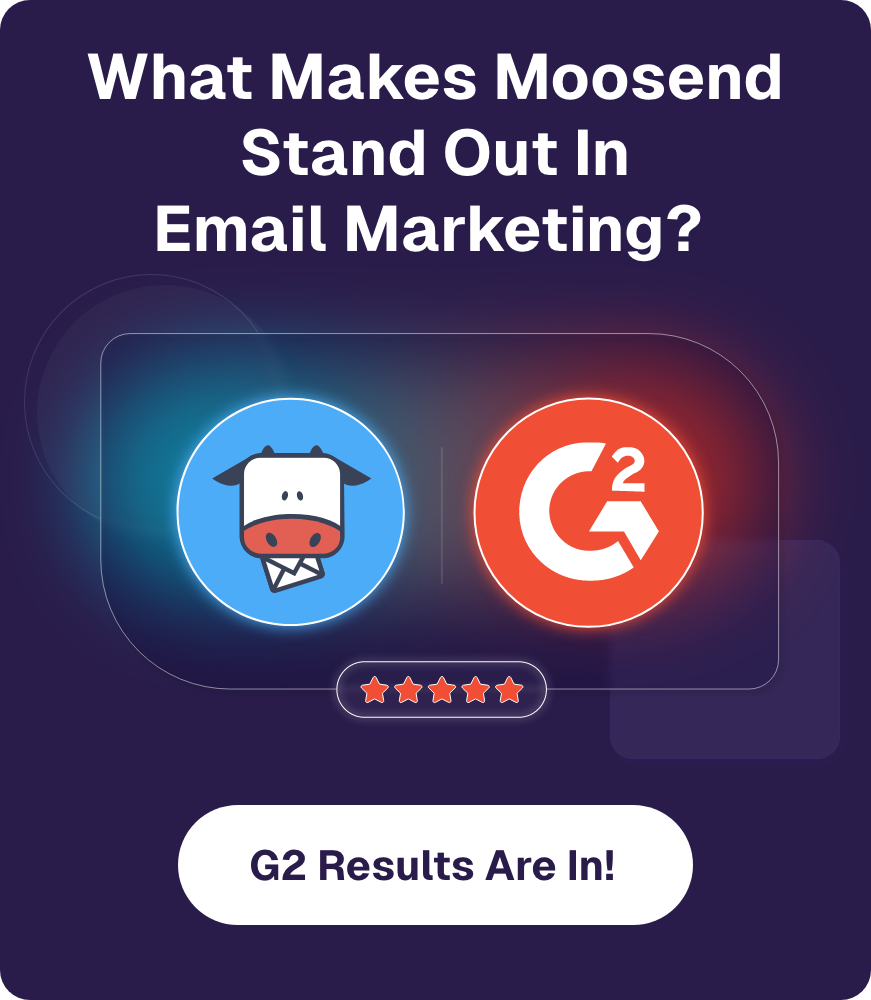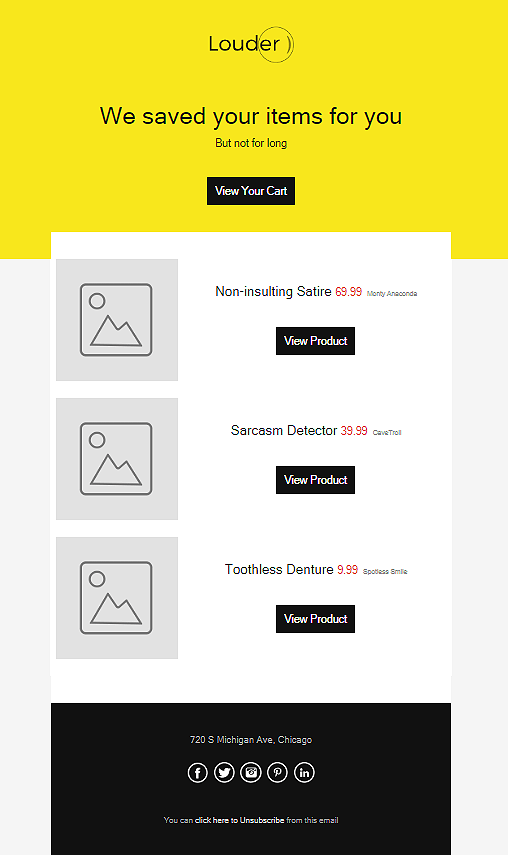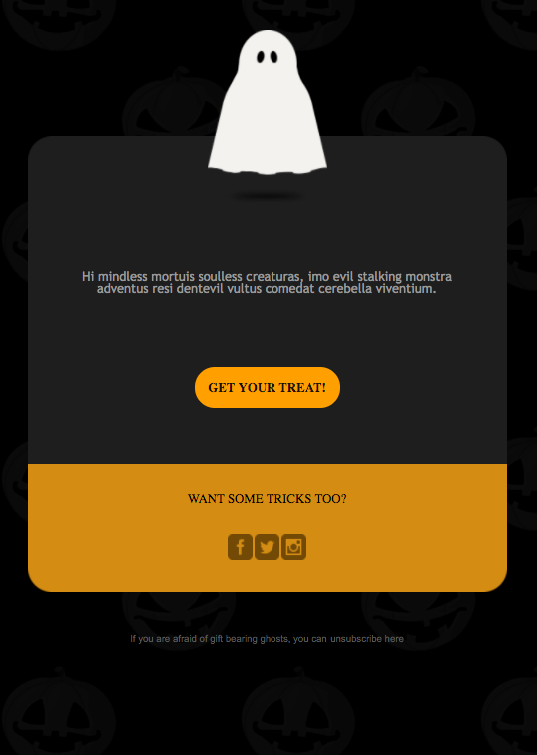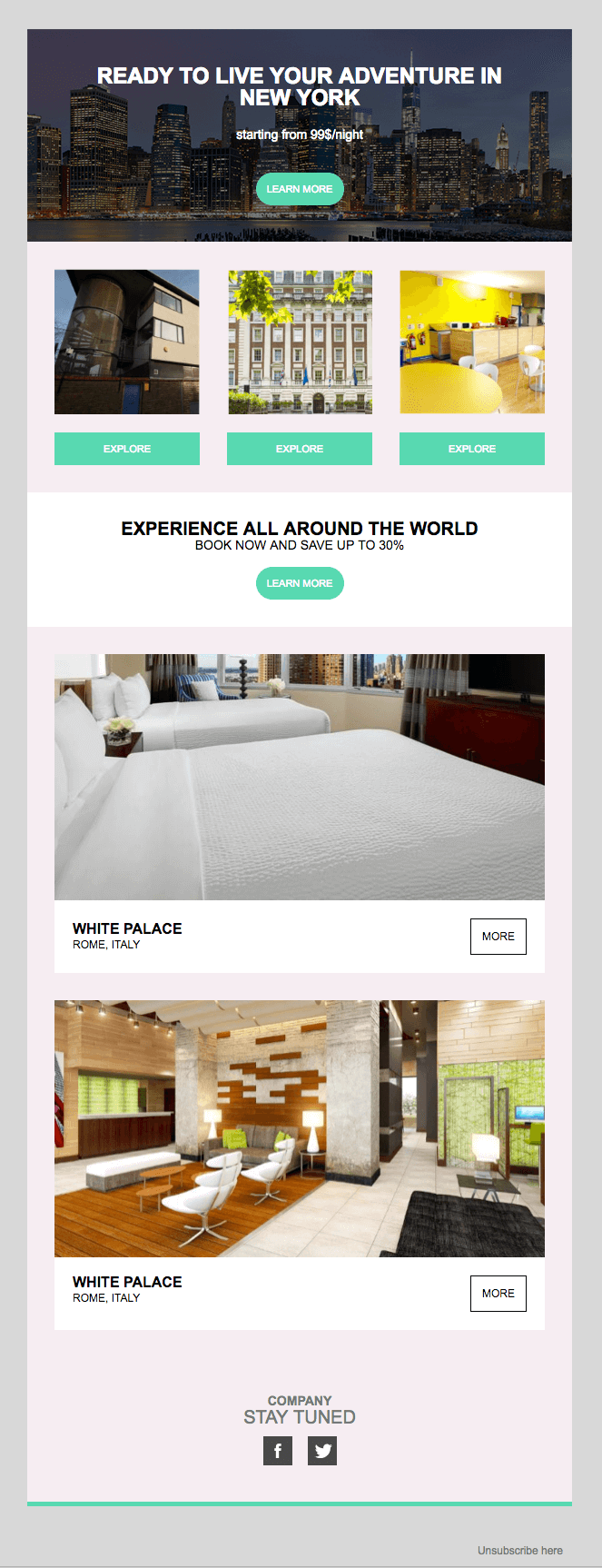Retail marketing isn’t just about having great products. It’s about getting them in front of the right people, at the right time, with the right message. That’s where smart tools like Google Merchant Center and email marketing come into play.
If you’re running an online store, you probably already know the power of Merchant Center for listing your products across Google. But here’s the thing: the data you collect there doesn’t have to stay in a silo. It can actually help you build better email campaigns.
In this post, we’ll break down what Merchant Center is, what kind of data it tracks, and how recent updates (including new reporting features introduced in April 2025) give you more detailed insights. More importantly, we’ll show you how to turn that data into action, creating targeted email campaigns that drive more clicks, more conversions, and more sales.
What is Google Merchant Center?
Google Merchant Center is a free platform that helps you upload and manage your store’s product information, so it can appear across Google’s services like Google Search, Shopping ads, YouTube, and more.
In simple terms, it’s where you submit your product details (titles, prices, images, availability, etc.) so Google can show them to potential customers when they search online. It’s especially useful if you run ads through Google Shopping, since it feeds product data directly into your campaigns.
Merchant Center also connects with other tools like Google Ads and Google Analytics, giving you valuable insights into how your products are performing, including how often they’re viewed, clicked, and purchased.
For retailers, this platform isn’t just about visibility. It’s a way to keep your product info accurate across Google, run smarter campaigns, and understand what’s driving results.
How Does Google Merchant Center Work?
Setting up Google Merchant Center is easy, even for beginners. Here’s how it works, step by step.
1. Set up your Merchant Center account
Sign up using a Google account. If you already have a Gmail address or a Google Business Profile, you can use that to get started. Otherwise, you’ll need to create one.
2. Provide information about your online shop
The next step is to provide Google with some information about your online business. This includes a valid physical address, a customer support contact number, your store’s domain, and a secure checkout process.
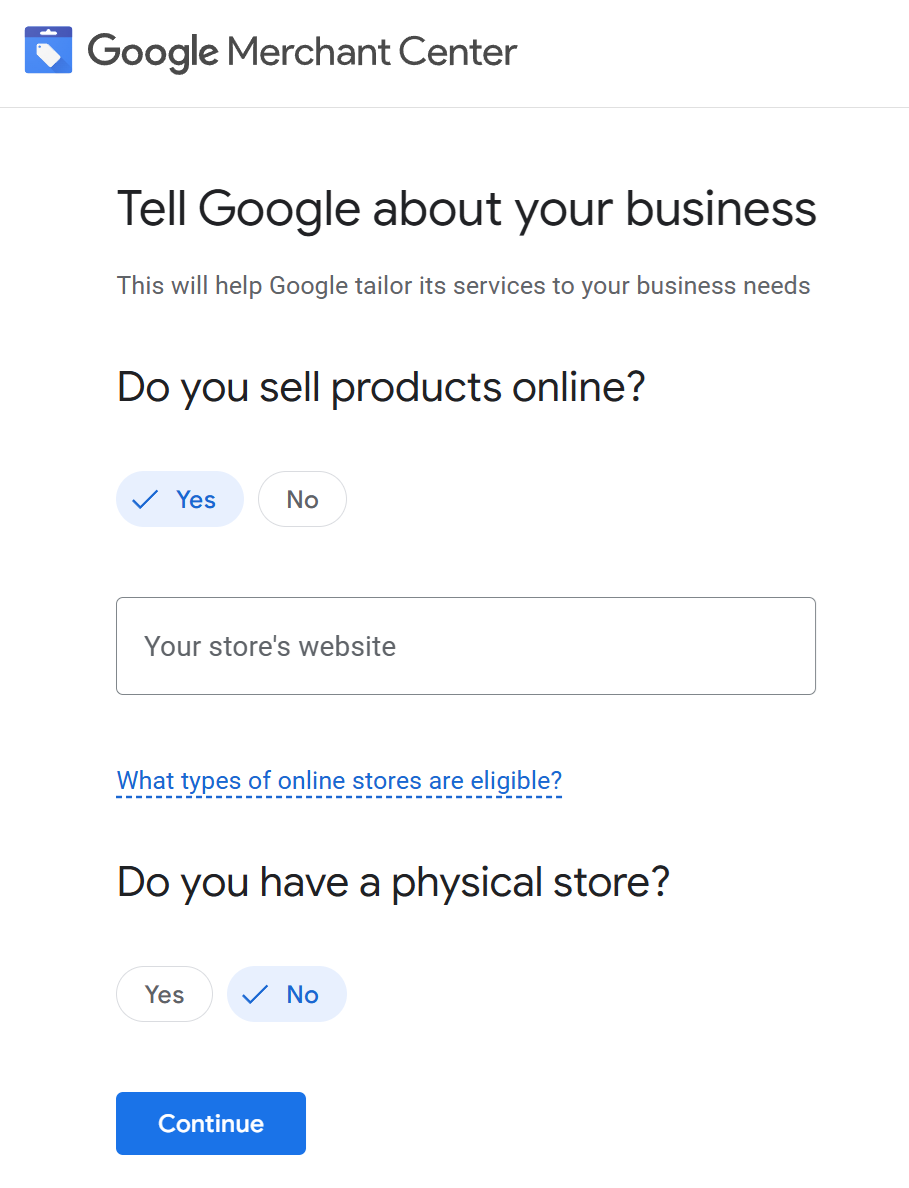
3. Add product data in a way that Google understands
Now you can start providing information about your products. Essential details about each product are: a unique product ID, title, a link to the product on your website, pricing, and shipping information.
This data must be in a format Google accepts, such as TXT or XML files exported from Excel. Alternatively, you can add product details using a Google Sheets spreadsheet.
There is also the option to sync all data via integration with your ecommerce platform, e.g., by connecting to your Shopify store.
Once your product data is in, Google reviews it to make sure everything meets their guidelines. If all looks good, your products will be eligible to show up in places like Google Shopping results and ads.
Benefits of Using Google Merchant Center
With Merchant Center, retailers can create a more complete marketing strategy. Let’s see what makes it especially valuable:
- Greater product visibility: Merchant Center helps your products appear across Google properties like Shopping, Search, and YouTube, where millions of people are actively browsing and buying.
- Real-time product accuracy: Inventory, pricing, and availability can be updated automatically. This reduces the risk of showing out-of-stock items or outdated pricing, improving trust and user experience.
- Better ad performance: When combined with Google Ads, Merchant Center powers high-performing Shopping campaigns with rich product data that’s more likely to convert.
- Data you can act on: It highlights what’s working and what needs improvement. You can see which products get attention and which ones are underperforming.
- Stronger cross-channel marketing: By syncing Merchant Center data with your email marketing or analytics tools, you can build more relevant, personalized campaigns across channels.
Recent Changes and How They Affect Email Marketing
While some recent changes in Google Merchant Center (like the retirement of the Email Archive feature on June 25th) may not directly impact your day-to-day strategy, others bring exciting new opportunities you can act on right away.
One of the most useful updates is the introduction of a unified reporting dashboard. Now, you can view impressions, clicks, and conversions side by side, with filtering options by product type, brand, or campaign. This makes it much easier to spot trends and create targeted email segments based on what is actually working.
But the most significant change for marketers? Google’s new “Marketing Content Usage” feature, introduced in April.
This update automatically opts merchants into a program that allows Google to extract promotional content from your marketing emails, just like it crawls and indexes websites, to boost visibility across Search, Shopping, and other Google services.
The types of content Google may extract include:
- Sales promotions (upcoming or current)
- New product announcements
- Social media links
- Highlighted social content
- Images and videos
What does this mean for your email marketing strategy?
- Dynamic ad generation: Google can use your email content to automatically generate relevant ads, keeping your promotions fresh without extra work.
- Increased reach: Google doesn’t rely only on your website anymore. By using your email marketing content, it can access up-to-date details about your products, offers, and announcements, giving your business more visibility across its ecosystem.
- Control over the content: Although you’re opted in by default, you can choose to opt out if you prefer not to share email content with Google.
With these changes, Google Merchant Center is becoming more integrated with your marketing ecosystem. Let’s explore how to turn these features to your advantage.
How to Combine Merchant Center with Email Marketing
As we saw before, Google Merchant Center’s recent updates provide opportunities for marketers to improve their targeting and increase sales. Here’s how:
1. Use strategic messaging
Now that Google can extract promotional details directly from your marketing emails, your messaging needs to be more intentional.
For example, if your email announces a sale or special offer but doesn’t clearly state when it ends, Google won’t know either. This can confuse or even frustrate shoppers who see expired offers in your ads.
To avoid that, be crystal clear in your emails, especially in the footer or near the CTA.
What to include:
- Sale or promo start and end dates
- Any important restrictions or exclusions
- A clear mention of which products are included
- Consistent brand tone across email, ads, and listings
Here’s an example:
“Don’t miss out! Offer valid until Sunday, June 16 at 11:59 PM.”
These small but essential details build trust with your subscribers and help Google present your products accurately to a wider audience.
2. Craft email campaigns around bestsellers
With Merchant Center’s reporting tools, you can quickly see which products are getting the most clicks, impressions, or conversions across Google platforms. First, you’ll need to go to the performance dashboard in Merchant Center and filter by highest-clicked or top-converting products over the last 7 or 30 days.
Then, build a themed email campaign that highlights these products as popular picks. You can use phrases like “Back by popular demand” or “Shoppers can’t get enough of…”.
To boost conversions, add urgency using low stock alerts and limited-time offers. You can also add social proof or reviews from customers who have already purchased (and loved!) those products.
3. Deliver abandoned product follow-ups
Your Google Merchant Center should ideally be linked to:
- Google Ads (to track Shopping ad clicks)
- GA4 (for on-site behavior)
- Your email marketing platform (like Moosend, Klaviyo, or Mailchimp)
When these systems work together, you can identify visitors who clicked on a Shopping ad but left without converting. These are high-intent users, perfect for retargeting via email.
But how can you capture email addresses after an anonymous ad click?
- Popup forms: Trigger a signup form when someone visits a product page (especially if referred from Google Shopping). Offer a discount, free shipping, or early access.
- Exit-intent offers: Show a form when the user is about to leave the site without buying.
- Gated offers: Require an email to use features like “save to wishlist,” “back-in-stock alerts,” or “price drop notifications.”
4. Use Merchant Center data for seasonal promotions
Your past performance reports show which products performed well during specific seasons. You can use that insight to shape your upcoming email campaigns.
To identify your seasonal bestsellers, head to the Performance tab. This area provides insights into clicks, impressions, conversions, CTR and performance by product, brand, or category.
Use the date picker to select the same period from a previous year—e.g., June 1–July 15, 2024, to analyze last year’s Summer Sale. You can compare it with the current period to spot trends.
Sort by product or category to see what drove the most clicks and conversions. These are your seasonal high performers worth spotlighting again.
Just as important: look for products that underperformed. These may need better descriptions, updated visuals, or different messaging this time around.
5. Create targeted email segments
While Merchant Center can’t build the segments for you, it can provide the intel to make them smarter.
Combine Merchant Center with GA4 data to identify what products or categories a user viewed or clicked on. Then, build segments based on product interest and onsite behavior such as:
- Clicked an ad and visited the product page
- Viewed 3+ items in the same category (e.g., skincare or kitchen appliances)
- Visited a product page but didn’t buy
These users are ideal for retargeting with personalized reminders, testimonials, or discounts to nudge them toward checkout.
Wrapping Up
Combining Google Merchant Center with your email marketing isn’t just a smart move. It’s a competitive advantage. With real-time product insights, improved reporting, and Google’s new ability to use your email content, you have more opportunities to deliver timely, relevant messages that convert.
If you haven’t already, audit your current setup. Is your Merchant Center connected to Google Ads and GA4? Can your email platform pull in product or behavioral data? Identifying and closing these gaps can open the door to more powerful, automated campaigns.
Start small by testing a product-based trigger like a price drop alert or a back-in-stock email. Then track the results. You’ll likely find that when your messaging reflects what people are actually browsing, clicking, and considering, engagement follows naturally.
You’ve got the data. Now it’s time to put it to work.
When it comes to email marketing for eCommerce, Klaviyo and Mailchimp are two of the most popular choices. Both platforms offer powerful tools to help online stores grow their customer base, drive repeat purchases, and boost their revenue. But despite certain similarities, they take a different approach to how they support eCommerce brands.
Klaviyo positions itself as a data-driven solution built specifically for online retailers, while Mailchimp has a broader appeal, catering to a wider range of business types. For eCommerce merchants, understanding how these platforms compare in terms of automation, AI functionality, email deliverability, and customer support is key to making the right choice.
In this Klaviyo vs Mailchimp comparison, we explore the key differences between the two, highlight their strengths and limitations, and provide a clear side-by-side comparison to help you decide which platform is the best fit for your online store.
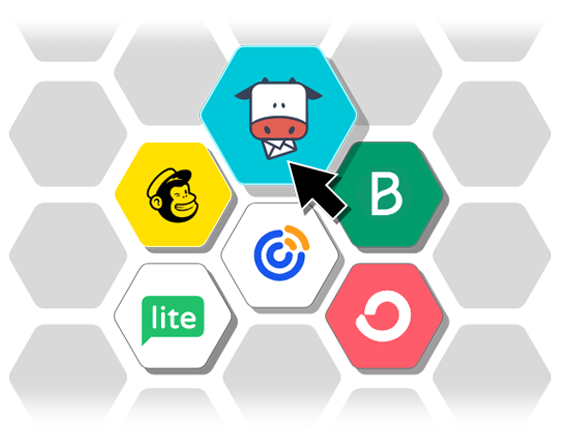
Save $$$ of your marketing budget by switching to Moosend today!
Klaviyo vs Mailchimp: Feature Comparison
Here’s a quick overview of our comparison:
- Klaviyo has deep eCommerce functionality with advanced automation, real-time segmentation, and revenue-focused analytics.
- Mailchimp provides a broader, more beginner-friendly toolset with flexible design features and general marketing capabilities.
| Klaviyo | Mailchimp | |
| Free plan | Yes (limited) | Yes (limited) |
| Pricing | $20/month (500 contacts – 5,000 emails) | $13/month (500 contacts – 5,000 emails) |
| Best for | eCommerce | eCommerce, Publishers, SMBs |
| Email tools | 119 pre-made templates, A/B testing, Advanced segmentation | 137 pre-made templates, Content studio, A/B testing |
| Marketing automation | Advanced | Advanced |
| Reporting & Analytics | Extensive | Extensive |
| Signup forms | Yes | Yes |
| Landing pages | No | Yes |
| SMS marketing | US, CA, UK, IE, DE, FR, AUS, NZ, AT, ES, CH, NL, DK, FI, NO, SE, IT, PT, BE | US only |
| Integrations | 360 | 335 |
| Customer support | 3/5 | 3.5/5 |
| AI features | AI generation for email subject lines and email content, AI generated flows and segments, Predictive analytics, A/B testing automation | AI content generation for email (beta), Subject line helper, AI-generated automations (beta) |
Now let’s see more details about each category.
Setup & Ease of Use
Klaviyo:
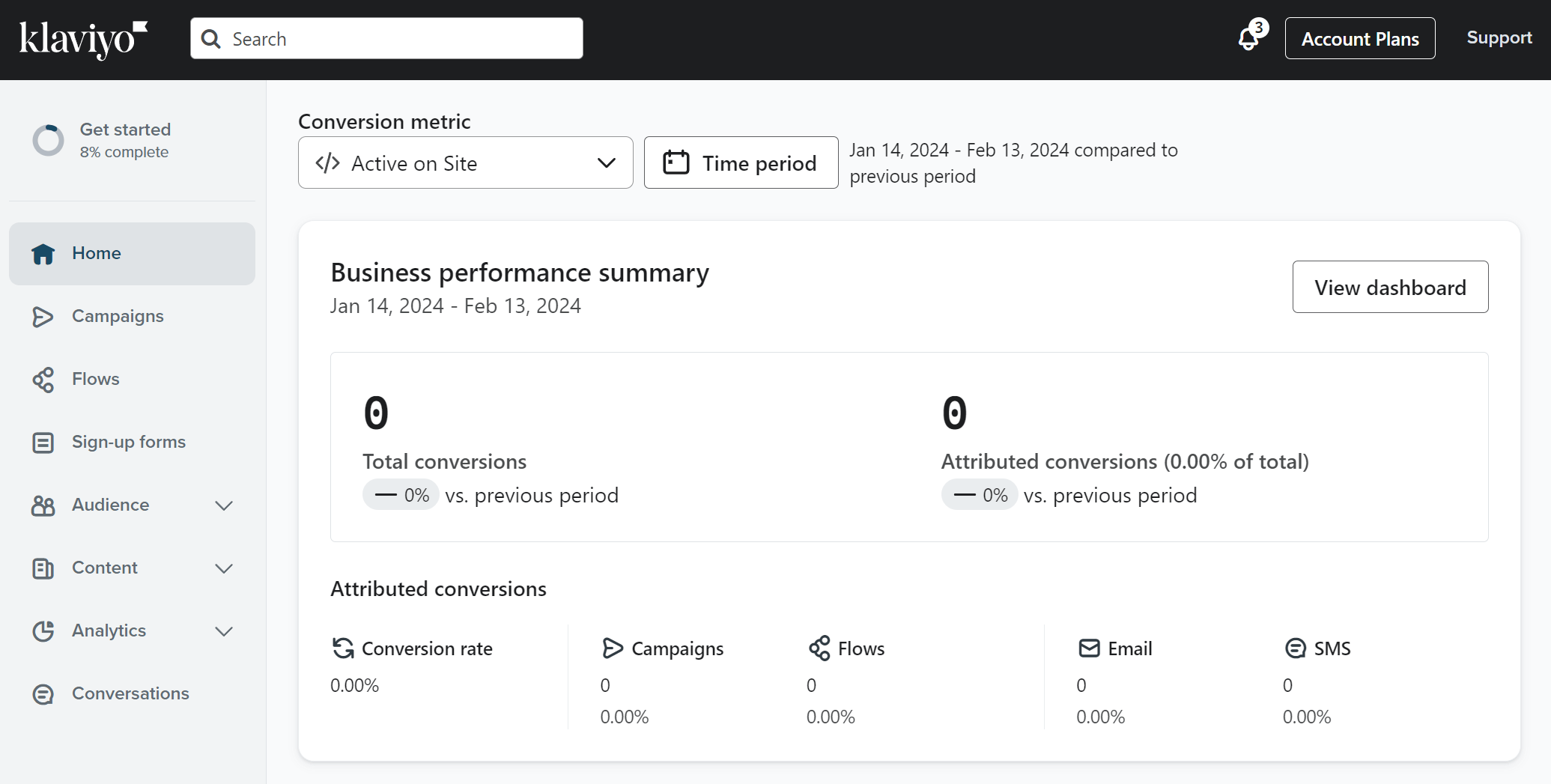
Klaviyo is built specifically for eCommerce, so setting it up starts with connecting your online store. It comes with deep integrations with platforms like Shopify, WooCommerce, BigCommerce, and Magento, and many of its features, like segmentation, product feeds, and revenue tracking, depend on this connection. Because of that, setup can be slow, especially for beginners.
The dashboard looks clean, but it can feel overwhelming at first because there’s a lot going on. That said, once you get familiar with the layout, it’s easy to create campaigns, build automations, and review analytics.
We also found that Klaviyo’s setup guides and onboarding documentation are helpful, but not as beginner-friendly as other platforms. If you’re new to email marketing or don’t have a technical background, expect a learning curve.
Still, the tradeoff is access to granular control and powerful features from the start, which is particularly valuable for eCommerce marketers who want more than just the basics.
Mailchimp:
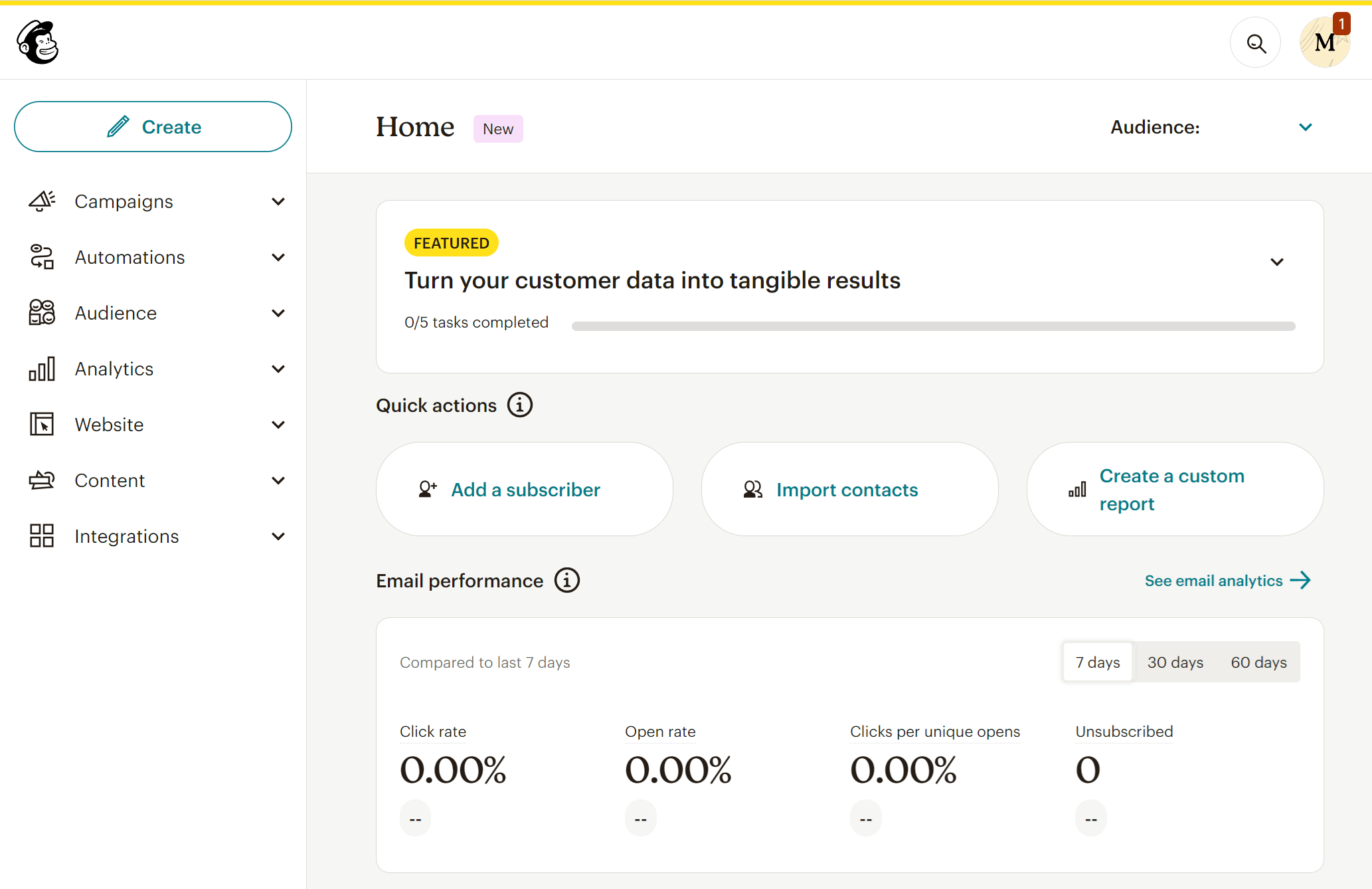
Signing up for Mailchimp is quick, and the platform provides a helpful onboarding flow that prompts users to define their goals, import contacts, and explore basic features like campaigns and automations.
For eCommerce users, Mailchimp integrates with platforms like Shopify (via third-party tools), WooCommerce, BigCommerce, and Squarespace. However, some of these integrations, especially Shopify, are not as seamless as what Klaviyo offers. You can sync product and customer data, but often you’ll need extra apps or workarounds to unlock all the features.
The dashboard is clean and well-organized, with a prominent “Create” button that lets users quickly launch a campaign, automation, or landing page. Once you get familiar with where things are, it’s pretty straightforward.
Still, the experience isn’t perfect for eCommerce users. Key tools like forms and landing pages are in separate sections and can be hard to find if you’re new to the platform. Additionally, Mailchimp doesn’t focus on eCommerce-specific features. You’ll find fewer built-in prompts for setting up revenue-based automations or product triggers unless you explore them manually.
That said, if you don’t want to dive deep into eCommerce data from the start, you’ll find that Mailchimp is easier to learn than Klaviyo. It’s a solid choice for smaller online stores or businesses that sell across multiple channels and want a flexible, general-purpose email platform.
Winner: Mailchimp takes the lead here, especially for new users. However, larger eCommerce brands may find its integrations and data handling less robust than Klaviyo’s.
Email Builder
Klaviyo:

Klaviyo’s email builder is robust and clearly tailored to eCommerce businesses. It uses a modern drag-and-drop interface with a flexible content block system, making it easy to create emails that match your brand. You can send dynamic product recommendations, add personalized content, and run A/B tests—great for boosting sales.
One standout feature is the Product Block, which automatically pulls product images, names, and prices from your store. You can even filter products by category or show items based on what customers viewed or added to their cart, making emails feel more personal.
In our testing, we found the editor intuitive and responsive. It includes mobile previews, undo/redo functionality, and version history, which is helpful for complex campaigns. However, Klaviyo doesn’t have as many pre-built content blocks as other competitors, which might limit creativity.
Another strength is Klaviyo’s integration with brand assets. You can store logos, color palettes, and fonts to ensure design consistency across emails. Overall, it may not be the flashiest editor, but it’s efficient and built for personalized, data-driven marketing.
Mailchimp:

Like Klaviyo, Mailchimp’s email builder is drag-and-drop, with a clean and responsive interface. You can choose from a wide range of content blocks like text, image, video, buttons, product recommendations (if your store is connected), and even surveys.
With the Product block, you can feature items or auto-fill products, although this functionality isn’t quite as dynamic or customizable as Klaviyo’s. If you use Shopify, you’ll also be able to send product review requests.
Mailchimp’s builder includes a handy “Creative Assistant” that can generate designs based on your brand’s colors, logo, and style. This feature is useful for smaller eCommerce teams without in-house designers, although you’ll still need to manually adjust the results.
Another useful feature we found was the Content Studio. It stores all your images, files, and brand assets in one place. this way, you can easily reuse content for different campaigns, like seasonal sales or product launches.
The main downside of Mailchimp’s email editor is that there is no built-in version history. This can be a problem if multiple people are working on the same email.
Winner: Tie! Both email builders are great at creating eye-catching newsletters, no matter how experienced the user is.
Templates
Klaviyo:
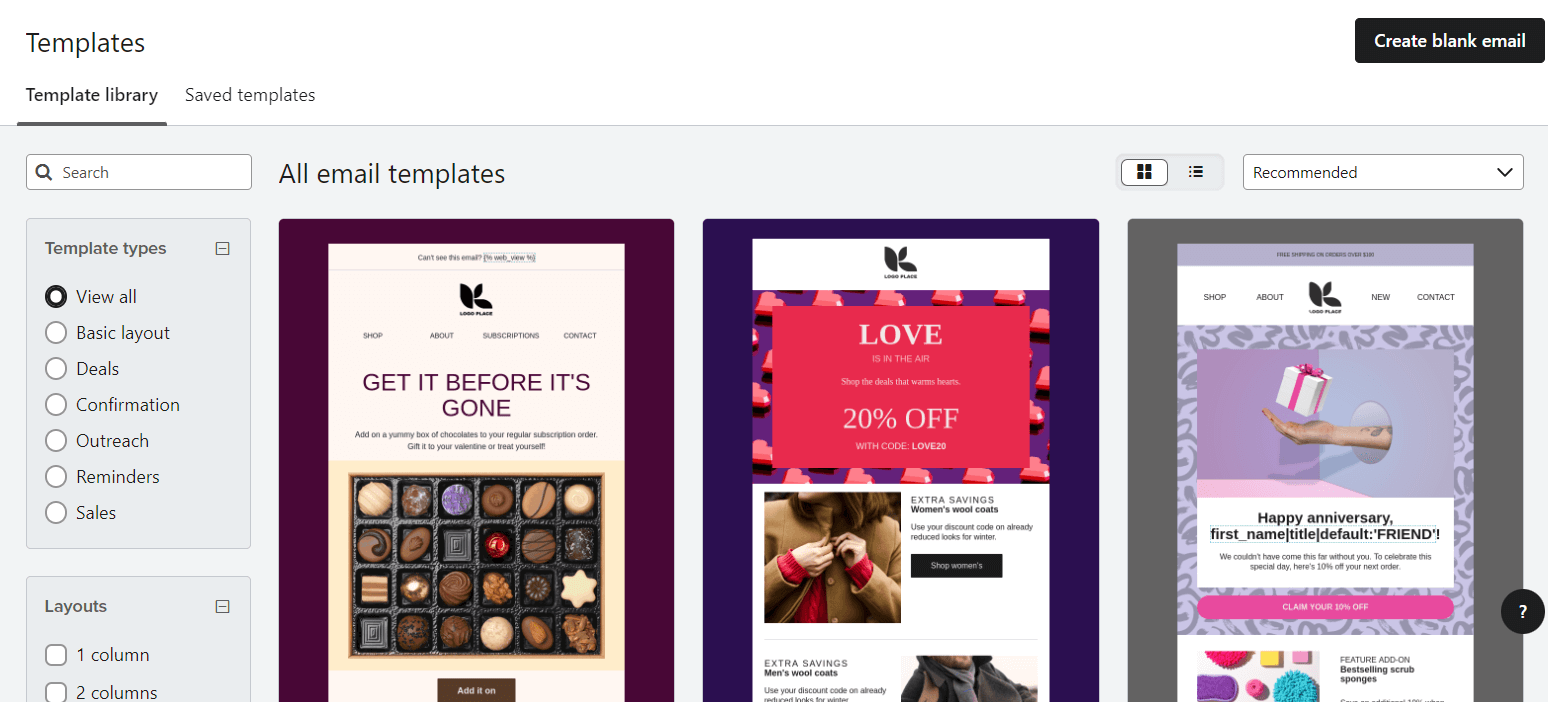
Klaviyo offers a decent collection of email marketing templates. Specifically, we found 110 aesthetic designs and 9 simpler ones. They can cover various goals such as sales, reminders, order confirmation, and deals. Overall, the quality is great, so eCommerce brands can quickly set up campaigns by customizing them.
These templates are also mobile optimized and highly customizable. This means you won’t need any HTML coding knowledge.
You can also effortlessly add brand assets such as logos, fonts, colors, etc. However, you’ll need to set them up in your account first before using them in your emails.
Mailchimp:
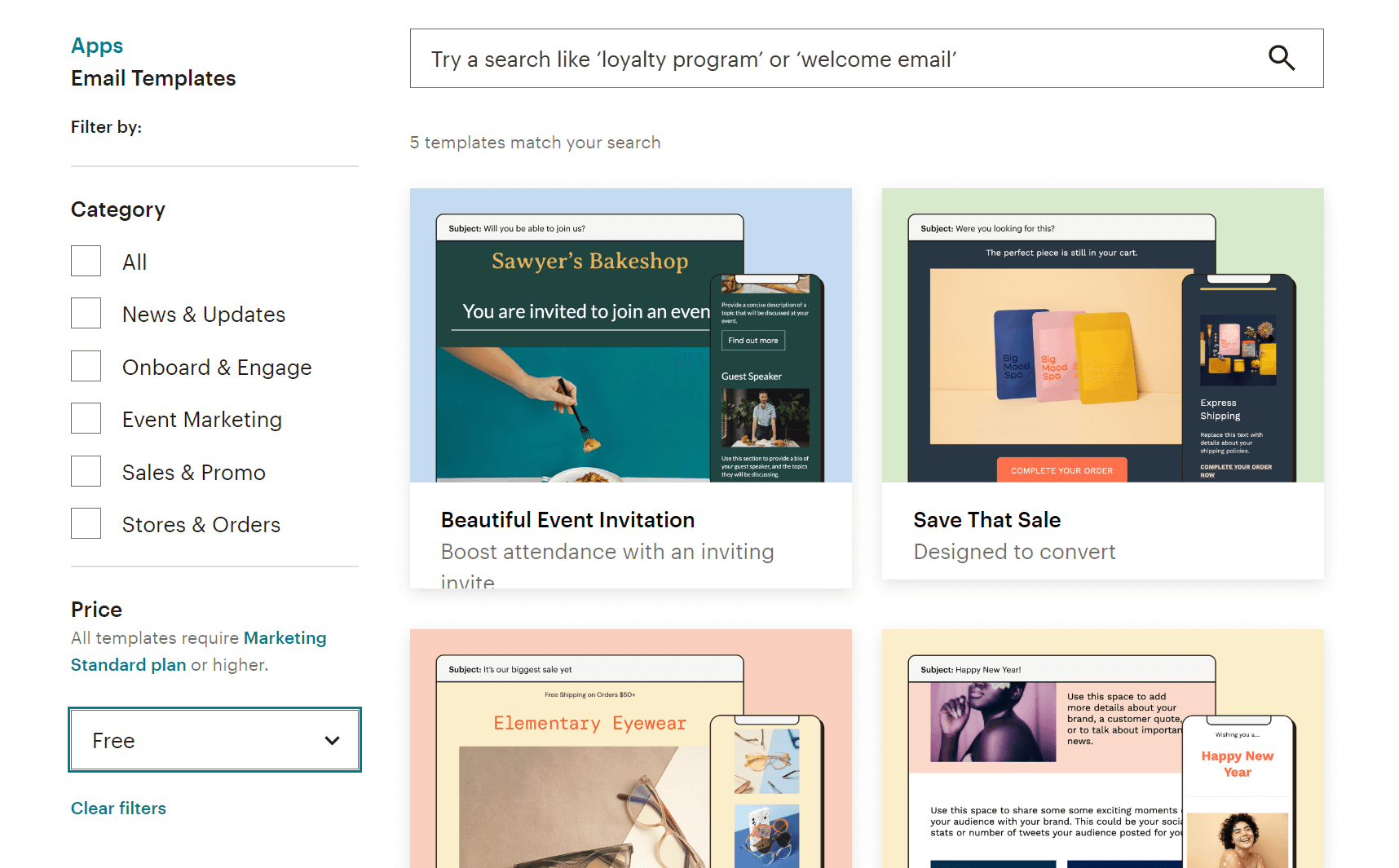
Mailchimp has an equally impressive library of email marketing templates. Its 135+ professionally designed newsletter templates are categorized for easier navigation. For instance, you can find designs for sales and promotions, order confirmation, onboarding, holiday messages, and company updates.
If you’re more advanced, you can also create custom HTML templates via code, a URL, or a ZIP file.
On the free plan, however, you only get access to 8 basic templates. To unlock the full library, you’ll need a paid plan. For eCommerce users, this limitation can be frustrating, especially when just starting out.
Overall, Mailchimp’s template library is broad and visually diverse, which is a plus for marketers who value design flexibility
Winner: Mailchimp. While Klaviyo’s templates are better optimized for data-driven, eCommerce-focused campaigns, Mailchimp offers better design variety and quick customization.
Marketing Automation
Klaviyo:
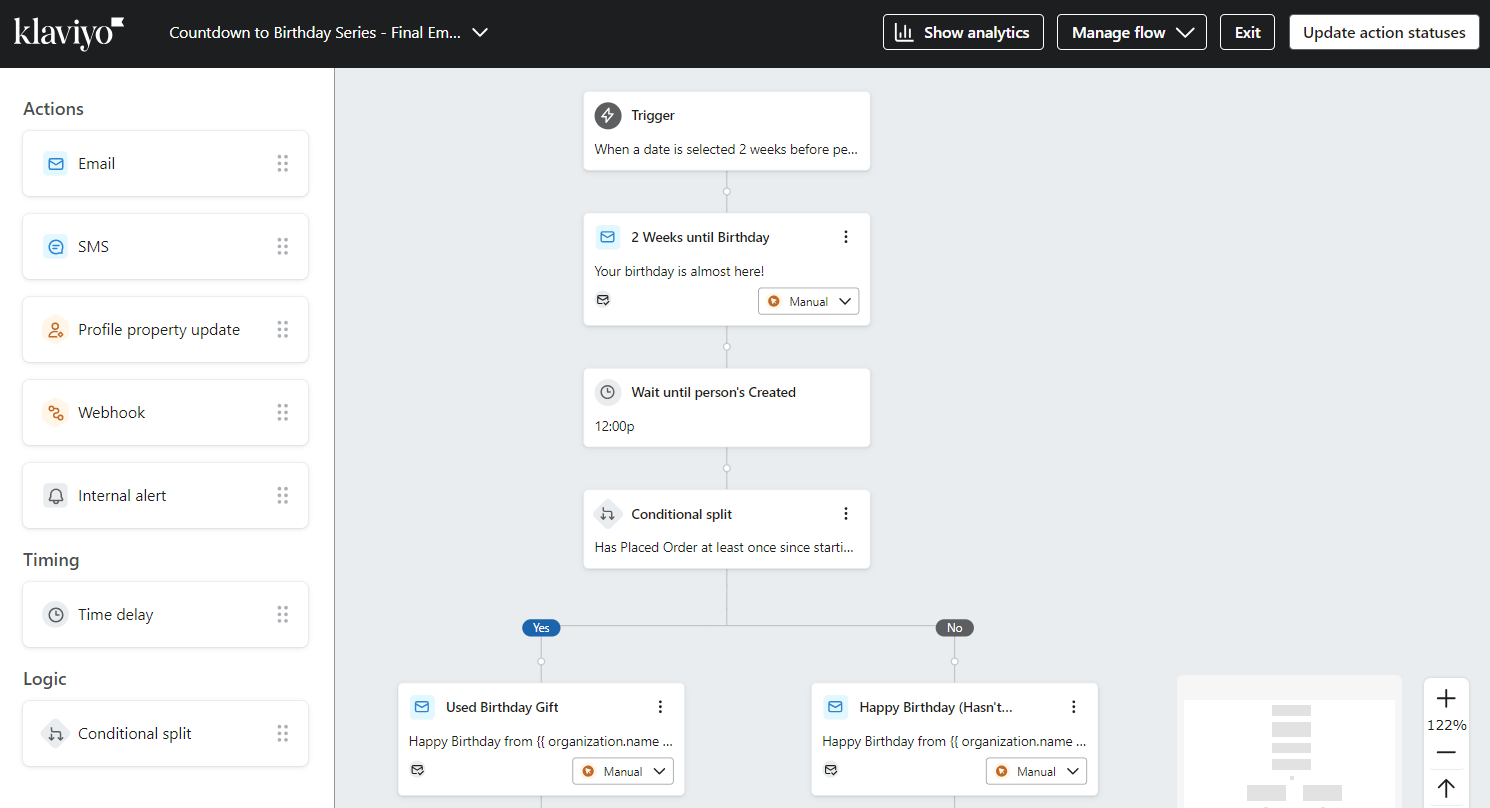
Automation is one of Klaviyo’s biggest strengths. Its powerful visual flow builder lets you create fully customized customer journeys based on real-time actions. Automations are called “flows,” and they include a wide range of 60+ pre-built options like abandoned cart, welcome series, post-purchase, product browse abandonment, and win-back sequences.
What sets Klaviyo apart is its deep data integration with eCommerce platforms. You can trigger emails based on highly specific customer actions, e.g., viewed a product, placed an order, added to cart, canceled a purchase, joined a segment, and much more. Flows can also include conditional logic, delays, splits, A/B testing, and multichannel elements like SMS and mobile push notifications, all within the same automation.
What’s also nice is that every part of the workflow is transparent. You can see how many recipients are in each stage and track performance by open rate, click-through, and revenue generated.
A new feature, “Flows AI,” functionality, makes setup even faster. You simply describe what you want, and Klaviyo’s AI creates the structure for your entire flow.
Mailchimp:
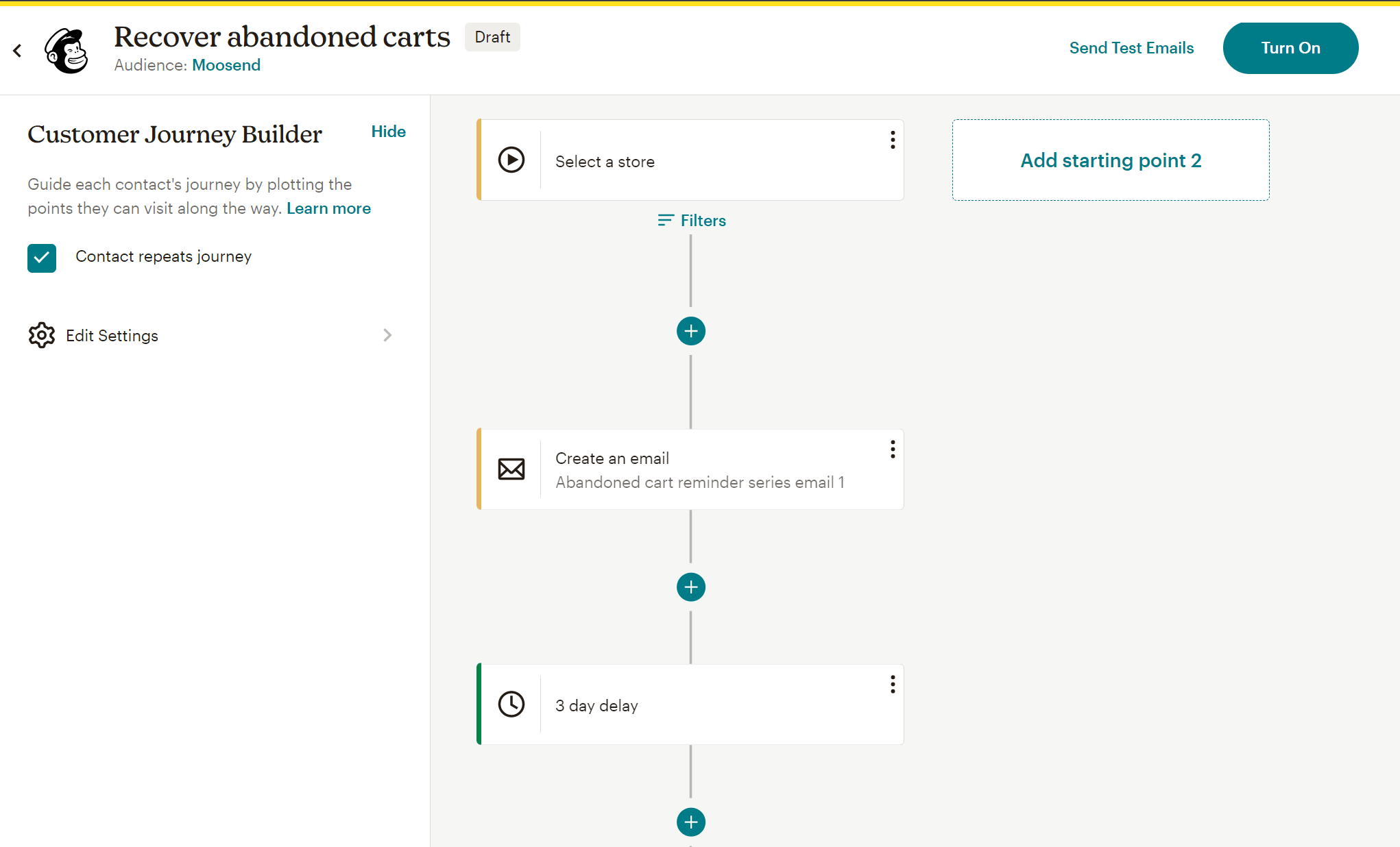
Mailchimp comes with a powerful visual workflow editor called Customer Journey Builder. It lets you create simple and sophisticated automated sequences using triggers like signup, email activity, or basic purchase behavior.
You’ll find over 100 pre-built automations, including welcome emails, order notifications, and limited post-purchase flows. However, most of these automations are email-only. SMS and transactional messaging require third-party integrations, and there’s no native support for push notifications.
Mailchimp includes branching logic and A/B testing within automations, but it lacks the depth of behavioral triggers found in Klaviyo. For example, you can’t easily set up a browse abandonment flow based on a specific product page view unless additional tracking is set up manually.
Winner: Klaviyo wins this round. Its automation features are more advanced, more customizable, and far better suited for eCommerce.
List Management
Klaviyo:
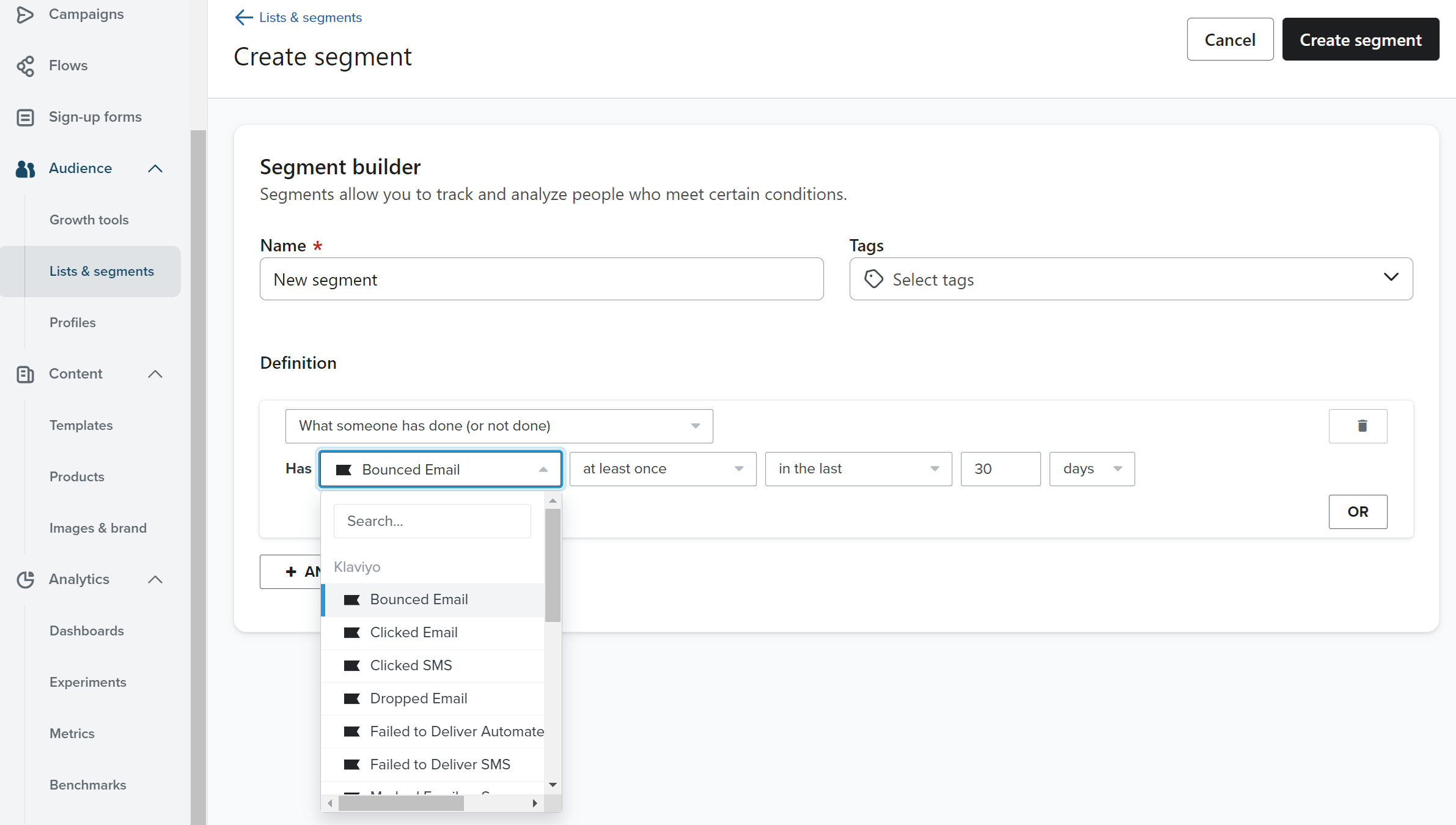
We found that Klaviyo’s segmentation is a strong asset for eCommerce brands. You can use data from your store (like purchase history, product views, average order value, or time since last purchase) to build real-time segments. These segments update dynamically as customer behavior changes, and there’s no limit to how many you can create.
You can segment customers based on:
- Behavioral triggers (viewed product, added to cart, placed order)
- Predictive metrics (churn risk, next order date)
- Demographics and custom fields
- Engagement (email opens, clicks, inactivity)
Klaviyo’s lists are static and good for controlled sending (e.g., welcome series), while segments are dynamic and ideal for automations and targeting high-value shoppers.
Another helpful feature: Klaviyo estimates Customer Lifetime Value (CLV) and shows lifecycle stages, helping you identify loyal customers, slipping buyers, or one-time shoppers and trigger messaging accordingly.
Mailchimp:

Mailchimp offers a good range of list management tools, but it works differently from Klaviyo. You can manage contacts using Audiences (lists), and if the same contact appears in multiple audiences, you’re charged multiple times. This is a major drawback for growing eCommerce brands.
Segmentation is done through:
- Tags (manual labels)
- Groups (subscriber-managed categories)
- Segments (based on behavior or profile data)
You can segment by purchase activity, campaign engagement, demographics, and location. With the right integrations, you can segment by product interest or cart abandonment, too, but these features are limited on the free and Essentials plans.
Compared to Klaviyo, Mailchimp’s segmentation lacks real-time updates and granularity. Also, the UI for managing audiences, tags, and segments can be confusing for new users, especially when scaling campaigns across product lines.
Winner: Klaviyo wins this round thanks to its real-time, behavior-based segmentation and deep eCommerce integration.
Reporting & Analytics
Klaviyo:

Klaviyo’s reporting is deeply tied to eCommerce performance, making it easy to track not just email metrics but real revenue impact. The dashboard gives you immediate insight into how much money each campaign, flow, or automation generates, along with standard KPIs like open rates, click rates, and conversion metrics.
Key analytics features include:
- Revenue attribution per campaign and flow
- Product performance reports
- A/B testing for both campaigns and flows
- Custom report builder (on higher plans)
- Predictive analytics (CLV, churn risk, next order date)
You can drill down into individual customer profiles to see how they interact with your brand, which campaigns influenced their purchases, and where they are in the customer lifecycle.
What sets Klaviyo apart is how seamlessly this data connects to segmentation and automation, allowing you to act on insights immediately, rather than just look at numbers. It’s a great tool for data-driven marketers.
Mailchimp:

Mailchimp offers clear, easy-to-use reports with all the basics, like open rates, clicks, bounces, unsubscribes, and email engagement over time. You can also compare how different campaigns perform with its comparative report feature.
For eCommerce users, Mailchimp shows:
- Basic sales tracking (if your store is connected)
- Product-level reporting
- Revenue from individual campaigns
However, its revenue attribution isn’t as precise or detailed as Klaviyo’s. You can track total revenue generated, but it’s harder to understand how specific campaigns or automations influence customer behavior over time.
Overall, Mailchimp’s reporting is more focused on campaign-level insights, rather than the full eCommerce journey.
Winner: Klaviyo. It is built to tie every campaign and automation back to revenue.
Forms & Landing Pages
Klaviyo:
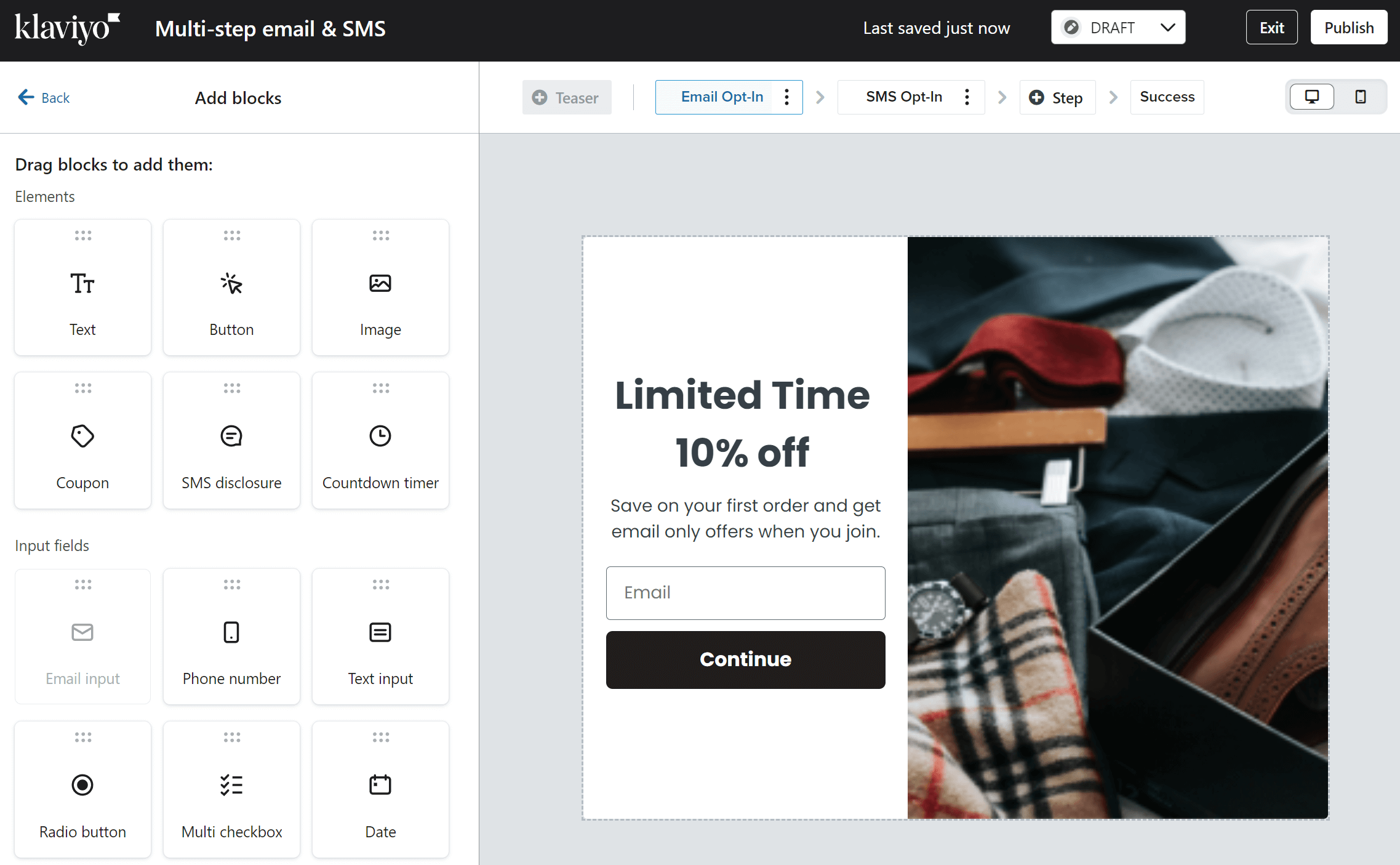
Klaviyo offers various customizable forms designed specifically for eCommerce lead generation. You can build popups, flyouts, embedded forms, as well as full-page forms. These are triggered by behavior (e.g., exit intent, scroll depth, time on page) and can include targeted messaging based on URL, device type, or user location.
Forms are fully customizable and support conditional logic. This allows merchants to tailor messaging to different segments, such as showing a discount popup to first-time visitors and hiding it from returning customers.
Klaviyo also supports multi-step forms, useful for gathering detailed information without overwhelming users upfront. Plus, any form can directly trigger an automation flow, like a welcome series or cart reminder.
The main drawback? Klaviyo doesn’t offer a landing page builder. While you can create “pages” using hosted forms, these are basic and primarily used for email capture. You won’t find advanced landing page features like product blocks, multi-column layouts, or checkout support.
Mailchimp:
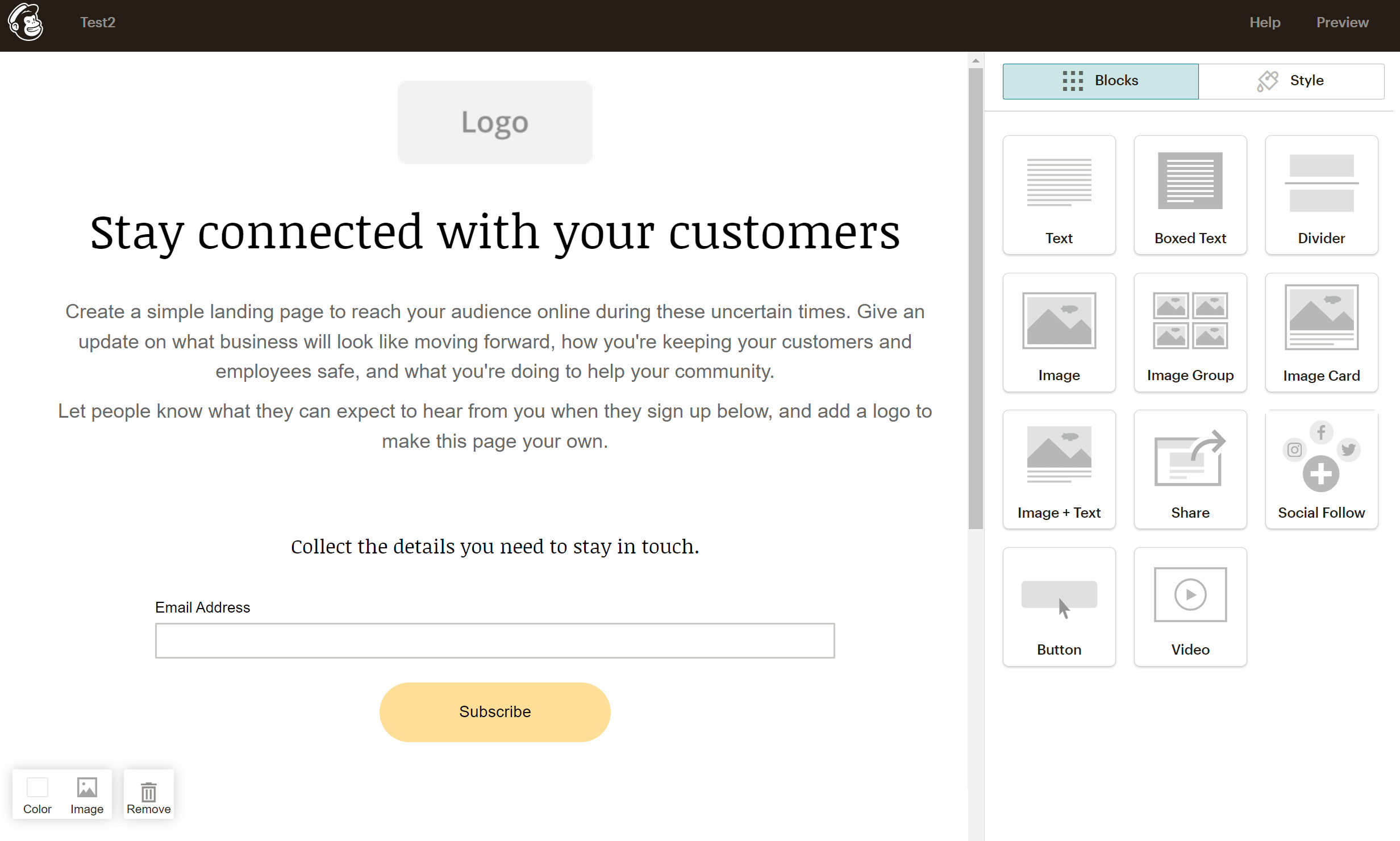
Mailchimp has both a form and a landing page builder tool, ideal for users seeking built-in versatility. With Mailchimp, you can build embedded signup forms, pop-up forms, contact forms, and full-featured landing pages.
The drag-and-drop landing page builder is easy to use and lets you design standalone pages for promotions, product launches, or lead generation campaigns. You caneven include buy buttons or product recommendations if your store is connected.
Mailchimp also supports GDPR-friendly forms, conditional fields, and social sharing options. While the form builder itself looks quite basic, it’ll cover most of your needs.
One limitation is that deeper behavioral targeting in forms requires manual setup, and the platform doesn’t support multi-step forms natively. Still, Mailchimp is a strong choice if you want to run quick promotions or grow your list through standalone pages.
Winner: Despite Klaviyo’s form targeting and segmentation being more advanced, Mailchimp is a more complete solution.
Klaviyo vs Mailchimp: Integrations
Klaviyo:
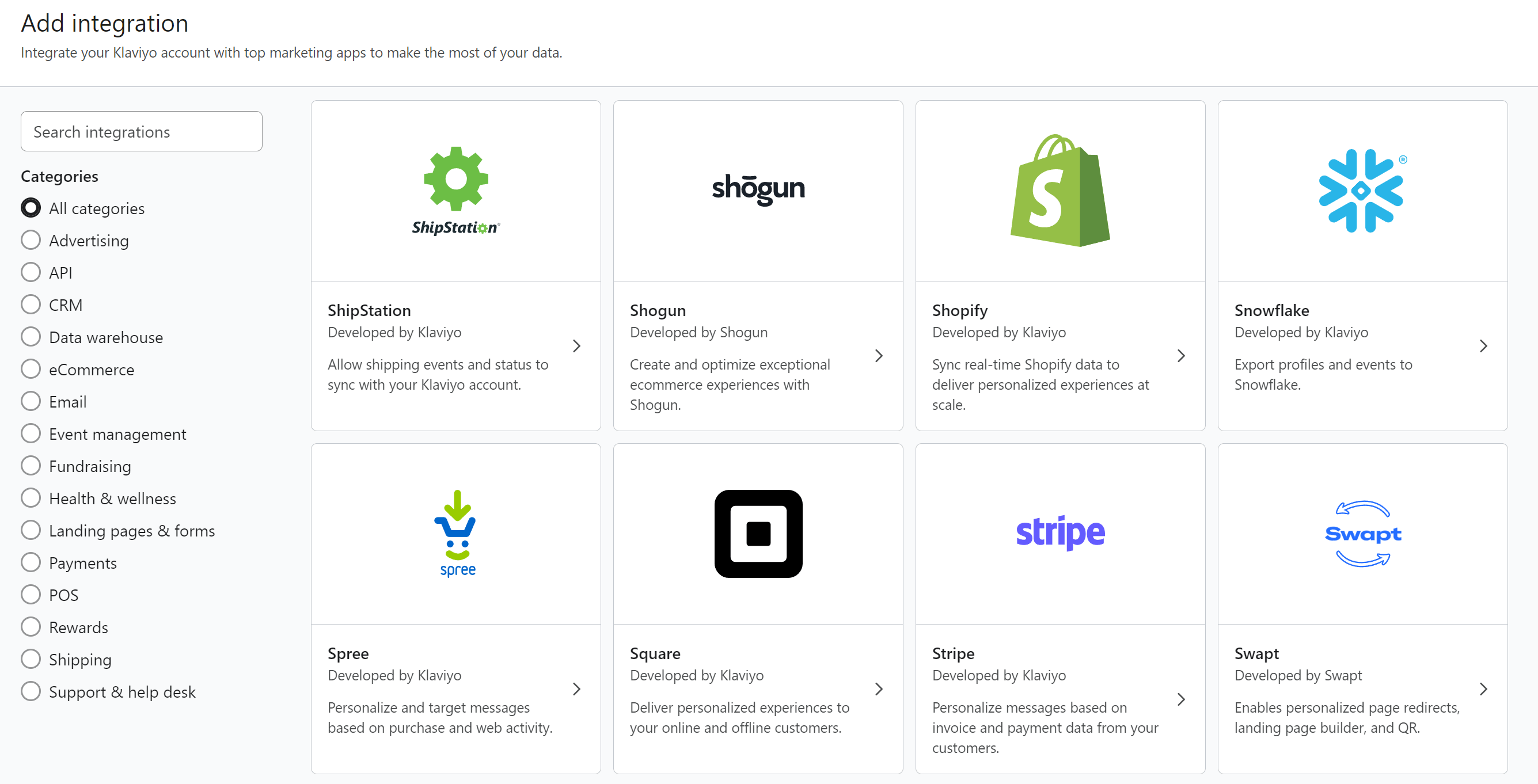
This eCommerce email marketing service offers more than 360 integrations. It connects natively with platforms such as Shopify, BigCommerce, WooCommerce, Magento, and Salesforce Commerce Cloud. Its Shopify integration stands out because it allows Klaviyo to sync customer profiles, order history, product catalogs, and behavioral data in real time.
Beyond these, Klaviyo integrates with tools for subscriptions, loyalty programs, user-generated content, and SMS marketing. For example, it integrates with services like Recharge, Smile.io, and Yotpo. These integrations don’t just transfer data; they enhance it, allowing for personalized, performance-driven marketing campaigns.
For brands with more complex needs, Klaviyo also supports custom API integrations and works well with Zapier and webhooks, offering flexibility for technical teams.
Mailchimp:
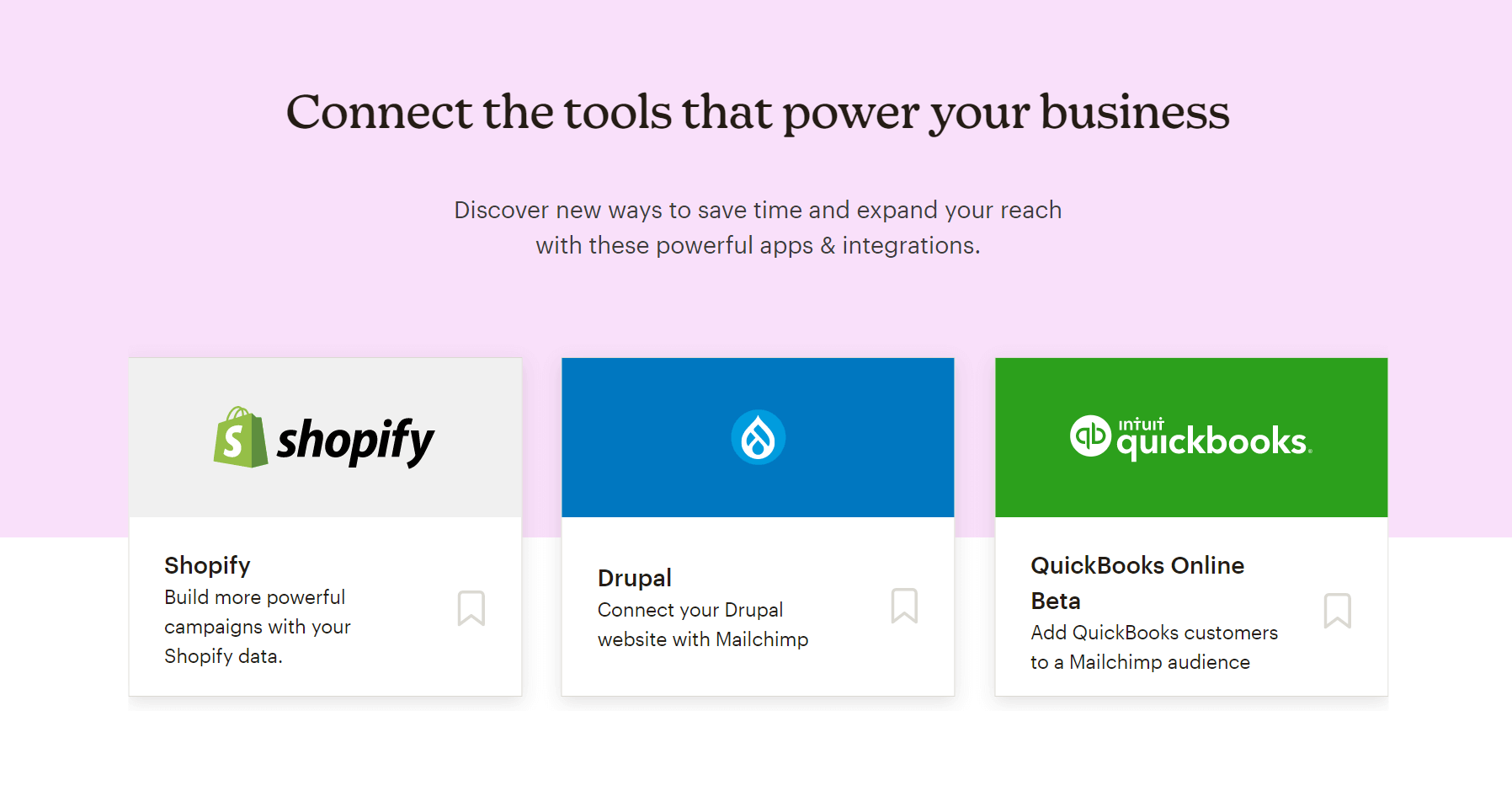
Mailchimpoffers over 330 integrations across categories like eCommerce, CRM, accounting, surveys, and social media. It works well with WooCommerce, BigCommerce, Squarespace, Stripe, QuickBooks, Salesforce, and many more.
However, the native integration with Shopify was discontinued, and users now have to rely on third-party solutions like ShopSync. This added step weakens the connection and can limit access to critical eCommerce features such as real-time product syncing or personalized product blocks.
While Mailchimp offers a broad list of integrations, the integration with eCommerce tools is limited. Mailchimp can sync basic data like purchase history or cart activity, but it lacks the behavioral triggers and real-time customer insights that Klaviyo is built around.
Winner: Klaviyo. Its integrations are built not just to connect, but to enrich customer data and power more sophisticated targeting and automation.
Klaviyo vs Mailchimp: Customer Support
Klaviyo:
This eCommerce email marketing platform offers a comprehensive help center with guides, tutorials, and webinars that cover both basic setup and more advanced strategies. For direct assistance, you can use Klaviyo’s live chat (Monday to Friday, business hours) and email support (7 days a week). However, free plan users only get email support for the first 60 days.
What stands out is the quality of Klaviyo’s support for eCommerce-specific issues. Their agents are generally knowledgeable about integrations with platforms like Shopify and BigCommerce, and can troubleshoot issues with data sync, automation flows, and performance tracking. While there’s no phone support, we found the chat responses quick and helpful. Larger businesses on custom pricing plans can also get a dedicated account manager.
Mailchimp:
Mailchimp’s support varies significantly depending on your pricing plan. Free users only get email support for the first 30 days. Then, they must rely on self-service resources like the help center and tutorials. Paid plans unlock additional support channels. Specifically, Essentials and Standard users get 24/7 email and live chat, while Premium users also get phone support and priority access.
While Mailchimp’s knowledge base is detailed and covers most features, many users report that wait times can be long, particularly during high-demand periods. Additionally, for eCommerce-specific questions, such as issues with third-party integrations or automation setup, Mailchimp’s support tends to be more general than Klaviyo’s.
Winner: Klaviyo. Their support team seems more equipped to handle eCommerce-related issues.
Klaviyo vs Mailchimp: Pricing
Now let’s compare the pricing of the two competitors.
Klaviyo:
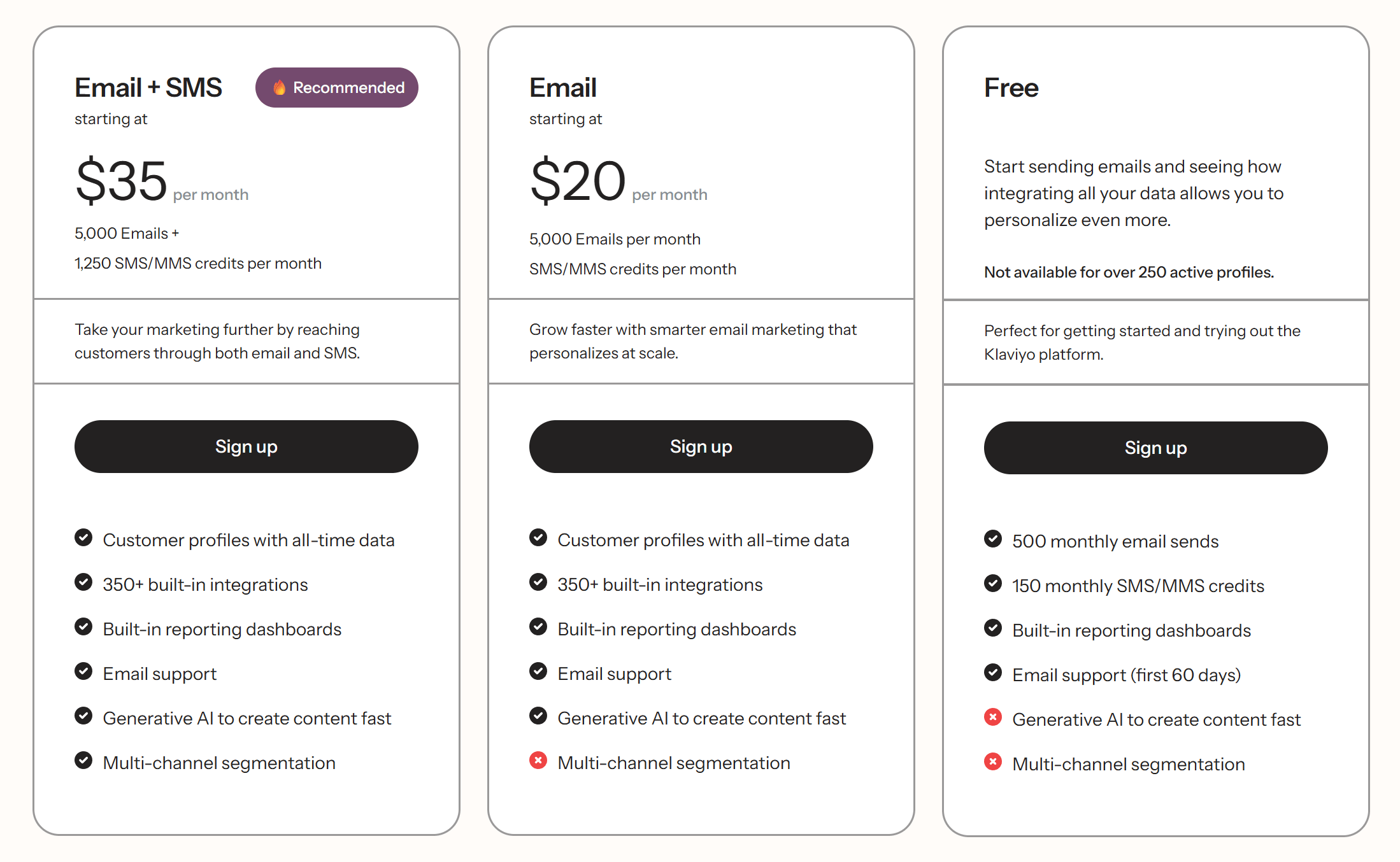
Klaviyo’s pricing is based on the number of active contacts, with both email and SMS options available. The free plan includes up to 250 active profiles and 500 monthly email sends, along with access to basic features like automation, segmentation, and forms.
Paid plans start at $20/month for up to 500 contacts, with pricing increasing as your list grows. SMS is billed separately, and you pay for what you use. Klaviyo’s pricing can scale quickly for larger lists, but the value is justified if you’re using its advanced automation, analytics, and revenue-tracking features to drive sales.
Mailchimp:

Mailchimp also offers a free plan, allowing up to 500 contacts and 1,000 monthly sends. However, many useful features such as email scheduling, A/B testing, and advanced segmentation are locked behind paid tiers.
The Essentials plan starts at $13/month for 500 contacts, but you’ll need to move up to Standard or Premium to access more robust automation, dynamic content, and analytics. Mailchimp’s pricing is flexible for basic needs, but eCommerce brands that need advanced features will find it less cost-effective. Additionally, Mailchimp charges for duplicate contacts across different audiences, which can increase your costs as your list grows.
Winner: While Mailchimp might be slightly more affordable for high-volume senders, Klaviyo wins this round due to its straightforward and transparent pricing.
Top Klaviyo and Mailchimp Alternatives
If you’re unsure about Klaviyo and Mailchimp or you want to explore more alternative options, here are the top solutions.
1. Moosend

Pricing: Paid plans start at $9/month, 30-day free trial (Sign up here)
Best Feature: Advanced eCommerce automation with real-time behavior triggers
Moosend is among the best email marketing services for eCommerce businesses, offering a surprisingly robust feature set for its price point. You can use its powerful visual automation builder, advanced segmentation tools, real-time tracking, product recommendation blocks, and landing pages even on lower-tier plans. With its easy-to-use drag-and-drop editor and pre-built automation templates, you’ll quickly send abandoned cart flows, welcome sequences, and post-purchase follow-ups. And with Moosend’s built-in AI tools, you’ll be able to generate copy fast, personalize your campaigns, and build smart segments to boost your sales. At the same time, its robust API will handle all your transactional messages.
Why prefer Moosend: If you’re running an online store and need serious automation and personalization without the high price tag of Klaviyo or Mailchimp, Moosend is a smart choice that balances performance and affordability.
2. ActiveCampaign
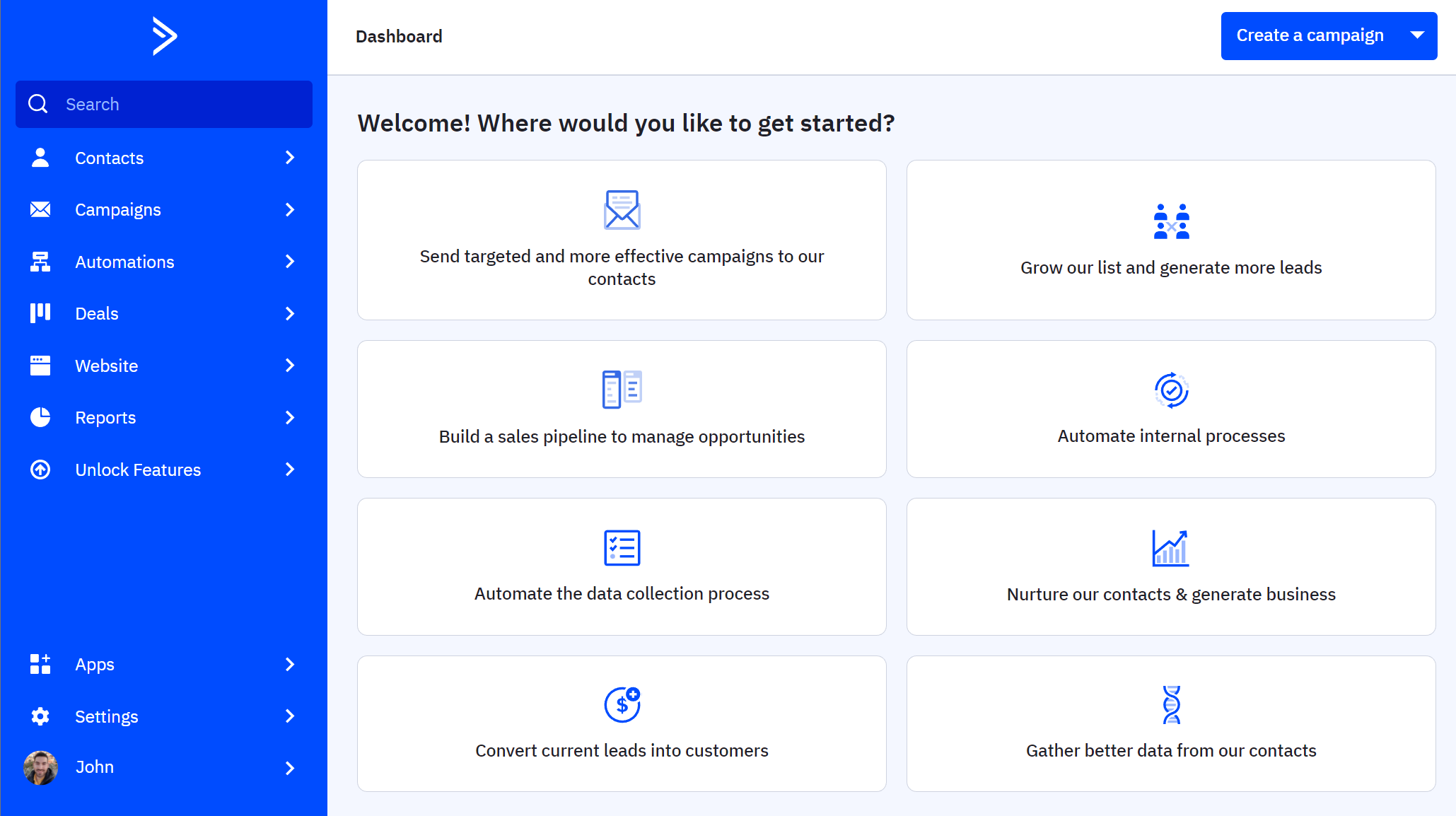
Pricing: Paid plans start at $19/month, 14-day free trial
Best Feature: Deep automation workflows with built-in CRM
ActiveCampaign combines email marketing, sales automation, and CRM features into one system. For eCommerce users, ActiveCampaign offers behavioral tracking, conditional content, dynamic email blocks, and multi-channel automation across email, SMS, and site messaging. The platform’s Automations Map gives you a full visual overview of your customer journeys, very helpful for larger teams or complex workflows. You also get a vast library of pre-made automation journeys to kickstart your email strategy. While it has a steeper learning curve than Mailchimp or Moosend, the tradeoff is great control and customization.
Why prefer ActiveCampaign: You need advanced customer journeys or want to build complex automations across multiple channels.
3. Omnisend

Pricing: Paid plans start at $16/month, free plan
Best Feature: Omnichannel automation with email, SMS, and push notifications
Omnisend is purpose-built for eCommerce combining email marketing, SMS, and push campaigns. Its visual automation builder is highly intuitiveand lets you design sophisticated workflows triggered by shopping behavior, cart activity, and lifecycle stages. It includes a robust selection of pre-built templates, gamified signup forms, and dynamic product recommendations. Unlike many tools, Omnisend allows users to blend multiple channels within a single automation flow, improving engagement and customer retention.
Why prefer Omnisend: You want to unify your messaging across email, SMS, and push without using multiple tools.
Additional Resources to Check
Here are a few resources to expand your reading:
Klaviyo vs Mailchimp: The Takeaway
Both Klaviyo and Mailchimp are great email marketing platforms, but they serve different needs. If your priority is fast campaign creation with flexible design tools and you’re not heavily reliant on behavioral data, Mailchimp is a better fit. But if you’re running a growing online store and want a platform that works seamlessly with your product catalog, automates based on customer behavior, and clearly ties marketing actions to revenue, Klaviyo is the stronger long-term investment.
The best way to decide is to test both platforms using their free plans and see which one aligns best with your business goals and workflow.
Think July is all sunshine and slow sales? Well, think again.
Between Black Friday in July, mid-summer blowouts, and unique awareness occurrences like Plastic Free July, this month can easily be one of the busiest on your marketing calendar.
So, don’t wait until your audience is off on vacation to show up in their inbox.
In our July email marketing planner, you’ll find email ideas for every major event, real-life campaign examples, and easy-to-edit templates to help you launch quickly and confidently.
Plus, explore key do’s and don’ts to keep your July campaigns clear, impactful, and ready to drive results.
July Email Planner Overview: What to Send
Compared to other months, July has more all-month events to target.
This means you can set up different sequences for your audience and maintain high engagement with promotions, storytelling, and awareness messages.
Here are the key dates and monthly themes to add to your email marketing calendar:
- Mid-Summer Sales: All month
- Plastic Free July: All month
- Travelling Season: All month
- Black Friday in July: All month
- Christmas in July: All month
- US Independence Day: July 4
- International Kissing Day: July 6
- World Chocolate Day: July 7
- National Give Something Away Day: July 15
- Self-Care Day: July 24
Now let’s create some smart, seasonal, and fun email campaigns for each of them.
1. Mid-Summer Sales
People may be in vacation mode, but that doesn’t mean they’ve stopped buying. In fact, mid-summer is the perfect time to move seasonal stock, introduce limited-time bundles, or tease upcoming launches.
Let’s see how to make the most of your summer email marketing below.
Email campaign: For optimal results, combine sales with helpful summer tips to keep the content fresh and engaging.
- Buy more, save more: Bundle products to increase average order value (AOV) without resorting to deep discounting. Just make sure you pair complementary products.
- Loyalty perks: Give your email list early access or exclusive codes. You can even run a 2x loyalty points event for every sale made in July.
- Seasonal spotlight: Highlight your top-performing summer products with reviews or use cases.
- Summer tips: Provide tips relevant to your product. For example, if you sell sunscreen, show your audience how to choose the right one for them or what SPF means.
When to send: Start early in July with teasers and keep the momentum going throughout the month. You can also run weekend-only flash sales with countdown timers.
Subject lines: Keep your summer subject lines fun and direct. You can use emojis like suns, waves, cocktails, and palm trees to make them stand out in the inbox.
- Summer Adventure Flash Sale! (Solo Stove)
- ☀️ SUMMER’S BEST DEALS ☀️ (Clarks Shoes)
- Tips for taking great summertime photos! (Nikon)
Email copy: Be clear about what’s on sale and for how long. Use urgency but without pressure. Also, include summer-specific language, such as “sun-ready,” “heatwave deals,” “poolside picks,” or “vacay must-haves,” to make your message feel timely and relevant.
Visuals: This is the time to use bright, seasonal colors (yellows, blues, oranges). Add lifestyle photos of people enjoying summer or flatlays of your products in seasonal settings.
CTAs:
- Shop the Sale
- Hot Summer Deals
- Summer Steals Await
Example: HEM
Hem’s “Last Chance” July email marketing campaign is an excellent example of a clean, effective mid-summer campaign.
The design features bold, seasonal colors and a poolside image to set the summer tone instantly. The copy is concise and to the point, creating a sense of urgency without coming across as pushy.
Phrases like “save until midnight tonight” and “additional 10% off” make the offer clear and compelling. The CTA is simple and stands out due to the color contrast.
Overall, the email strikes a balance between urgency and ease, demonstrating that a successful mid-summer campaign doesn’t require much. Simply add summer-inspired visuals, a clear message, and a focused call-to-action.
Subject line: Final chance to save up to 40%

2. Plastic Free July
Plastic Free July is your chance to show your audience that your brand is committed to meaningful change.
Regardless of your industry, you can use this opportunity to highlight sustainable practices, inspire small swaps, and encourage mindful habits.
When to send: Kick off in early July with your mission or pledge. Then, continue with eco tips, challenges, or feature spotlights on a weekly or biweekly basis.
Email campaign: You don’t need to be a sustainability brand to participate. Here are a few meaningful ideas to consider:
- Sustainable spotlight: Feature your low-waste, reusable, or recyclable products. Share how they’re made or how they help reduce plastic use.
- Behind the scenes: Show the steps your brand is taking to reduce plastic, such as shipping changes, supplier choices, or new packaging updates.
- Challenge series: Send weekly tips to help your audience join in (e.g., Week 1: Switch to a reusable bottle and receive a reward).
- Partnerships or pledges: Team up with eco-organizations or launch a brand pledge that subscribers can join.
Subject lines:
- Get our Reusable PLASTIC FREE MUG (GUESS)
- Meet our brand-new, plastic-free Sticker (MOO)
- Ready to go plastic-free this July? (Burt’s Bees)
Email copy: Maintain a positive and empowering tone. Focus on progress over perfection. Share small wins, real examples, and numbers to build trust and encourage action.
Visuals: Use earthy, clean visuals, natural tones, reusable items, and behind-the-scenes shots of packaging or processes.
CTAs:
- Take the Pledge
- See Our Eco Picks
- Join the Challenge
Example: Ettitude
Ettitude’s Plastic Free July email marketing campaign shows you how to keep things simple, helpful, and aligned with your brand values.
The email copy focuses on four easy changes, such as using reusable items and avoiding plastic when traveling, making it feel doable rather than overwhelming.
The visuals are also clean, with earthy tones that support the message. Instead of pushing products, the email offers practical tips and ends with a scholarship initiative, where one lucky student will get $1,000.
Overall, the campaign is informative, visually balanced, and purpose-driven, which makes it perfect for brands looking to join the conversation with value.
Subject line: Working towards a plastic-free world

Further reading: Find out more about sustainability in email marketing in our guide.
3. Travelling Essentials Campaigns
Summer is peak travel season, and your emails should be packed with value just like your audience’s suitcases.
July is a great time to spotlight products that make getaways easier, especially if you’re in the travel and hospitality industry.
Whether it’s a weekend trip or a long-haul adventure, help your subscribers feel ready for takeoff.
Email campaign: Focus on making travel easier, lighter, and more enjoyable.
- Packing guides: Share curated lists featuring your most portable, multi-use, or travel-friendly items. For example, a tech retailer could create a summer email featuring travel-friendly gadgets, such as compact power banks, mini fans, wireless headphones, or even a portable fridge and thermos. It’s a clever way to reframe everyday products as must-haves for road trips, beach days, or weekend escapes.
- Bundle & save: Offer a travel essentials kit, mini bundles at a discounted rate, or even vacation packages.
- Checklist series: Turn weekly emails into a travel prep guide. For example, week 1 can focus on summer skincare, while week 2 covers how to treat a sunburn, and so on.
- User-generated content: Show how your team or customers pack your products on the go. Cross-promote with Instagram or TikTok for extra reach.
When to send: Early July is ideal for targeting pre-trip planners, and mid-month is perfect for last-minute travelers. For hospitality and travel businesses, start your promotions as early as mid-June to ensure success.
Subject lines: You can use emojis to stand out in the inbox, such as suitcases, flip flops, or palm trees.
- Travel Ready! ✈️ NEW Handcrafted Bag Tags (Wendell August Forge)
- Travel Ready Essentials (Natori) Marilia, Your Summer Escape Starts Here
- Marilia, Your Summer Escape Starts Here (Marriott Bonvoy)
Email copy: Make your products sound useful, with phrases like “carry-on friendly,” “lightweight,” “no-fuss travel,” or “travel-friendly faves.”
Visuals: Show your products in travel settings. For example, use suitcases, weekend bags, airport lounges, or scenic backgrounds to make them more exciting and practical.
CTAs: Use vibrant call-to-action colors, such as reds, greens, and yellows, to ensure your subscribers don’t miss them.
- Shop Travel Must-Haves
- Grab the Essentials
- See the Packing List
Example: Burt’s Bees
Burt’s Bees’ travel-themed July email marketing campaign shows you how to turn everyday products into vacation must-haves.
The headline “ready, set, go!” sets a fun, energetic tone, and the bright visuals instantly signal summer and travel.
The copy keeps it light and benefit-driven, emphasizing glow, hydration, and ease. The 20% off promo with code ‘TRAVEL’ is also relevant and hard to miss.
Lastly, the email design is clean, colorful, and designed to make packing feel effortless and rewarding.
Subject line: Travel-friendly must-haves for your next trip.

4. Black Friday in July
Black Friday in July isn’t just a catchy name to boost seasonal sales, but an actual retail movement that began in 2015 with Amazon Prime Day, a mid-summer mega sale for Prime members.
Since then, other brands and retailers have jumped on the bandwagon, turning July into a second Black Friday, complete with deep discounts, flash sales, and urgency-packed campaigns.
Amazon Prime Day doesn’t have a fixed date. It usually falls sometime in mid-July, but the exact days change every year.
Email campaign: Send high-impact emails with deep discounts that match the energy of Prime Day. To make the most of this July email marketing opportunity, set up an automated sequence: start with a teaser to build anticipation, follow up with your main offer, and finish strong with a last-chance reminder.
- Early access or VIP deals: Reward your subscribers with sneak peeks or exclusive discounts.
- 72-hour sale: Run a 3-day event to build momentum and drive sales.
- Cart-based offers: Use dynamic email content blocks to display personalized offers or bonus gifts tailored to customer behavior.
When to send: You can launch right before, during, or just after Prime Day. However, timing is everything, so check Amazon’s site early and get your campaign ready to go.
Subject lines: Like with your Black Friday subject lines, ensure that you use urgency and scarcity while maintaining a valuable message.
- Our Black Friday in July Sale starts now! (HP)
- Black Friday in July = your new favorite holiday 🤩 (Leesa)
- ⭐ E-X-T-E-N-D-E-D ⭐ Black Friday in July Deals (Lenovo)
Email copy: Focus on how much they’ll save, how much time they’ve got, and why it’s worth it. Maintain an energetic vibe throughout to capitalize on the hype of Prime Day.
Visuals: Bold banners, countdowns, and product grids are perfect here. You can also use high contrast and high-energy elements to stand out.
CTAs: Add vibrant colors and actionable copy to guide your customers to action.
- Shop the Sale
- Claim Your Deal
- Go Big This July
Example: HP
HP’s Black Friday in July email has a bold design, clear messaging, and multiple offers.
Copy like “Save up to 70%” and “3 DAYS” builds urgency, while tiered discount codes (SUNSHINE5 and SUNSHINE10) add personalization based on cart size.
The layout is built for scanning, with each product having a benefit-focused tagline, price, and savings callout. This makes it feel like a timed event that’s worth acting on.
The visuals, colors, and CTAs work together to convey a single message: don’t wait, shop now.
Subject line: Black Friday in July, and savings up to 70% off

5. Christmas in July
If there’s something crazier than Black Friday in July that’s Christmas.
Christmas in July is an actual event and a great excuse to surprise your audience. It started as a way for people in the Southern Hemisphere to celebrate a wintery holiday during their actual winter season.
Over time, brands caught on and turned it into a playful mid-year moment packed with off-season deals.
Usually, it’s celebrated on July 25, but you can send multiple campaigns throughout the month.
Email campaign: Go all in on the festive twist and deck the inbox with humor and smart promos. Here are some ideas:
- Summer Santa Sale: Create limited-time offers using snowflakes, gift tags, and faux tree graphics.
- 12 Days of deals: Launch a countdown series with daily surprises or flash sales.
- Holiday rewind: Resurface your best holiday hits (bestsellers, bundles, etc.) with a summer twist.
When to send: Mid-month works best. Kick it off with a “Yes, it’s real” email and follow up with deals or daily drops.
Subject lines: You can use winter or Xmas emojis for a fun twist.
- Merry Christmas (in July) Enjoy 40% Off (Tommie Copper)
- FINAL HOURS: Christmas in July Sale! 🌴☃️ (Meowingtons)
- ☀️➕🎅= Christmas In July Sale (John’s Crazy Socks)
Email copy: Be playful and use the element of surprise as not everyone is aware of “Julymas.” Combine familiar holiday language with summer cues, like “deck the halls with summer deals” or “your mid-year gift rush starts now.”
Visuals: Use holiday graphics with summer elements (beach, sun, surfboards). Picture Santa in shades or a swimsuit to combine summer with Christmas.
CTAs:
- Unwrap the Deal
- Shop the Jolly Sale
- Countdown to Cheer
Example: John’s Crazy Socks
John’s Crazy Socks’ Christmas in July email marketing message stands out for its honesty and heart.
Instead of being salesy, it opens with a genuine reason for the campaign. The tone is warm and personal, with clear, friendly language that feels like a note from a friend.
The offer is simple but positioned as a win-win. Customers save, and the team benefits.
With cheerful visuals and a lighthearted “Merry Christmas in July” message, it spreads joy while showing the reason behind the campaign.
Subject line: Why Christmas in July? 🎅🎁☃️

6. US Independence Day (Fourth of July)
Independence Day, also known as the Fourth of July, is a federal holiday in the United States that commemorates the adoption of the Declaration of Independence on July 4, 1776.
It marks the country’s official break from British rule and the founding of the United States of America. Today, it’s celebrated with fireworks, parades, and cookouts, making it an ideal moment for brands to join in with festive campaigns, patriotic themes, and summer-centered offers.
Email campaign: The Fourth of July is perfect for themed offers. Let’s see some ideas you can use below:
- Stars & savings: Launch a limited-time promo with patriotic flair, including sitewide discounts or bundles tied to the holiday weekend.
- Made in the USA: Highlight locally made products or your brand’s American roots.
- Party prep guide: Share summer recipes, playlists, or entertaining tips alongside featured products.
When to send: Send your first campaign a week before July 4 to tease upcoming offers. Then, launch your main promotional emails closer to the date, ideally over the weekend before the 4th. On the day itself, send a final message with a special offer, a celebratory note, or a commemorative email that honors the meaning of Independence Day.
Subject lines: Add a clear benefit, use specific emojis, and keep your creations short and scannable.
- Fourth of July SPF Picks (Supergoop!)
- Celebrate the 4th with a sale! (Burt’s Bees)
- Happy 4th of July! 🦅 🎉 (Rogue + Wolf)
Email copy: Use festive language with summer words like “grill-ready,” “picnic essentials,” or “celebration sale.” Focus on fun and ease, and celebrate the holiday with your audience. If you’re a non-U.S. business, make sure your message is respectful and historically accurate.
Visuals: This is the time to use bold banners, stars and stripes, fireworks, and outdoor summer scenes to bring the holiday to life. Keep your visuals accessible, on-brand, and easy to scan.
CTAs:
- Celebrate With a Deal
- Shop the Fireworks Sale
- Get Your July 4th Picks
Example: American Giant
American Giant’s Fourth of July email marketing campaign is a great example of how to lead with meaning over marketing.
The focus is on values, like freedom, resilience, and pride in American-made products, rather than flashy visuals or deep discounts. The copy is personal, warm, and reflective, reminding readers what the 4th of July stands for while tying it back to the brand’s commitment to U.S. manufacturing.
By centering the message on community, hard work, and shared identity, the email feels authentic and thoughtful. It’s a reminder that not every holiday email needs to push a sale.
Sometimes, a genuine message builds deeper trust.
Subject line: Wear American Giant with pride 🇺🇸
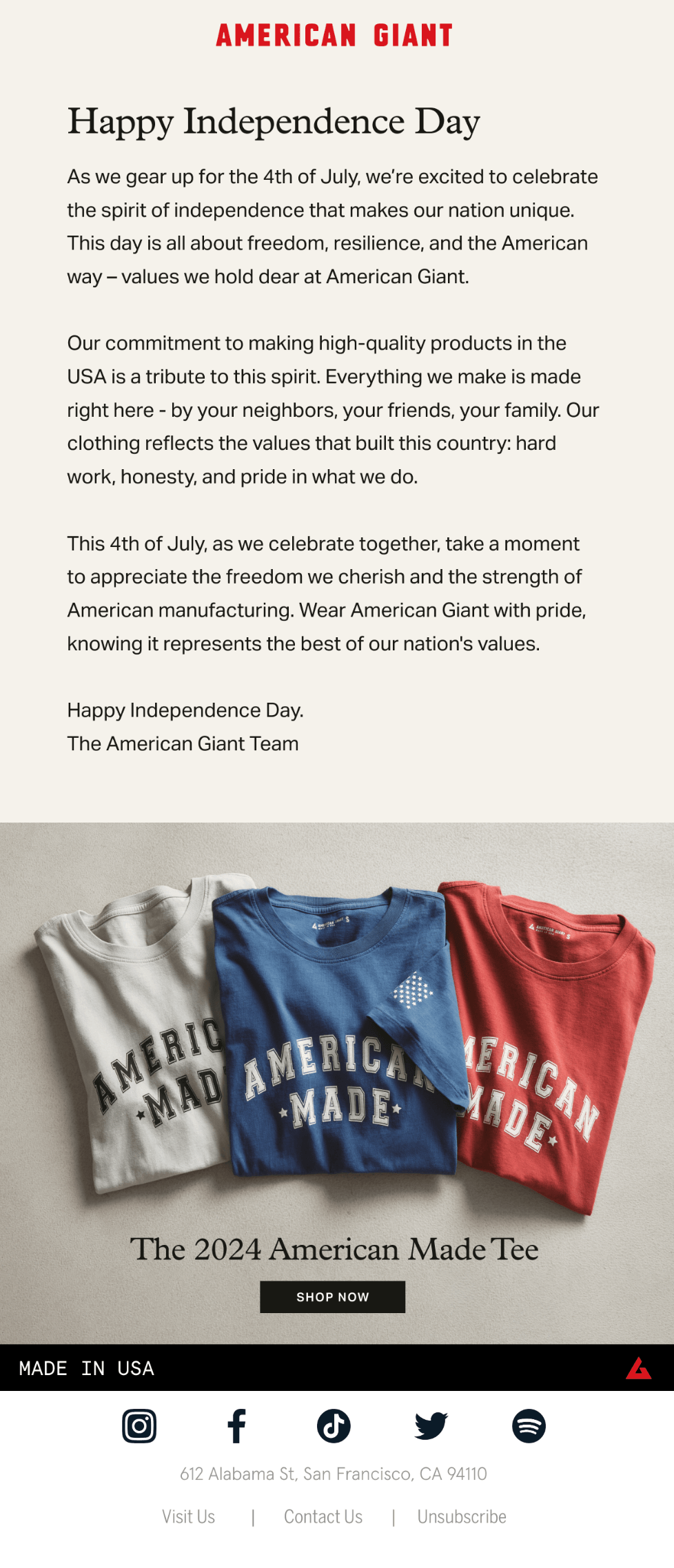
7. International Kissing Day
Pucker up because International Kissing Day lands on July 6, and it’s the perfect excuse to bring a little Valentine’s Day magic into the middle of summer.
Originally created to celebrate the simple joy of a kiss, this fun and flirty holiday is ideal for lighthearted campaigns that spread love (and maybe a few deals).
Email campaign: Keep it playful, romantic, or cheeky depending on your brand voice.
- Special deals: Offer sweet, limited-time discounts tied to the theme.
- Kiss-worthy picks: Highlight bestsellers people love to gift, wear, or indulge in.
- User-generated love: Feature cute couple pics, kiss stories, or customer reviews that bring smiles.
- Just-for-fun quiz: Create a “What Kind of Kisser Are You?” quiz and tie results to product suggestions or discounts.
When to send: Deliver your campaign on July 6 to celebrate with your audience. You can send more than one campaign on that day. For example, send your quiz in the morning and the special offer later that day.
Subject lines:
- Smooch all day this National Kissing Day. (Fenty Beauty)
- Summer’s Sweetest Holiday Is Here!
- Smooch, Shop, Repeat 😘
Email copy: Your message needs to be light and fun. Add wordplay if it fits your tone (“steal a deal,” “smooch-worthy picks”), and tie everything back to connection or indulgence.
Visuals: Think lips, heart shapes, soft pinks or reds with summery tones. Use couples, close-ups, or playful illustrations.
CTAs:
- Steal a Smooch (and a Deal)
- Shop Kiss-Worthy Gifts
- Claim Your Sweet Surprise
Example: Then I Met You
Then I Met You takes a smart, kiss-ready approach for International Kissing Day with this summery email marketing campaign.
The bold headline (“Prep and Plump Your Pout”) immediately ties into the holiday.
What really works here, though, is the GIF-style visual, which demonstrates how to apply the product in real-time, making it both engaging and practical.
The social proof at the end of this July email marketing campaign adds credibility and trust, positioning the product as a daily must-have.
Subject line: It’s International Kissing Day 💋

8. World Chocolate Day
If International Kissing Day is the spark, World Chocolate Day is the sweet reward.
Celebrated every July 7, this is the perfect follow-up to your flirty July 6 campaign. So, why not turn it into a two-day love fest that brings a little Valentine’s Day energy to summer?
Email campaign: You can bundle chocolate-themed products, promote sweet treats, or run a “Kiss & Chocolate” offer for both days. If you’re shipping chocolate, make sure it arrives fast because it’s hot in July, and we don’t want anything melting but hearts.
- Engaging content: Share chocolate recipes and how your products use chocolate. This is great for food, beauty, or lifestyle brands.
- Ethical sourcing: Educate your audience on the importance of ethical chocolate sourcing, sustainable practices, and the positive impact it has.
- 2-day celebration: Launch a themed mini-campaign combining Kissing Day and Chocolate Day with exclusive bundles or limited-time gifts.
- Sweet discounts: Highlight products ideal for gifting, whether it’s actual chocolate or chocolate-scented, colored, or inspired.
When to send: If you run a 2-day celebration, tease it on July 5. Then, launch your Kissing Day email on July 6, followed by Chocolate Day on July 7. If not, just send your campaign on Chocolate Day.
Subject lines:
- It’s International Chocolate Day 🍫 (Soylent)
- One Kiss. One Treat. Two Sweet Days 🍫💋
- A Little Love, A Lot of Chocolate
Email copy: Focus on the benefits of your product and provide tips on how to enjoy it to its fullest potential. You can add fun suggestions, pairing ideas, or even ways to share it with someone special.
Visuals: Use chocolate tones, product flat lays, or drip/melt graphics. Pair with pinks, reds, or golds for a luxe vibe.
CTAs:
- Shop the Sweet Bundle
- Treat Yourself (or Someone Else)
- Send a Chocolate Kiss
Example: GIGANTIC
Gigantic!’s World Chocolate Day email hits all the right notes with a fun, flavorful, and valuable message.
The copy keeps things light and cheeky (“not to brag, but…”) while still educating the reader on what makes their product different.
This is a strong July email marketing example of how to balance transparency with brand personality and a reminder that chocolate emails can be both sweet and smart.
Design-wise, the generous white space keeps the layout clean and easy to read, while the pink frame adds a playful touch that complements the product’s color palette nicely.
Subject line: true or false: it’s world chocolate day 🍫
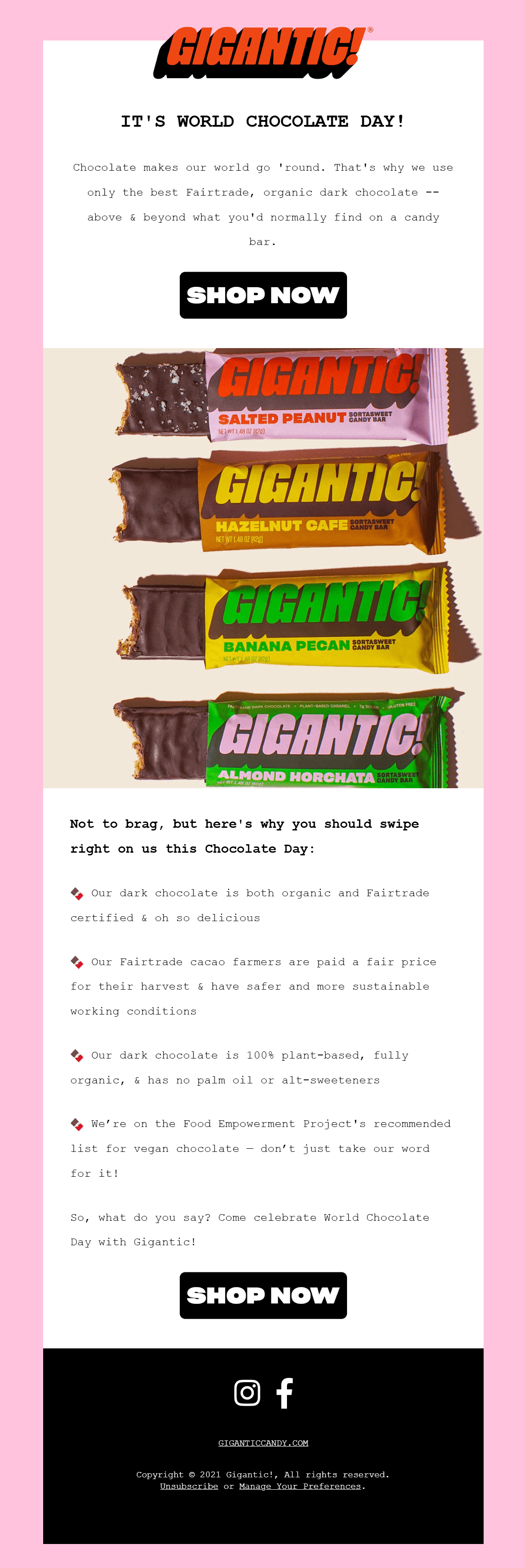
9. National Give Something Away Day
Celebrated every July 15, National Give Something Away Day is the perfect opportunity for brands to turn goodwill into action.
You can plan donations, giveaways, or partnerships that support people in need to celebrate with your audience and highlight your brand’s values.
Email campaign: Focus on purpose over profit. This day is about sharing, supporting, and reminding your audience that every little bit counts.
- Partner for impact: Collaborate with nonprofits to donate essential items, such as children’s toys, hygiene kits, or food supplies.
- Give back: Encourage customers to give back. You can offer a free gift with every purchase and invite them to donate it or match donations they make.
- Share the story: Spotlight the people or communities your brand is helping. Share genuine stories and demonstrate the impact of giving.
- Host a giveaway: Run a giveaway campaign that rewards both the winner and a community initiative of your choice.
When to send: Start the conversation a few days before July 15 to raise awareness. Follow up on the day with a clear call-to-action (CTA) or an update on progress.
Subject lines:
- 💛 Let’s Give Back, Together
- A Day for Good Deeds and Big Hearts
- Help Us Spread Some Joy This July 15
Email copy: Show your audience how they’re part of something bigger. If there’s a donation goal or match happening, be clear about how it works.
Visuals: Use human-centered imagery, warm tones, and clean layouts. Highlight your nonprofit partners or show the impact of giving.
CTAs:
- Give Back With Us
- Join the Movement
- Make a Difference Today
Example: Camper
Camper’s July email marketing campaign shows how to align your message with National Give Something Away Day through purpose-driven action.
While the campaign focuses on their Take Back program, it naturally fits the theme of giving by encouraging customers to donate their used Camper shoes.
The copy is clean and direct, emphasizing the idea that Camper shoes don’t get old, they get second chances. The impact is measurable (over 37,000 pairs recovered), and the incentive ($30 credit) makes participation easy and rewarding.
Subject line: Trade in your shoes with Take Back

10. Self-Care Day
Between the sun, sales, and the scroll fatigue, your audience probably needs a breather.
That’s where Self-Care Day on July 24 comes in with a gentle reminder to slow down, check in, and put themselves first, even for just a moment.
Email campaign: Offer value without pressure and position your brand as part of someone’s rest, not their to-do list.
- Mini self-care routine: Share a 3-step ritual using your products (morning, night, 5-minute reset, etc.).
- Zero-click newsletter: Skip the hard pitch and send a valuable email that shares tips, meditations, or mood-boosting ideas.
- Community involvement: Invite your audience to share how they unwind and spotlight a few responses in follow-ups.
When to send: Plan your main email for July 24, but consider building a short sequence to maintain high engagement. For instance, you can set up two emails: one a few days before to introduce the idea of Self-Care Day and offer tips or a product teaser, and another on the day itself with your core message.
Subject lines:
- Self-Care All Day (Gaiam)
- A Reminder to Breathe And Be Kind to Yourself
- It’s Okay to Do Nothing Today
Email copy: Skip urgency and use soothing language to keep things stress-free. Acknowledge how busy life is and offer simple ways to unplug.
Visuals: Neutral tones, nature-inspired images, soft textures, or illustrations are well-suited for this style. Also, opt for clean layouts, white space, and minimal text.
CTAs:
- Start Your Ritual
- See Our Calm Edit
- Breathe In, Shop Later
Example: KonMari
This July email marketing campaign from KonMari shows how to do Self-Care Day right. It starts with an image of Marie Kondo and a message about the importance of taking care of yourself.
Instead of pushing hard sales, it shares her routine and invites readers to explore it. The offer (25% off self-care products) is there, but it’s subtle and well-placed.
Additionally, the waitlist for the KonMari Club provides extra value with complimentary self-reflection prompts.
Subject line: Marie’s Self-Care Rituals

July Email Marketing Do’s and Don’ts
Now, let’s see how to keep your campaigns sharp and seasonal with these quick do’s and don’ts.
Do’s
- Tie campaigns to real summer behavior (travel, pool days, weekend getaways).
- Use urgency smartly for limited-time promos and flash sales.
- Keep visuals inclusive and diverse for a broader connection.
- Offer lightweight content, such as checklists, mini-guides, or routines.
- Space out your sends to avoid inbox overload.
- Celebrate niche holidays, such as Self-Care Day or World Chocolate Day, to boost engagement.
- Clean your list and test links before sending your emails to ensure accuracy. Summer is no time for broken buttons.
Don’ts
- Don’t rely on tired summer phrases like “beat the heat” or “fun in the sun.”
- Don’t push discounts without adding value (tips, stories, or moments).
- Don’t use loud, spammy subject lines (🚨ALL CAPS + EMOJIS🚨)
- Don’t assume everyone’s on vacation.
- Don’t forget mobile optimization. Your audience is out and about.
Lastly, don’t ignore deliverability best practices during a competitive inbox season.
Templates for July Email Marketing Campaigns
All set with your July plans? Great! Now let’s get those emails looking as good as your campaign ideas.
From Plastic Free July to unexpected Black Friday in July sales, we’ve created a collection of ready-to-edit email templates to help you move quickly without sounding generic.
Want to start from something solid? Sign up for a Moosend account, select a layout you love, and customize it to your heart’s content.
Mid-summer promotions
This eye-catching template is ideal for Mid-Summer Sales, thanks to its playful design, beach-ready visuals, and clear product layout.
The bold header and bright CTA buttons guide the reader to action, making it perfect for seasonal clearances, promotions, or last-minute vacation deals.

You can also customize it for:
- 4th of July Sales (with red, white, and blue colors)
- Christmas in July (add playful festive touches)
- Travel Essentials Campaigns (highlight bundles or gear)
- Back-to-School Prep (late July promotions for early planners)
Black Friday in July email marketing template
This high-impact template is a perfect match for Black Friday in July campaigns.
With its vibrant color scheme, oversized typography, and product-first layout, it creates a sense of urgency and excitement from the outset.
You can use any Black Friday newsletter template for your July sales. Just add a splash of color and you’re ready to go.
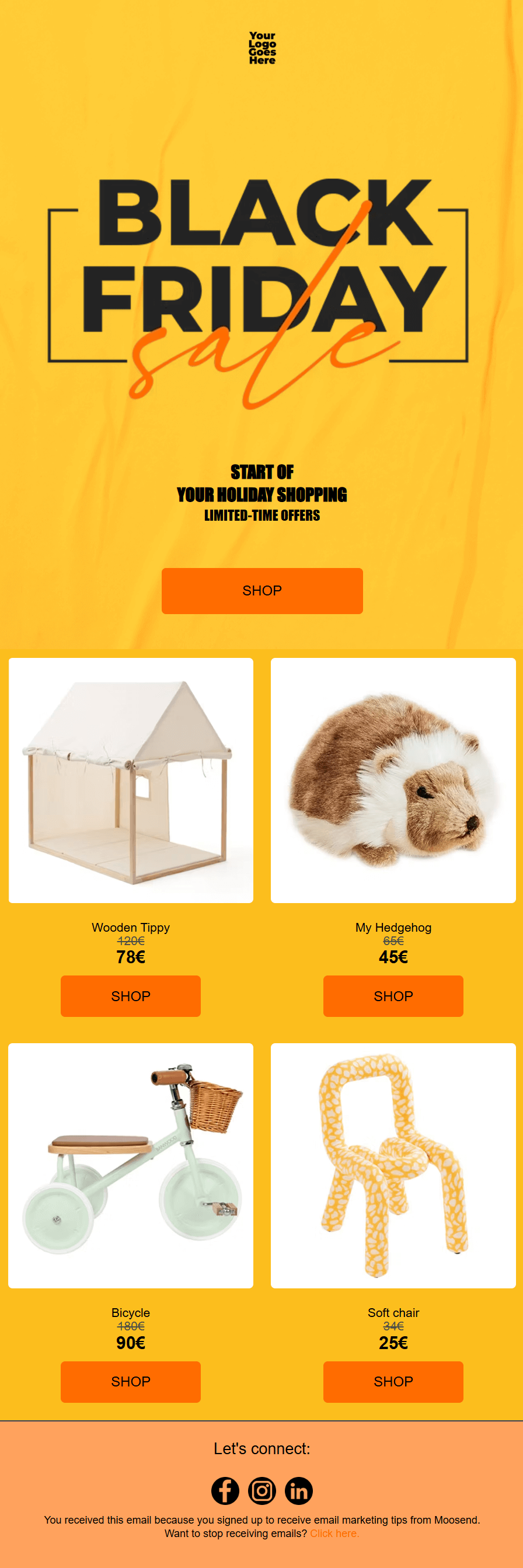
Further reading: Take a look at our Black Friday email marketing strategy guide for more tips.
Summer destinations newsletter template
This travel-themed template is ideal for summer travel promos, getaways, or “book now, save later” offers.
It highlights destinations with brief descriptions, making it ideal for tour agencies, airlines, or hospitality brands seeking to increase bookings or promote exclusive travel deals.

Set Your July Email Marketing Strategy in Motion
And just like that, your July email strategy is ready to go.
With timely campaigns, actionable ideas, and easy-to-use templates in your toolkit, you’re set to boost engagement, drive sales, and stay connected with your audience all month long.
Whether you’re running a summer sale or highlighting a cause, keep your emails focused, relevant, and true to your brand.
And if you want a trustworthy email platform to help you set everything up, sign up for a free Moosend account and let’s get down to business.
Charter and Cox Communications just announced a $34.5 billion merger.
While it may sound like just another broadband headline, this move could have a significant impact on your email marketing strategy.
Below, let’s see what this means for your strategy and how to stay ahead.
What This Merger Means for You
When two internet providers with millions of users and their own email domains merge, a few things can happen:
- Old email addresses, such as @cox.net or @charter.net, may stop working.
- Bounce rates can spike as mailboxes disappear.
- Spam filters might shift as both companies blend their filtering systems.
- Delivery speeds may be affected by traffic rerouting and server updates.
Your list might be clean today, but this kind of merger can render valid contacts inactive. Staying ahead means keeping a close eye on your metrics and acting fast if you spot a change.
Let’s see how below.
How to Stay One Step Ahead (and How Moosend Has Your Back)
So, how can you protect your deliverability and keep your list in top shape during all this?
Here’s how Moosend helps you stay one step ahead.
Automatically suppress hard bounces – no manual cleanup needed
When an email hard bounces (meaning the address is invalid or no longer exists), Moosend instantly adds it to your suppression list.
This protects your sender reputation and automatically prevents future sends to dead addresses.
Keep your suppression list up to date as domains are phased out
If Charter or Cox retires legacy domains like @cox.net, affected emails will bounce, and Moosend will automatically suppress them for you.
No action needed from your side, and your list stays healthy without lifting a finger.
Monitor bounce trends and alert you when something’s off
Instead of waiting for issues to pile up, Moosend actively tracks your bounce rates and delivery performance.
If we detect an unusual spike, such as one caused by ISP changes, we investigate and alert you promptly, so you can take action before it impacts your results.
Adapt when domain policies change to ensure compliance
ISPs can change spam filtering rules at any time. With Moosend, your campaigns adapt to those shifts thanks to our ongoing infrastructure updates, smart throttling, and deliverability best practices baked into the platform.
Want to be extra safe? Run a reconfirmation campaign for older Cox and Charter users. Or segment them and monitor their performance over the next few months.
Every June, brands launch Pride Month campaigns to support the LGBTQIA+ community. While it’s a great initiative to show inclusivity, many of these efforts are seen as surface-level or inconsistent with a brand’s actions the rest of the year.
As a result, some companies are scaling back, while others are working to show genuine, long-term support.
In this post, we’ll see what Pride Month marketing means today and how to approach it without being performative. We’ll also share examples and explore why representation should not be limited to one month.
The State of Pride Month Marketing
Pride Month is now a regular part of many marketing calendars.
But it started as an act of resistance, most notably the Stonewall uprising in 1969. Since then, Pride has grown into a global movement focusing on activism, visibility, and community.
Today, more brands take part, launching themed products and campaigns. But showing up in June isn’t enough. Consumers want to know how a brand supports the LGBTQIA+ community and why.
A rainbow logo or limited-edition item means little without real, year-round action behind it. In fact, 62% of consumers believe that launching Pride-themed products is done mostly for profit, while only 34% view it as a gesture of social good.
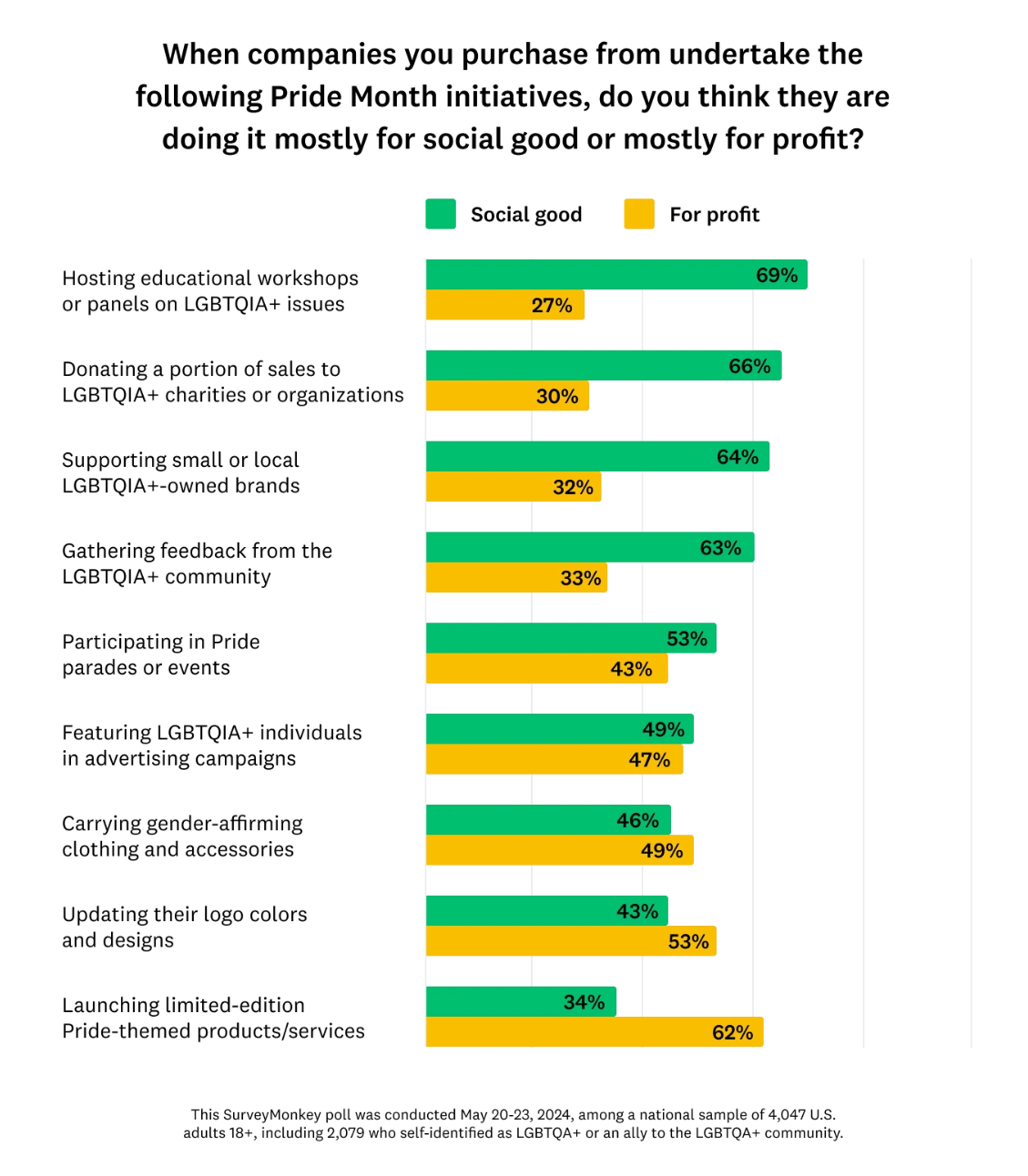
To be taken seriously, Pride campaigns need to be part of long-term support, not seasonal visibility.
However, recent data highlights a growing gap between what companies do during Pride Month and what the LGBTQIA+ community and its allies expect.
Here are key takeaways from SurveyMonkey’s poll:
- 64% of LGBTQIA+ individuals and allies believe most Pride campaigns are performative.
- 71% expect companies to be transparent about their Pride initiatives.
- 29% call rainbow-washing one of the worst things a brand can do during Pride.
- 69% say hosting educational panels or workshops on LGBTQIA+ topics feels genuinely supportive.
- 41% are more likely to support brands that show year-round commitment to LGBTQIA+ inclusion, not just in June.
- 30% say they research a brand’s LGBTQIA+ policies before making a purchase, which rises to 49% among those who buy Pride merchandise.
These expectations have raised the bar. As a result, audiences want more than visibility. They demand consistency, transparency, and real advocacy. And when those expectations aren’t met, skepticism grows.
That disconnect may explain why Pride Month marketing is noticeably quieter this year.
Why Is Pride Month Marketing Quieter This Year?
While some brands are scaling back their visibility, others have chosen not to promote Pride-related content at all.
This shift reflects lessons from last year, when backlash, political pressure, and consumer skepticism prompted many companies to rethink their approach.
Increased scrutiny around “rainbow-washing”
One of the main reasons why Pride Month marketing is losing traction is that many brands have faced criticism for rainbow-washing. The term refers to using Pride Month for visibility without demonstrating long-term support for LGBTQIA+ communities.
Consumers and creators have become more vocal in calling out campaigns that appear performative or disconnected from real impact.
In 2024, several brands like ‘The Phluid Project’ saw a drop (25%) in brand partnerships compared to previous years.
According to Inc., the founder and CEO, Rob Smith, tried to explain this phenomenon by mentioning that retailers decided to “play it safe” due to the elections and changes that the new administration enforced (e.g., new passport policy).
Some advocacy organizations like GLSEN, which helps businesses create inclusive messages, also reported declining corporate involvement and financial support tied to Pride campaigns.
However, the lack of involvement isn’t the only reason why Pride Month marketing has taken a hit.
Risk of backlash and boycotts
After facing backlash in 2023, brands like Target and Nike scaled back their Pride campaigns in 2024.
More specifically, Target reduced the number of stores featuring Pride merchandise, citing safety concerns after displays were disrupted the year before. Nike, which had offered Pride collections since 1999, opted out entirely in 2024, instead focusing on ongoing support programs.
Not all changes indicate complete withdrawal, though. While some companies stepped away, others are shifting toward sustained, year-round inclusion rather than seasonal visibility.
This shift raises an important question: Should every brand participate in Pride Month marketing or only those actively supporting the LGBTQIA+ community throughout the year?
Which Brands Should Participate in Pride Month Marketing?
While visibility matters, Pride Month should not be approached as a branding opportunity alone.
Campaigns that lack substance or internal backing can do more harm than good both to the brand and the community it claims to support.
Brands that show ongoing commitment
Brands that have demonstrated consistent support for the LGBTQIA+ community through hiring practices, internal policies, and community partnerships can easily run a more dedicated campaign during Pride Month.
Levi’s, for example, has been an active supporter since 1992.

Their Pride campaigns feel like more of an extension of that commitment and ongoing efforts rather than following marketing trends and chasing the seasonality hype.
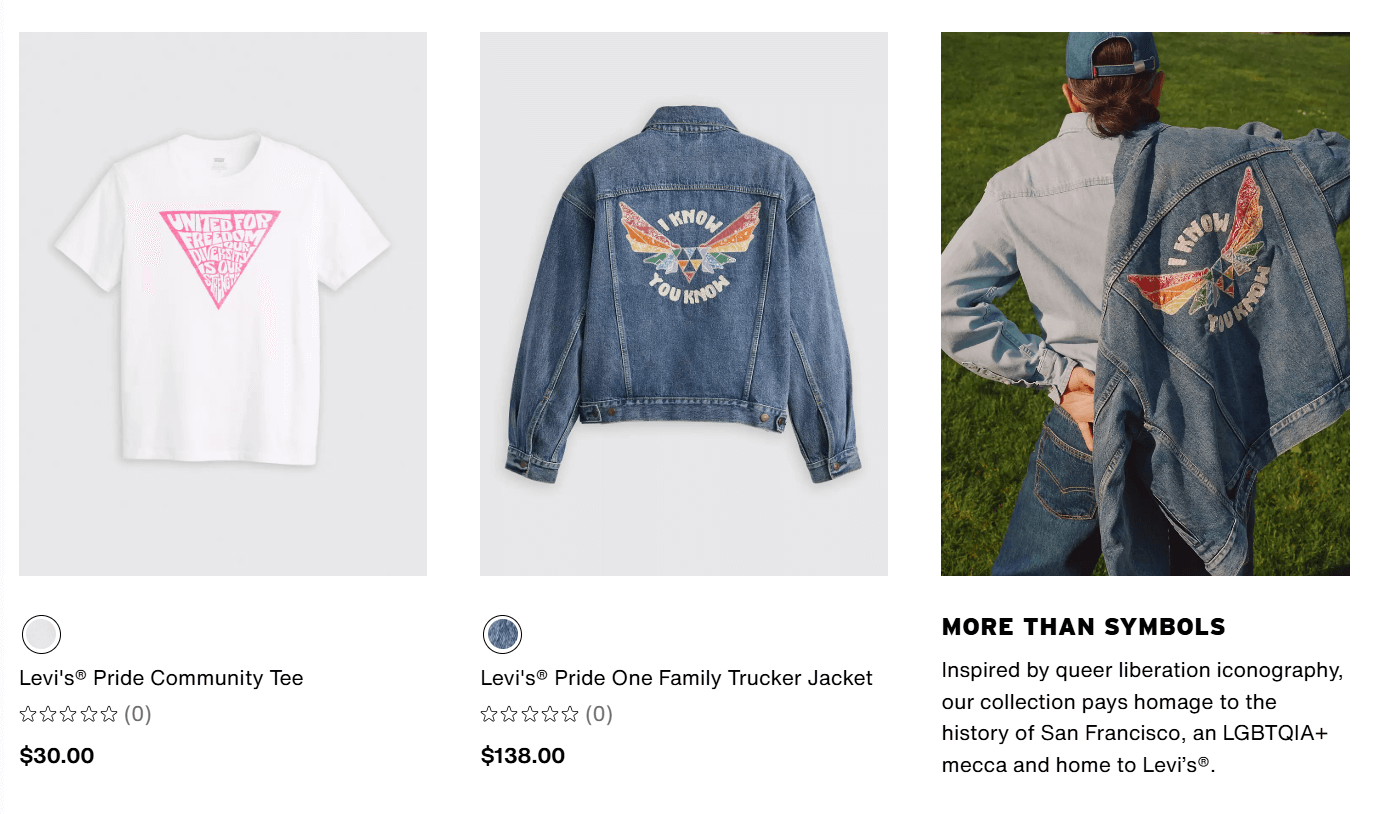
Brands that want to get involved long-term
Brands that are new to LGBTQIA+ advocacy can still take part, but they should begin with transparency.
If support is recent, that should be acknowledged, and plans for long-term action should be clear. Pride campaigns can serve as a starting poin,t but only if they come with real intent and follow-through.
To avoid backlash, plan your inclusion efforts well in advance and use Pride Month to share progress, not just promises.
Brands that aren’t ready to commit should take a step back
If a company has no internal policies, partnerships, or diversity initiatives related to LGBTQIA+ inclusion, launching a Pride campaign may backfire.
As you can see below, 40% believe that the worst mistake a brand could make in celebrating Pride is neglecting such policies.
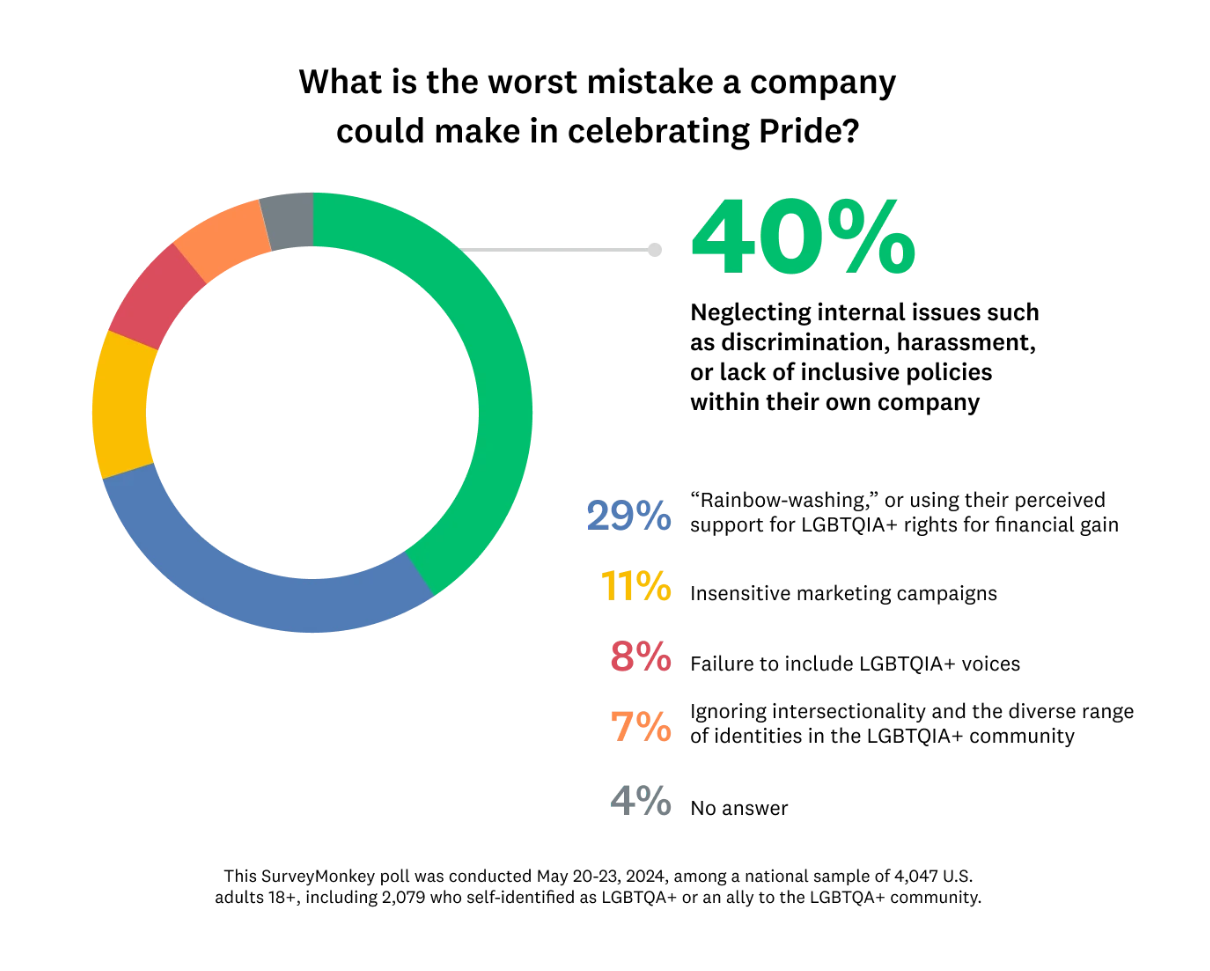
If your brand has yet to commit, stepping back is more responsible than sending a message that lacks support.
So, what about the brands that genuinely want to support Pride but are unsure how to do so respectfully?
How to Participate in Pride Month Without Being Performative
As mentioned above, Pride Month shouldn’t be treated as a seasonal branding opportunity because this leads to performative marketing.
To avoid that, be transparent across all channels, including email, social media, in-store, and web. Show that your brand’s support isn’t limited to June but part of a consistent, long-term commitment.
1. Update your logo if it supports real action
Changing a logo or product packaging with rainbow colors is common, but it shouldn’t be the whole campaign. If you choose to change your branding for Pride, it should come with context.
For example, tying the change to an initiative, such as donations to LGBTQIA+ nonprofits, support for queer-owned businesses, or employee-led events, will provide that.
Here’s what a popular brand like IKEA did:
- Participated in Pride events across the U.S., including the DC Capital Pride Parade
- Hosted an “Embrace Your Space” booth to welcome and celebrate attendees
- Donated $1 per rainbow cake sold (up to $100,000) to True Colors United to help end LGBTQIA+ youth homelessness
- Donated 100% of STORSTOMMA bag sales (up to $50,000) to Rainbow Railroad, supporting LGBTQIA+ individuals facing persecution

With actions like these, IKEA has more than enough reasons to update its logo for Pride. The difference is they didn’t, and that’s the point.
When a brand backs its words with real impact, it doesn’t need to rely on a temporary logo swap to prove anything. A visual change without substance risks being seen as rainbow-washing. But substance without spectacle? That speaks for itself.
If your brand is doing the work, show it through your actions. You don’t have to follow every trend to make your support visible, especially when your commitment is already clear.
2. Spotlight LGBTQIA+ employees, partners, or customers
Highlighting LGBTQIA+ members is one of the most direct ways to give visibility to the community.
This can be done through dedicated email marketing campaigns, social media takeovers, blog interviews, or short videos. Stories should be shared with consent and without editing out the actual experiences.
Also, avoid turning these stories into emotional appeals or marketing hooks. Let them be part of a broader effort to recognize LGBTQIA+ voices year-round.
Here’s a good example from Bobbi Brown’s Pride Month campaign, spotlighting friends in the LGBTQIA+ community, including their own Executive Director.
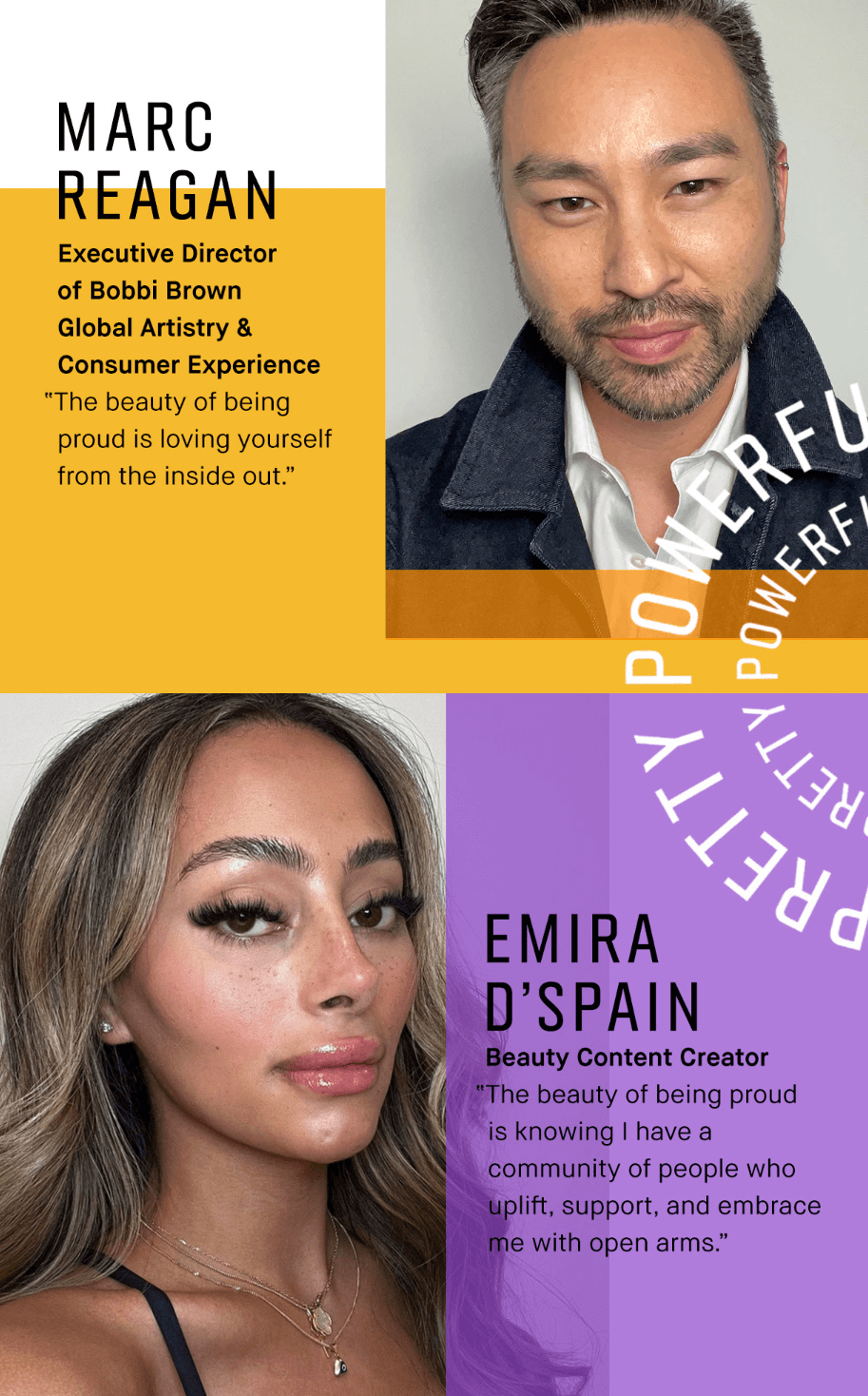
To do this yourself:
- Start by asking your LGBTQIA+ employees, creators, or partners if they want to be featured.
- Use simple Q&A formats, quotes, or short videos.
- Let them speak about what Pride means to them, in their own words.
- Publish across your main channels and link to actions your brand is taking so the story has context and purpose.
3. Prioritize impact over promotion
If you’re launching a Pride collection, make the purpose clear. Who benefits? How is the community involved? Products without a clear goal or contribution often feel performative.
Happy Socks is a good example of how to approach this the right way.
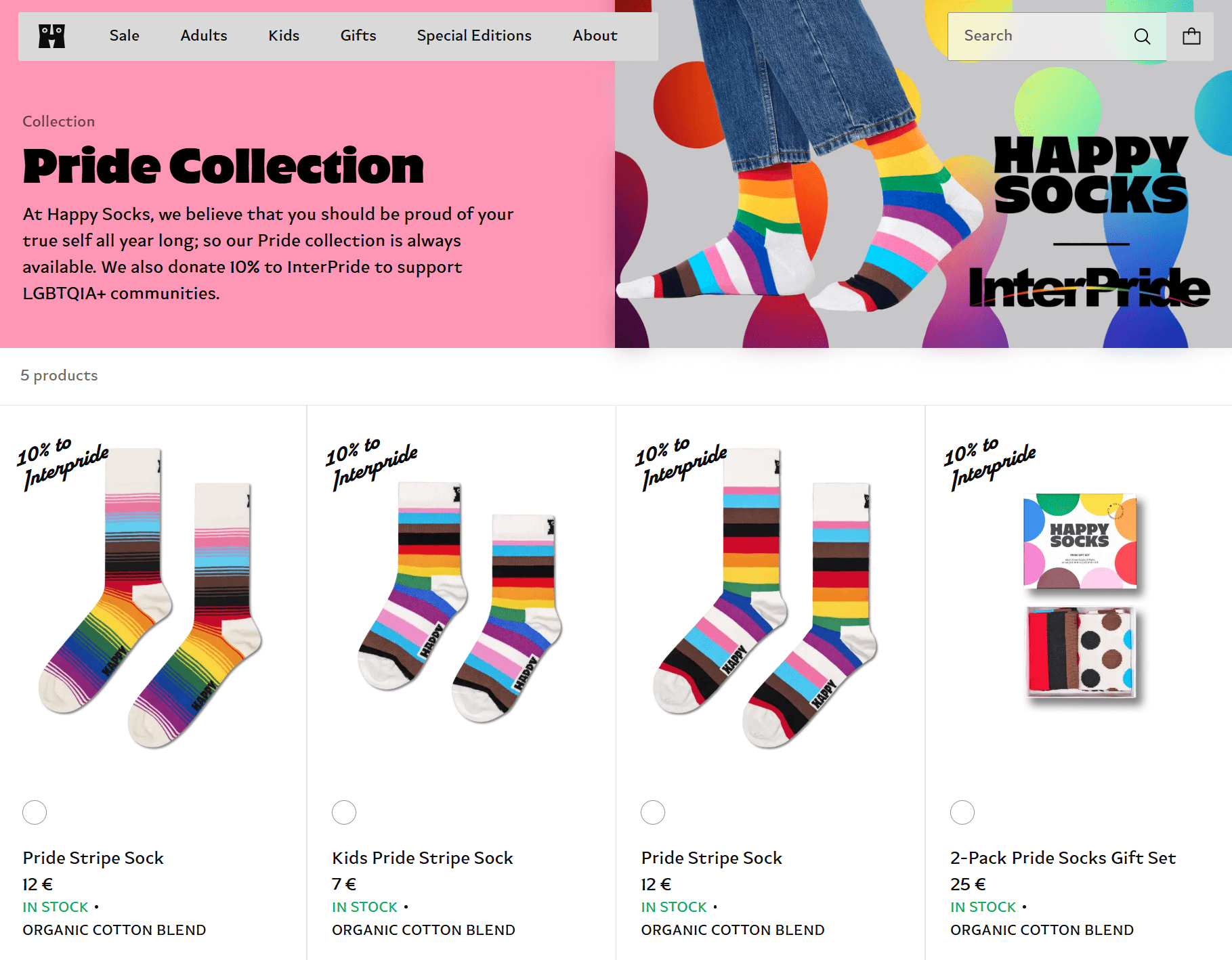
Their Pride collection is available year-round, not just in June. They also donate 10% of proceeds to InterPride, a global organization supporting LGBTQIA+ communities. The campaign centers on inclusion and long-term visibility, favoring impact over seasonal promotion.
When brands are transparent about where funds go and why the initiative matters, it shows intent.
4. Distribute valuable content through email
Email is a direct way to communicate your Pride Month efforts, but it needs to go beyond product promotion.
To avoid performative messaging, use email to show your actions and community involvement.
Here’s a good example from MeUndies.
Subject line: We 💜 LA LGBT Center
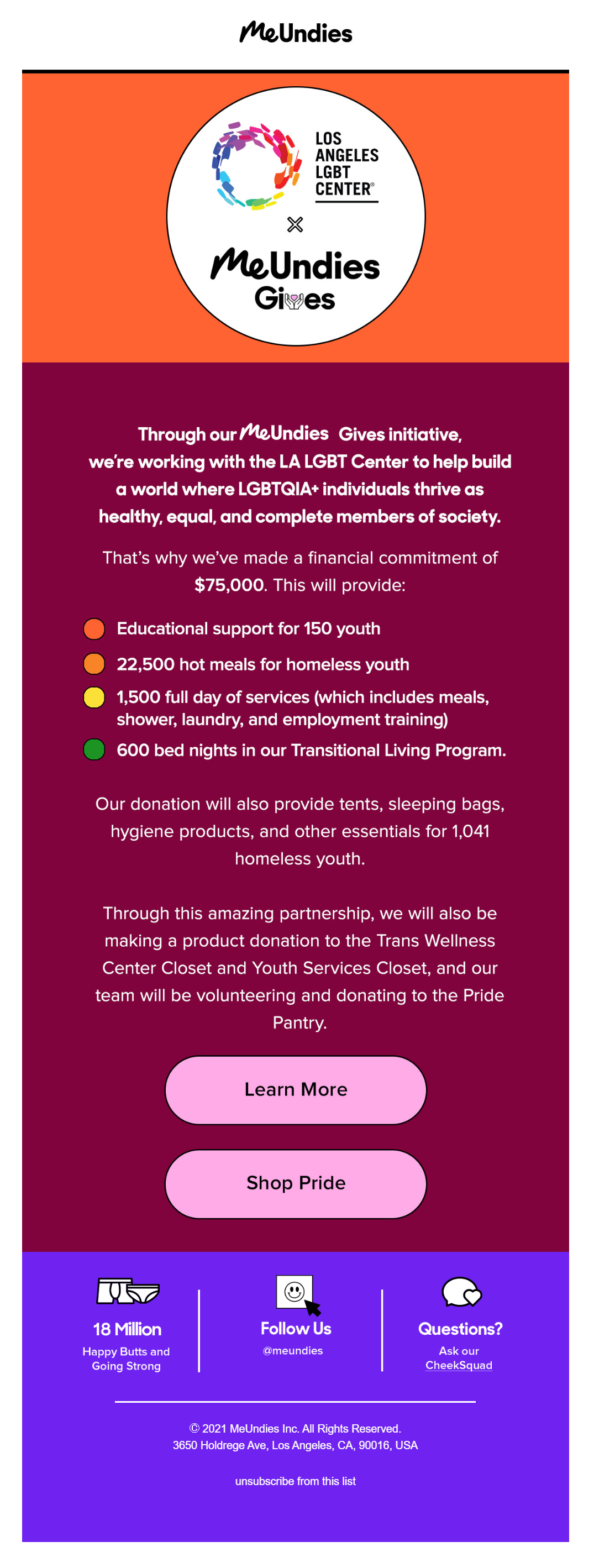
In their Pride Month email marketing campaign, they clearly outline their $75,000 donation to the LA LGBT Center and break down how the funds will be used, from educational support and meals to transitional housing for homeless LGBTQIA+ youth.
The email includes specific numbers, details, and follow-through actions like product donations and team volunteering. It’s clear, measurable, and shows the impact.
For your brand, use email marketing to:
- Explain your campaign’s purpose and who benefits
- Share real partnerships and internal initiatives
- Include direct links to resources or donation pages
- Follow up later with impact metrics or community feedback
Avoid vague phrases like “we stand with the LGBTQIA+ community” unless you can show how.
The more specific you are, the more trustworthy your message becomes.
5. Use social media to show your actions
Social media is often the most visible part of a Pride campaign, but it’s also where performative marketing is easiest to spot.
To be respectful, brands should use their platforms to educate, amplify, and share actions.
Accenture’s 2024 Pride video is a great example of how to do it.
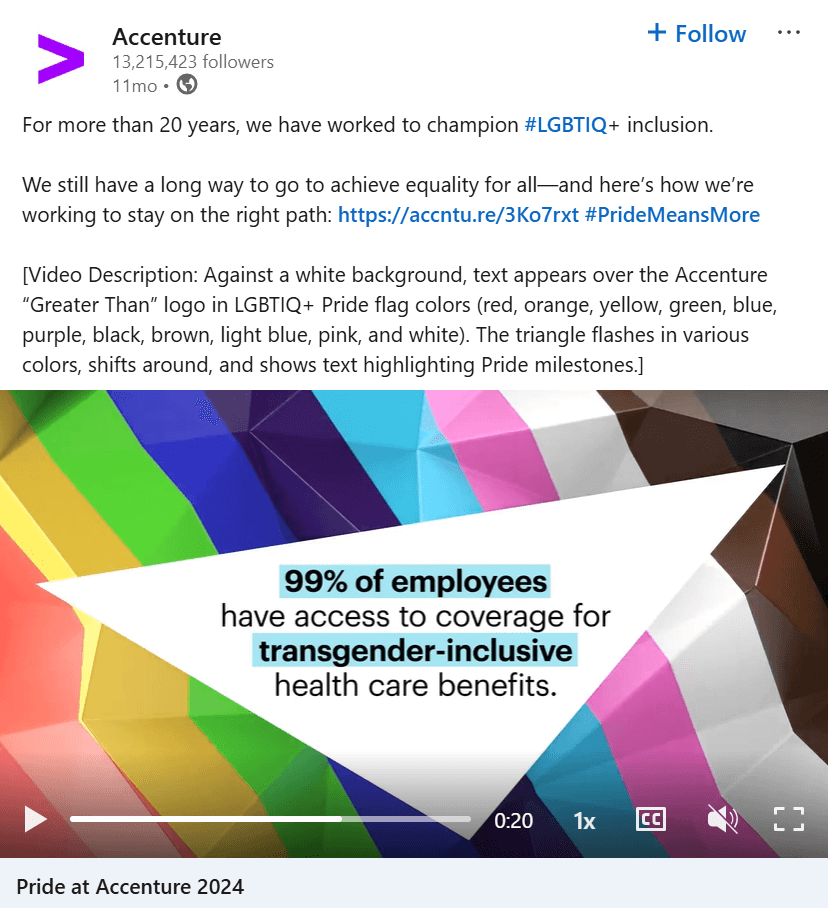
Instead of promoting products, the company highlights some important actions, including the fact that 99% of employees have access to transgender-inclusive health care.
The campaign shows what inclusion looks like through facts, not slogans. That’s the kind of content that earns trust.
6. Feature LGBTQIA+ brands and creators
As mentioned, respectful Pride Month marketing doesn’t need to rely on rainbows to be effective. Instead of filling shelves or banners with symbolic colors alone, focus on substance.
Use your in-store displays or homepage to spotlight products created by LGBTQIA+ artists or businesses. Share their stories, not just their designs. Highlight their role in shaping the collection and explain why your brand collaborated with them.
This not only promotes real voices but shifts the focus from decoration to meaningful participation.
Now, let’s examine Target’s infamous 2023 Pride campaign. The backlash didn’t come from featuring LGBTQIA+ creators but from how the campaign was handled.

Overly broad, heavily branded displays lacked nuance and drew unnecessary attention from extremist groups. Worse, employees were left without clear support when controversy arose.
Instead of plastering rainbows across products, Target could have taken a more thoughtful approach, uplifting small LGBTQIA+-owned brands, highlighting individual creators, and scaling visibility based on context.
If there’s a lesson to be learned here, it’s that Pride doesn’t require mass-produced (rainbow-colored) merchandise.
Pride Month Marketing Campaign Examples: The Good & the Problematic
Some brands have delivered Pride campaigns that are thoughtful, authentic, and deeply aligned with their values.
Others, however, have missed the mark, falling into performative gestures or disconnected messaging.
Let’s take a closer look to help you avoid common pitfalls in the future.
Freeletics’ successful LGBTQIA+ spotlight
This campaign by Freeletics is a great example of how to use storytelling, representation, and purpose-driven content to meaningfully support Pride Month.
Subject line: Outrunning stereotypes

Let’s see what works:
- Focus on storytelling over sales: The email centers on Anthony, an LGBTQIA+ athlete and coach, sharing his personal journey. The message is authentic, inspiring, and free of sales-heavy language.
- Real representation: Instead of rainbow graphics or generic statements, the campaign highlights real experience. Quotes and photos put a face to the message of inclusion in fitness.
- Purpose-led content: The CTA buttons align with the broader theme of empowerment, without pushing a discount or limited-time offer. It connects product to purpose.
- Thoughtful design: The email uses clean visuals, inclusive language, and a minimal Pride-themed banner (Flex your pride) without overwhelming the story.
- Clear internal alignment: Highlighting an LGBTQIA+ team member in a feature story signals internal support, not just outward-facing branding.
Why it’s a good Pride Month campaign:
It avoids rainbow-washing by showing real people, elevating authentic stories, and using Pride Month to reinforce the brand’s values around inclusion, performance, and representation. There’s no forced tone shift, and the campaign would still feel credible even outside of June.
Lego’s “Everyone is Awesome”
LEGO’s “Everyone is Awesome” campaign is a powerful example of how a brand can merge product, storytelling, and internal values into one cohesive Pride initiative, without performative overtones.
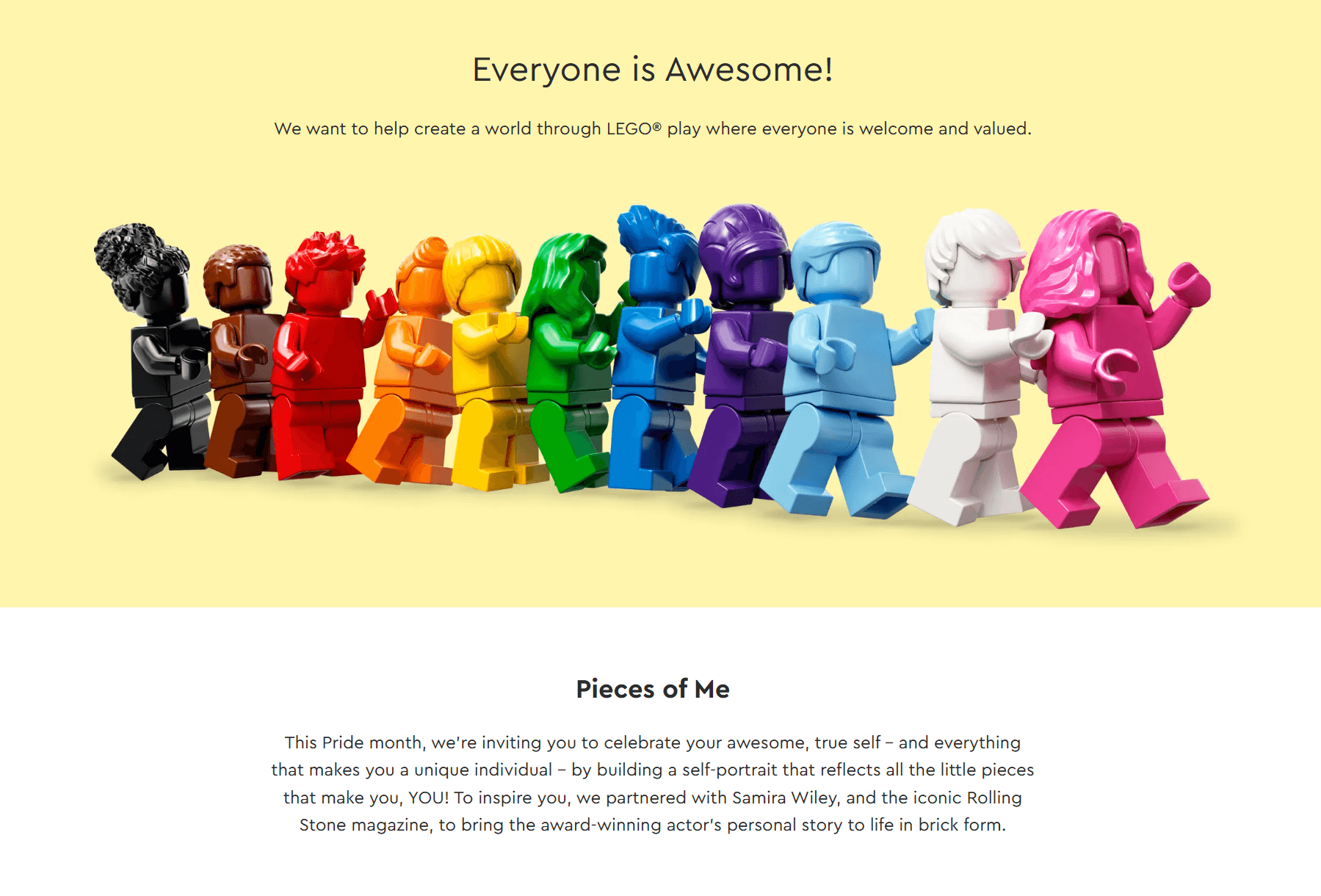
Here’s why it worked:
- Designed by and for the LGBTQIA+ community: The set was conceived and designed by LEGO’s Vice President of Design, Matthew Ashton, who is openly gay. His personal story powers the product, giving it authenticity from the inside out.
- Focused on self-expression: The product, while commercial, isn’t just merchandise. Ashton shares how a set like this would have meant everything during his own coming out, changing the narrative from product to purpose.
- Representation with intention: The minifigures represent the full spectrum of the LGBTQIA+ community, including Black, Brown, and trans individuals. The inclusion of a purple drag queen figure also celebrates queer culture in a respectful way.
- Emotional storytelling: Ashton speaks openly about growing up in the 80s, facing pressure to conform, and how this project became both a personal milestone and a signal of support to others. It’s a heartfelt message, not a marketing script.
- Internal alignment and allyship: This initiative wasn’t created in isolation and reflects LEGO’s broader commitment to inclusion.
Why it’s a good Pride Month campaign:
LEGO’s example showed what Pride marketing should be: inclusive by design and focused on community. It doesn’t just say “Everyone is awesome.” It shows us why and how that belief is lived out in practice.
Skittles & GLAAD: “When You Find Your Community, Your Colors Shine”
Skittles has become a recognizable presence in Pride Month marketing over the past five years, not through flashy campaigns, but by consistently evolving how they show up for the LGBTQIA+ community.
Their Pride campaign built on that legacy with a deeply community-oriented approach.
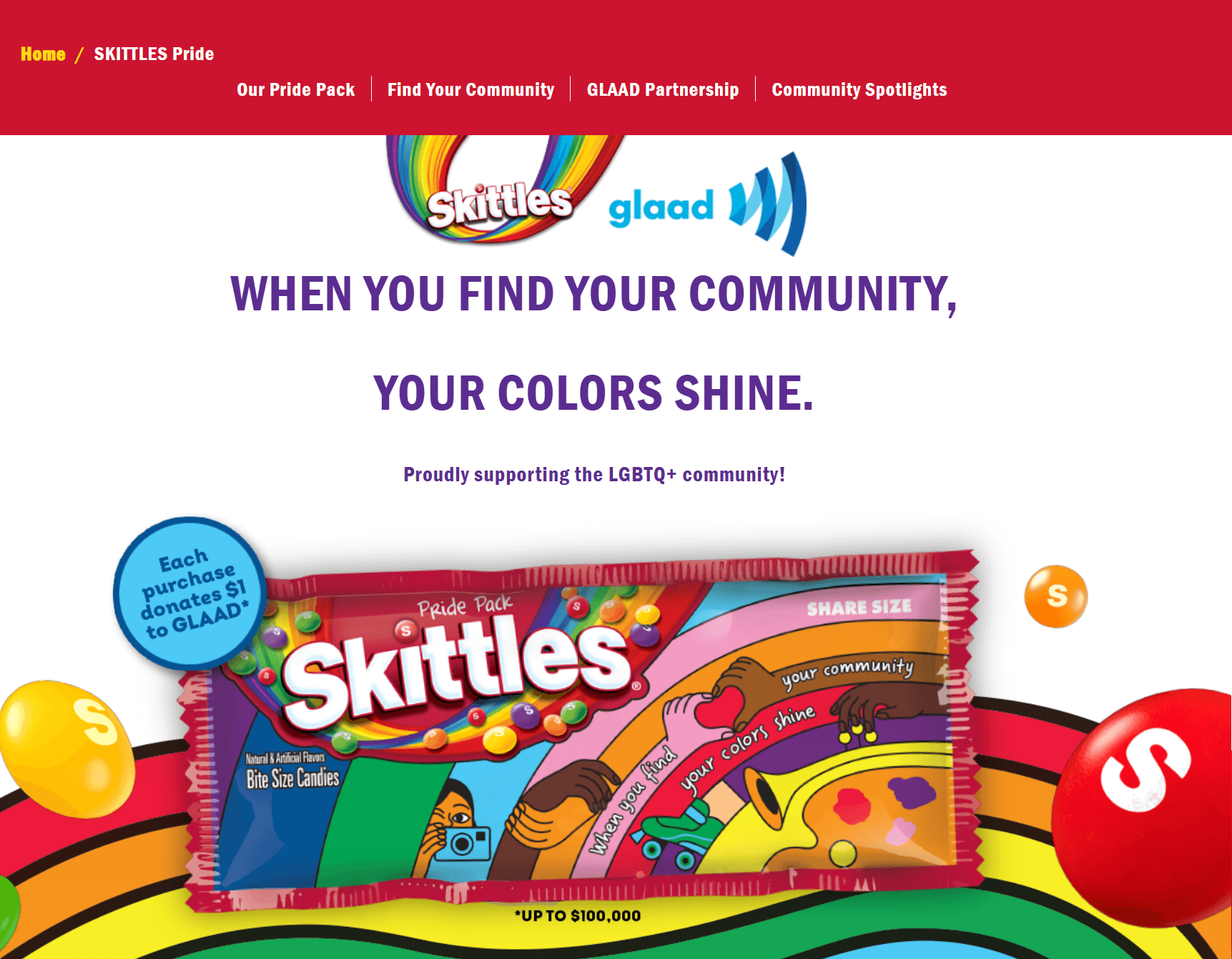
Let’s see what worked:
- Ongoing commitment: Skittles has partnered with GLAAD for five years, showing long-term support beyond just Pride Month. Their messaging stays visible year-round.
- Transparent impact: $1 from every Pride Pack (up to $100K) goes to GLAAD, plus $25K in donation matching. The brand is clear about where the money goes.
- Community first: Instead of just branding, Skittles funds LGBTQIA+ groups across the U.S., supporting everything from roller derby teams to queer film festivals.
- Purposeful packaging: From their iconic grey packs to current custom art by queer creators, Skittles uses packaging to shift focus from candy to community.
- Identity over aesthetic: The tagline “When you find your community, your colors shine” reframes the rainbow’s use as personal expression, not a marketing symbol.
Why it’s a good Pride Month campaign:
Skittles doesn’t just show up during Pride Month. Through product design, sustained donations, and localized impact, they’ve embedded support for the LGBTQIA+ community into their brand narrative. It’s bold, fun, and, most importantly, full of substance.
Now, let’s see some not-so-great campaigns and why they were met with criticism.
Bud Light’s & Dylan Mulvaney
In April 2023, Bud Light partnered with transgender influencer Dylan Mulvaney in a single sponsored post to celebrate her “365 Days of Girlhood.”
The campaign aimed to align the brand with Pride and broader inclusion efforts. Instead, it sparked one of the most significant and prolonged brand backlashes in recent marketing history.
What happened:
- Backlash began immediately after the post went live, largely fueled by conservative voices on social media. High-profile figures called for boycotts and publicly denounced the brand.
- Sales plummeted, with a 28% drop in purchase incidence across the U.S. in the first three months. In heavily Republican counties, the decline reached 32%.
- Unlike other short-lived boycotts, Bud Light’s sales remained down by 32% into Q4 2023.
Why it missed the mark:
- No internal support: The campaign was limited to a single social post, with no broader message or visible support when backlash hit. Bud Light stayed silent instead of standing by its partner.
- No long-term inclusion strategy: There were no prior or follow-up LGBTQIA+ collaborations. Without consistency, the effort felt opportunistic rather than genuine.
- Retreat under pressure: Anheuser-Busch ended its 30-year sponsorship of Pride St. Louis, leaving organizers with a $150,000 funding gap.
- Ongoing visibility loss: Retailers cut Bud Light shelf space, further lowering sales and visibility and trapping the brand in a long-term decline.
Bud Light’s campaign wasn’t flawed because it supported a trans influencer. It failed because it lacked preparation, consistency, and commitment.
Burger King’s “Pride Whopper”
While “Pride Whopper” began as an attempt to support the LGBTQIA+ community during Pride Month, it has since become one of Burger King’s most criticized campaigns.
While the brand partnered with advocacy groups and included a donation pledge, the execution fell flat, resulting in backlash from the very audience it intended to support.

Why it missed the mark:
- Poor creative judgment: Serving the Whopper with “two top buns or two bottom buns” was meant to be symbolic but came off as tone-deaf, reducing LGBTQIA+ identity to a clumsy pun.
- Perceived rainbow-washing: With no visible history of LGBTQIA+ support, the campaign felt more like a marketing ploy than real advocacy.
- No internal alignment: Burger King offered no updates on inclusion policies or employee support, only a temporary product and vague messaging.
- No community consultation: The agency responsible for the campaign admitted they didn’t involve LGBTQIA+ voices during development, underlining the lack of meaningful collaboration.
- Poor response to backlash: Rather than take accountability, Burger King deleted content and stayed silent. The only apology came from the agency, not the brand.
Email Marketing for Pride Month
Unlike social media and offline marketing, emails allow space to share meaningful context, explain your actions clearly, and reach people who have already chosen to hear from you.
Done right, email can educate, inform, and promote, without being performative. Let’s see what you need to know about Pride Month email marketing below.
Actionable tips for a good Pride Month email
Creating a good email for Pride Month shouldn’t be a problem if you’re already familiar with email marketing best practices.
You must adapt them to reflect care, clarity, and genuine intent to make it work.
- Write respectful subject lines: Avoid clickbait or using Pride purely for open-rate boosts. Instead, keep your subject lines direct and value-driven. For example, “Pride Is More Than a Month: Here’s What We’re Doing” will be more considerate than “20% off Pride Month.”
- Use inclusive copy: State what you’re doing, who you’re supporting, and why it matters. Use inclusive email copy and avoid stereotypes or vague statements. For example, share real stories and let LGBTQIA+ employees, partners, or collaborators speak through quotes or spotlights.
- Don’t rainbow-wash your design: Design your Pride emails with intention. Use Pride colors meaningfully, not decoratively. Prioritize accessibility with clear contrast and alt text.
- Add contextual CTAs: Link CTAs to impact-focused content like donations, education, or campaign results, not only product pages.
- Keep your messaging aligned: Your messages must align with your brand voice and be tied to real actions. Avoid tone shifts that feel forced or disconnected from your usual communication style.
- Be mindful of email frequency: Send one to three emails during Pride Month: a kickoff, a mid-month update, and a final results email. Don’t over-send and prioritize relevance over volume to maintain trust and engagement.
Lastly, not every subscriber may want to receive content related to Pride. Respect this by including an opt-out link in your emails or a preferences center, allowing subscribers to control what messages they receive.
This shows consideration and protects trust.
Further reading: Check out our June email marketing planner to learn how to structure your LGBTQIA+ month campaign properly.
Pride Month newsletter templates
A well-designed email template can help you launch your Pride campaign quickly and with better design control.
It also ensures your emails look polished across devices and reduces the chance of design errors.
Moosend offers ready-to-use templates that you can fully customize with your brand’s messaging, visuals, and tone. These give you a strong starting point while keeping your campaign aligned and professional.
True colors newsletter design
This Pride Month template uses a clean, structured layout that balances visuals and copy.
It opens with a bold announcement bar, followed by a centered headline in large type for immediate impact. The copy blocks are placed just below the header to highlight the offer.
The call-to-action button is also large and prominent, making it easy to navigate. The footer includes clear social links and an unsubscribe option, making customization easy while maintaining accessibility and mobile responsiveness.
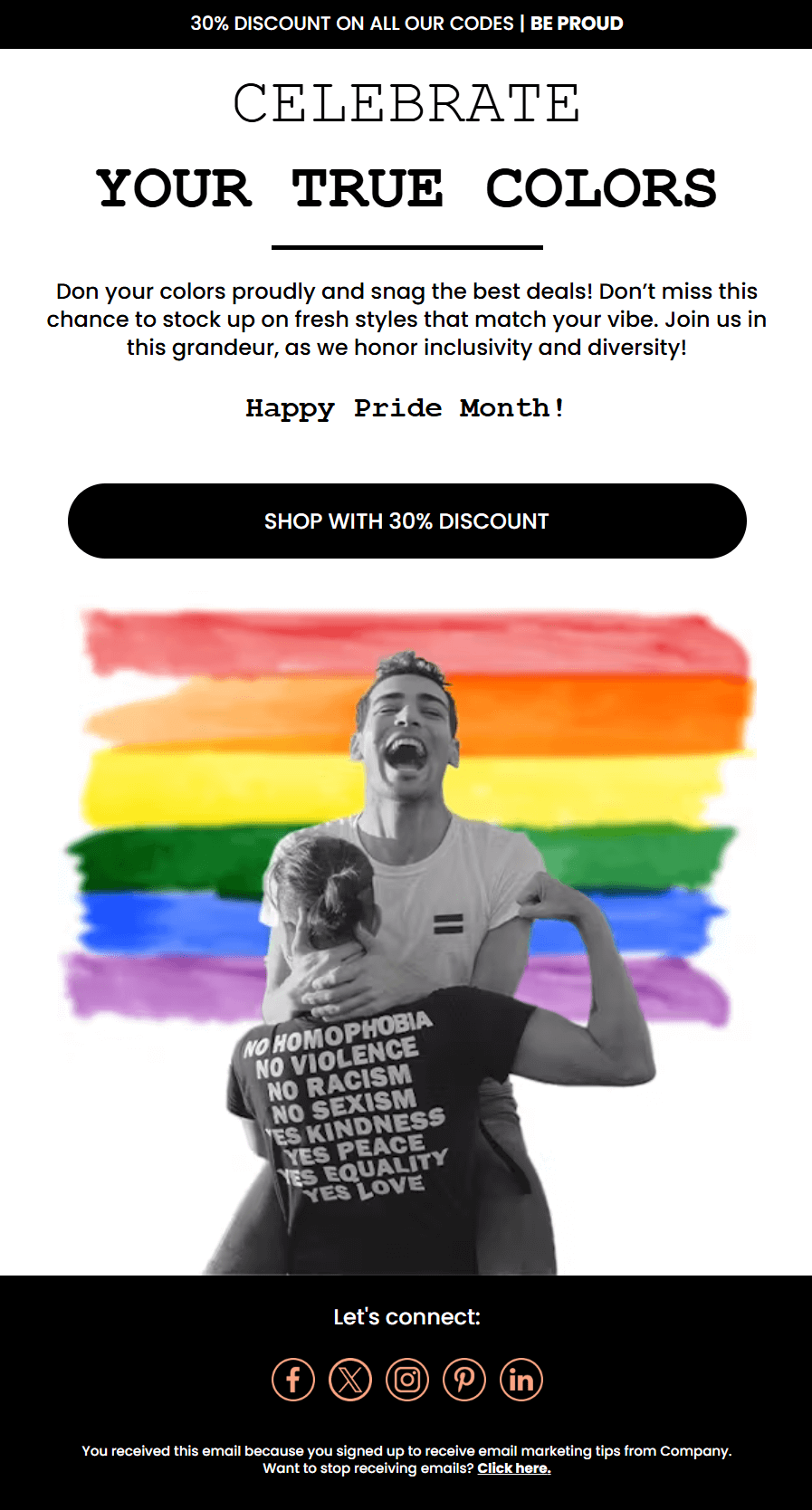
For a more engaging campaign, add a donation link, a note about where proceeds go, or a brief statement of support.
Subject line ideas to use:
- Pride with Purpose: See How We’re Giving Back
- Celebrating Pride Month, Backed by Action
- Our Pride, Our Commitment, Beyond Just a Logo
- This Month, Every Color Counts
Inner rainbow newsletter template
This template is perfect for beauty brands looking to highlight colorful products.
The layout has clear sections featuring vibrant visuals and simple descriptions, each supported by a bold CTA button. The mid-section introduces a spotlight product, and the email wraps up with a photo collage for visual impact.
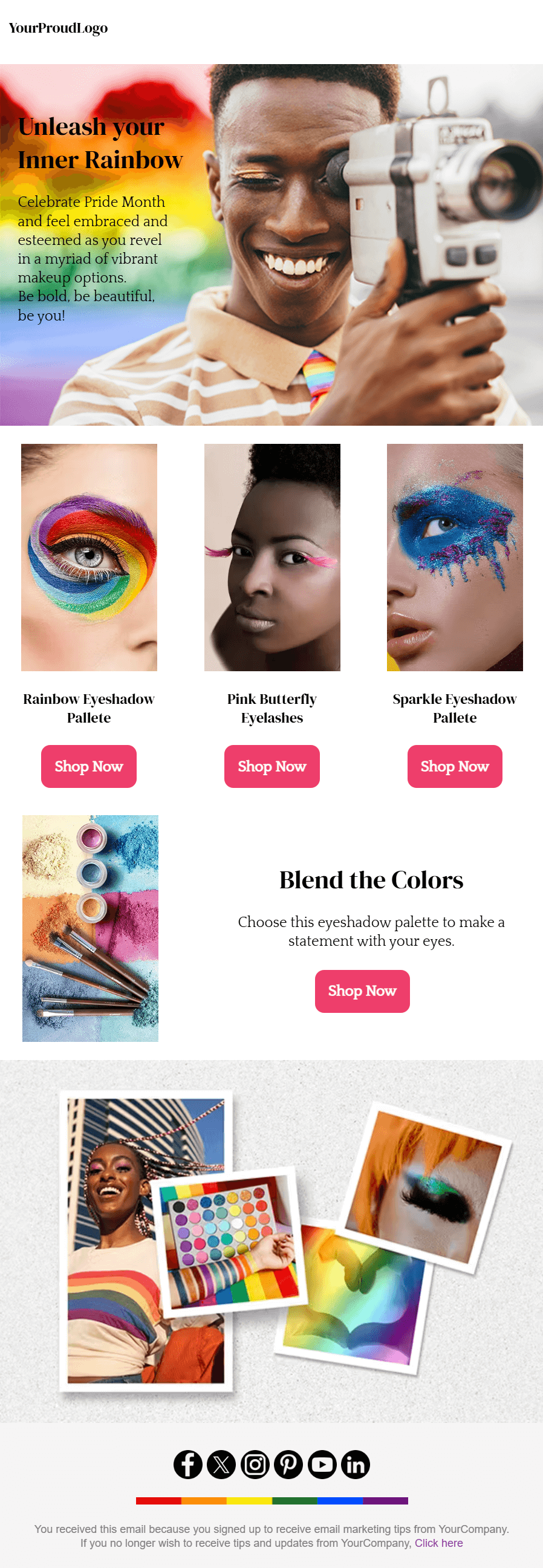
To avoid performative marketing, brands should pair this format with action highlights or quotes.
Email content ideas:
- Include a short bio or quote from an LGBTQIA+ artist, model, or collaborator featured in the campaign.
- Add a short section or link to a blog post or video showing how the campaign was created, especially if LGBTQIA+ talent helped shape it.
- Insert a testimonial or social photo from a real customer expressing themselves with your products during Pride Month.
- Offer a link to an LGBTQIA+ advocacy organization or educational content related to Pride.
Rainbow for all newsletter design
This Pride-themed template is vibrant and visually engaging, structured around bold colors and playful product highlights.
The header introduces the theme with a welcoming title and a short paragraph encouraging self-expression and authenticity. Each product section features styled imagery paired with a quick description and color-coded CTA buttons like “Pick a Hue,” leading the reader through a visually guided journey.

Consider modifying the CTA and copy to reflect purpose-driven messaging for a more respectful and balanced approach.
CTA suggestions for impactful campaigns:
- See Who Made This
- Support LGBTQIA+ Creators
- Shop With Purpose
- See the Story Behind the Style
- Gifts That Give Back
- Shop Inclusive Essentials
For more, take a look at our Seasonal email designs and Nonprofit email templates.
Pride Marketing Do’s and Don’ts
Now that we’ve explored how to run a meaningful Pride campaign, let’s summarize the essential dos and don’ts to help you avoid common missteps.
Do’s
- Reflect internal values in external messaging.
- Support with donations, partnerships, and volunteer efforts.
- Involve LGBTQIA+ voices in your content and planning.
- Be transparent about the impact and where the support goes.
- Share year-round efforts, not just June visibility.
- Maintain inclusive policies and safe environments.
Don’ts
- Don’t launch campaigns without internal backing.
- Don’t use identities for aesthetics or sales only.
- Don’t ignore backlash, but address it with accountability.
- Don’t go silent after Pride Month ends.
- Don’t rainbow-wash with no substance behind it.
Rethink Pride Month Marketing
Pride Month reminds us of the ongoing fight for visibility, equality, and acceptance. If your brand plans to participate, do so with purpose. If not, it’s better to step back.
LGBTQIA+ audiences and their allies are paying attention. And they don’t need more rainbow packaging or vague promises. They want real support, honest messaging, and actions that continue beyond June.
So, before you plan a campaign, ask yourself: Are we doing this because we care or because it’s profitable? If it’s the latter, you should find another way. Luckily, June offers numerous other opportunities to do so.
Enterprise search software has become a powerful tool for modern businesses. As companies adopt more digital tools, finding data when it matters is difficult, since it is scattered across different places.
Without an enterprise search tool, employees would struggle to locate the information they need amongst emails, documents, messages, etc. On top of that, customers would have an underwhelming experience as they would get irrelevant matches to their queries.
This blog post will help you understand what enterprise search platforms are, how they work, as well as the best enterprise search tools in the market.
What is Enterprise Search Software?
Enterprise search software is a tool that allows users to search, access, and retrieve information from across multiple data sources, both internal and external, in one centralized interface. These sources can include documents, emails, databases, intranets, cloud storage, CRMs, ERPs, wikis, and more.
Search software can be either customer-facing such as a search bar letting users browse your website’s content, or internal allowing your team to access business information, documents, logs and more. The most powerful enterprise search engines use machine learning, natural language processing as well as AI to understand the intent behind each query and provide relevant, insightful answers.
Key Benefits of Using Enterprise Search Software
Enterprise search tools offer several key benefits for businesses. Here are the most important:
- Increase productivity by reducing the time spent searching for information
- Enhance decision-making with quicker access to critical data
- Help with compliance and governance by locating sensitive documents
- Reduce duplicate work by making knowledge reusable and visible
- Improve customers’ on-site experience
Types of Enterprise Search Software
Enterprise search software comes in several forms, each designed to meet specific organizational needs. Here are the most common types:
- Federated search: It aggregates search results from multiple sources (e.g., databases, cloud apps, intranet) without moving or duplicating the data. This type is ideal for companies using many disconnected systems that need a unified search experience.
- AI-powered search: It uses artificial intelligence, machine learning, and natural language processing (NLP) to understand user intent and deliver smarter, more relevant results. It often includes personalization, predictive suggestions, and semantic search capabilities.
- Insight engines: A more advanced form of AI-powered search that can surface insights by analyzing content contextually. Useful for decision-making, knowledge management, and strategic planning.
- Open-source search platforms: Flexible and customizable solutions that can be tailored to your business’s infrastructure and needs. Best for companies with strong in-house development teams who want full control over implementation and data handling.
- Embedded search tools: They offer hybrid functionality, powering both customer-facing search on websites and internal enterprise use. Ideal for businesses wanting to serve both employees and end-users through one platform.
Key Features of Enterprise Search Software
When evaluating enterprise search solutions, there are several key features that you should look for.
- Unified indexing and connectors: They should be able to crawl and index data from a wide range of sources such as email platforms, cloud storage, intranets, CRMs, ERPs, and knowledge bases, providing unified access to information from a single interface.
- Role-based access and permissions: Security features can help protect sensitive data and uphold data privacy regulations. Also, top enterprise search tools give you granular control over who can access certain repositories.
- Machine learning and AI: With the power of generative AI and machine learning algorithms, enterprise search tools can understand human queries and deliver more accurate results. This functionality also enables conversational search.
- Real-time indexing and updates: Changes to content should be reflected in search results almost instantly. This ensures that information available to employees and customers is accurate and trustworthy.
- User-friendly interface: An intuitive search interface will help with adoption. Ideally, the platform should have easy filtering, natural language processing, and the ability to auto-suggest results.
- Analytics and search insights: Admins and content managers should have access to usage data such as popular queries, zero-result searches, and click-through rates to identify content gaps and improve discoverability.
- Flexibility in deployment: Whether cloud-native or hybrid, the enterprise search solution should offer smooth integration with your existing tech stack and require minimal development resources for setup.
How Does Enterprise Search Work?
Enterprise search software works by connecting into different data sources and making them searchable from one place. Instead of opening multiple apps or digging through folders, users and employees can type what they need into a single search bar and instantly see relevant results. The software keeps everything in sync so that even new or updated files are easy to find.
Behind the scenes, it organizes and “remembers” where everything is, while also respecting who’s allowed to see what. It understands natural language, so users don’t need to know exact file names, just a few words or a phrase is often enough. The more it’s used, the smarter it gets, learning what people are looking for and improving results over time.
8 Best Enterprise Search Solutions
By now, you must have a pretty good understanding of enterprise search software and how it can help your business. Now, let’s see the top search tools available in the market.
1. Sitecore Search
Pricing: N/A
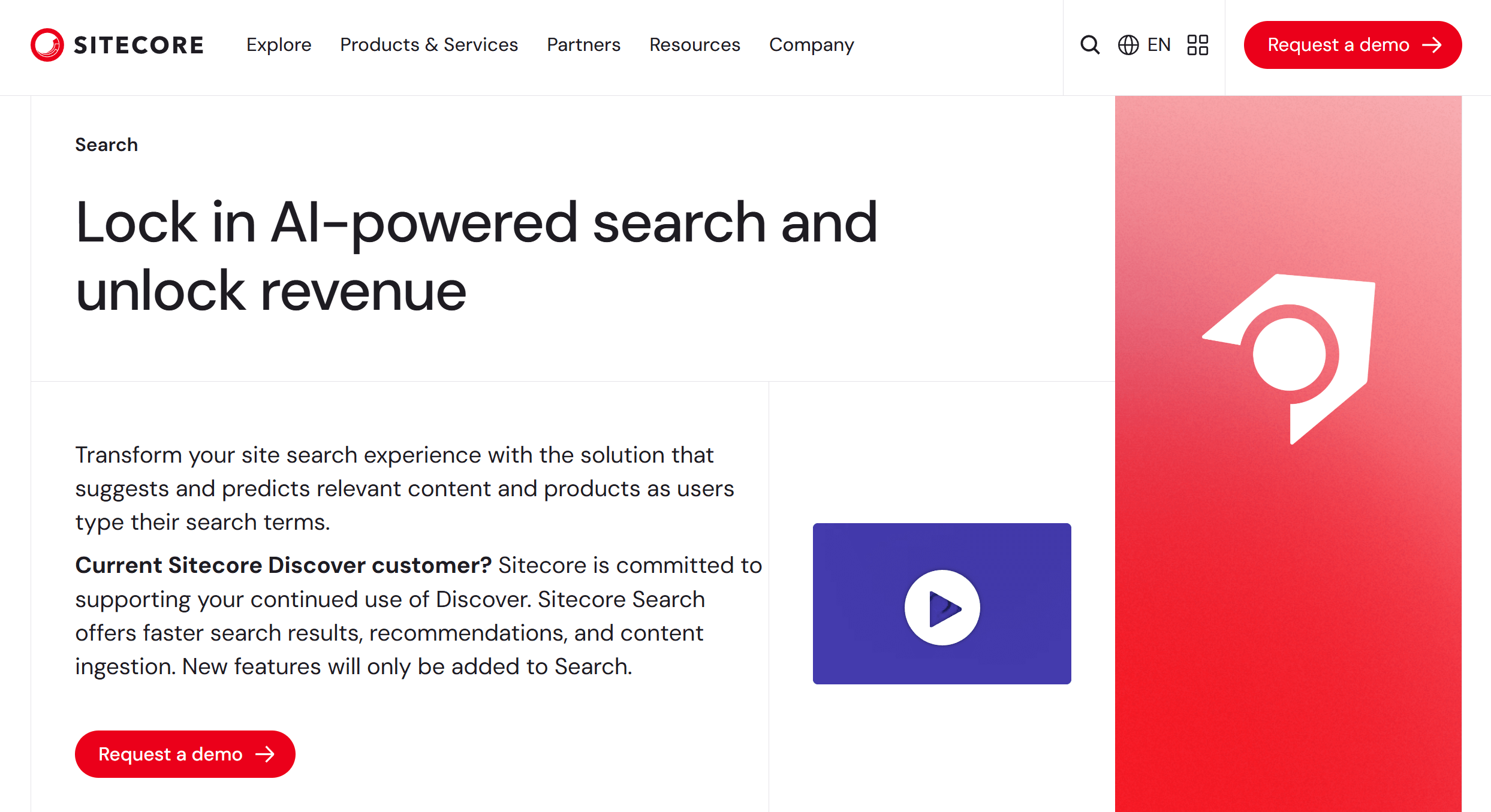
Sitecore Search is a powerful site and content search solution designed for customer-facing websites, including eCommerce storefronts. It delivers fast, personalized, and AI-driven search experiences, making it ideal for brands using Sitecore CMS to enhance product discovery and content engagement.
While it offers enterprise-level scalability, Sitecore Search is not a traditional enterprise search tool meant for internal document or system-wide data retrieval. Instead, it excels in indexing and serving website content, blogs, documentation, and product listings. Thus, it’s a smart choice for brands focused on delivering tailored search experiences to their customers.
Best Features
- Personalized search results based on user behavior
- Index content across your website, blogs, documentation, and product listings
- Predictive search
- Fast, real-time indexing
- Search analytics (to optimize your content strategy)
2. Findbar
Pricing: Plans start at about $132/month
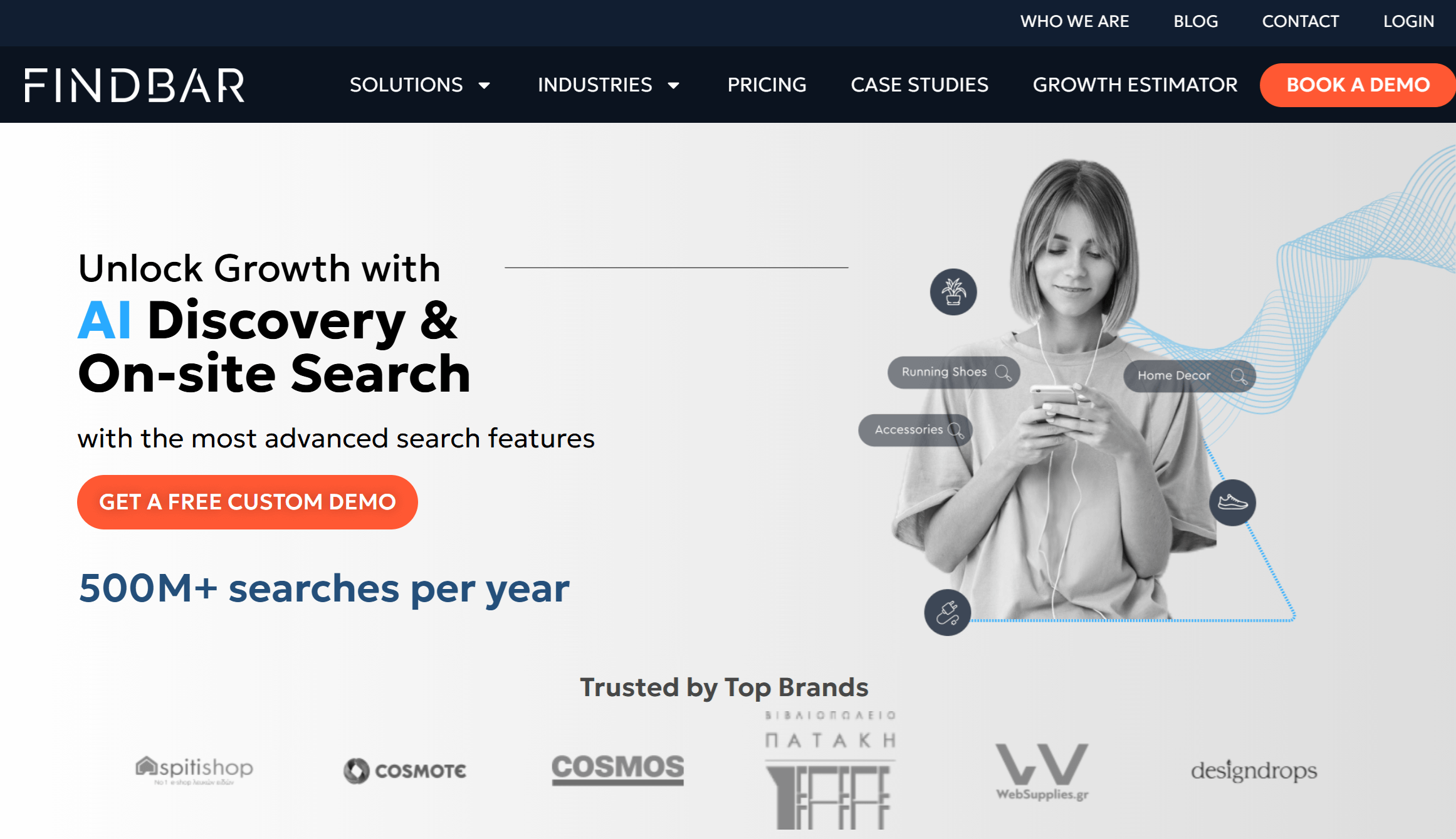
Findbar is an AI-driven enterprise search solution designed for eCommerce businesses that want to enhance product discovery, boost conversions, and monetize search experiences. It focuses on plug-and-play simplicity, offering a suite of features ideal for industries such as fashion, groceries, home goods, pharmacies, and more.
With its AI image search, customers can find what they need simply by uploading an image. They can also find similar products through AI visual recommendations. What’s more, you can provide autocomplete suggestions and make every search count despite having typos (fuzzy search). Findbar also equips you with voice and barcode search, taking your website’s search UX to the next level.
Best Features
- AI image search and visual recommendations
- Fuzzy search
- Search as you type
- Smart ranking
- File preview and quick actions
3. Coveo
Pricing: N/A
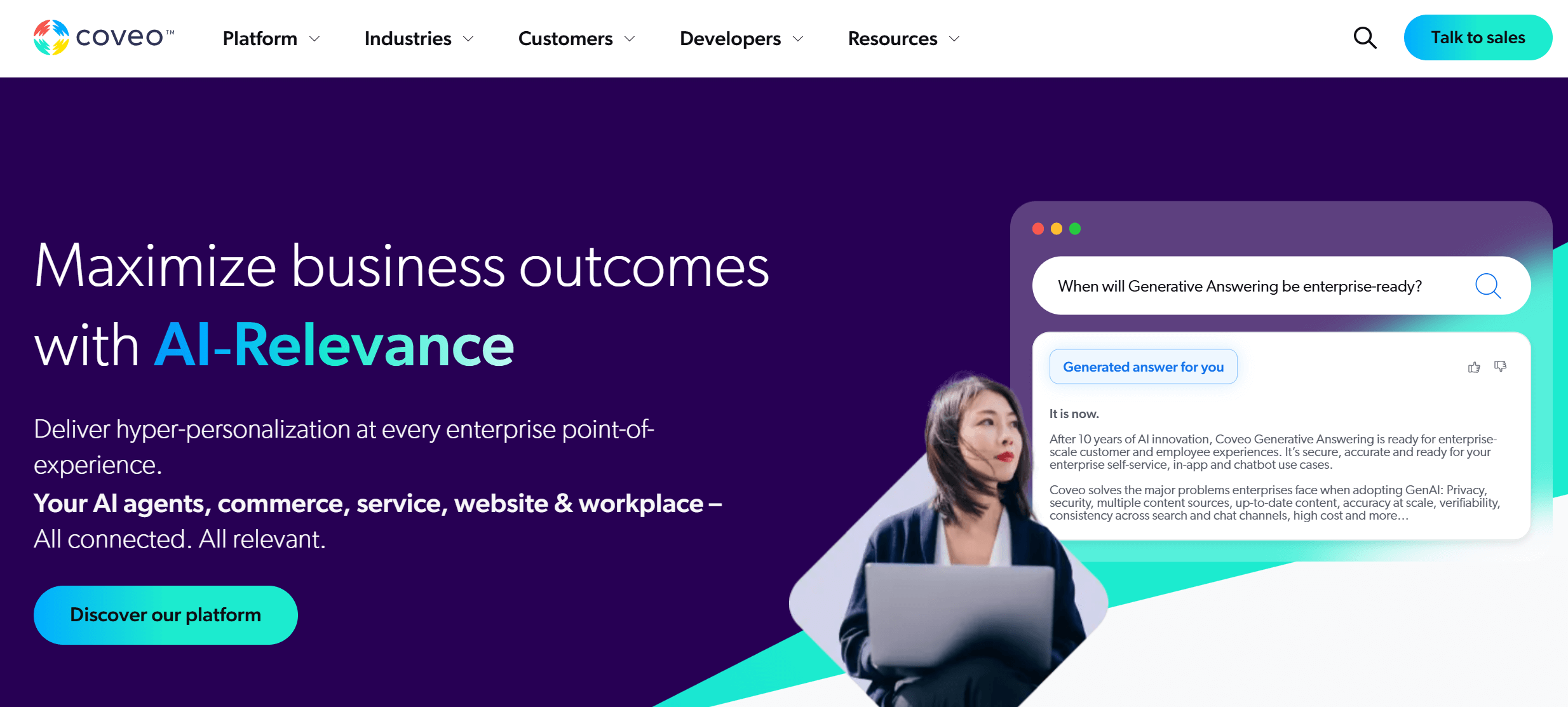
Coveo is a cloud-based AI enterprise search platform designed to unify and personalize digital experiences across various touchpoints, including websites, eCommerce platforms, customer service portals, and workplace applications. Through advanced machine learning and natural language processing (NLP), Coveo delivers contextually relevant content, enhancing both employee productivity and customer satisfaction.
This solution integrates seamlessly with various enterprise systems such as Salesforce, ServiceNow, Microsoft 365, and more. This allows unified indexing, aggregating content from multiple sources into a single index. The tool can also answer questions, providing accurate responses to user queries.
Best Features
- Semantic product search
- Unified Indexing
- Personalized search experiences
- Advanced analytics
- Cloud-native architecture for scalability
4. Glean
Pricing: N/A
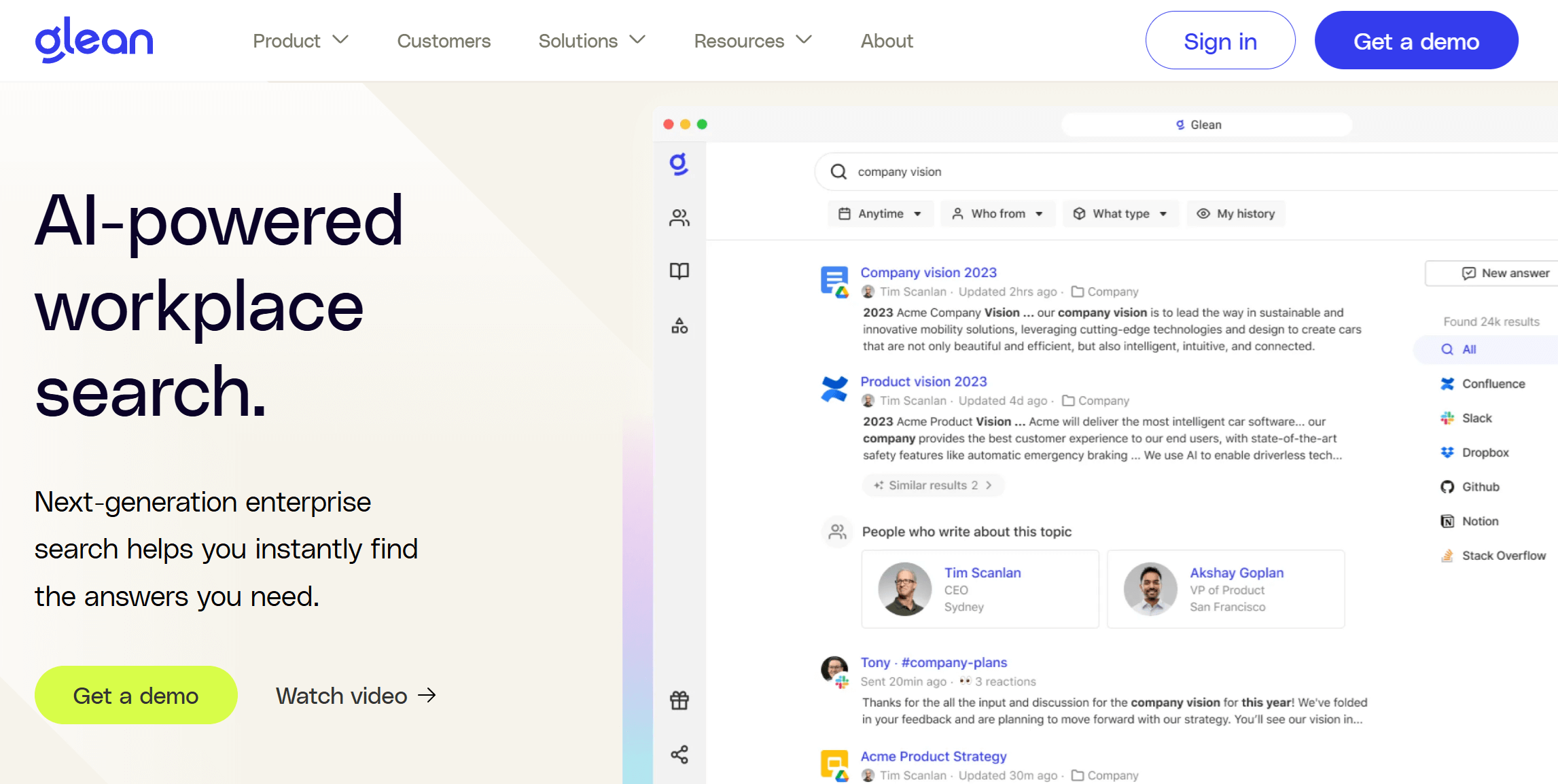
Glean is an enterprise AI search solution designed to personalize information discovery across an organization’s entire digital ecosystem. It uses large language models (LLMs) to generate concise, context-rich answers to user queries, summarizing information from various sources.
The platform supports real-time indexing with permission controls, displaying only the information users are authorized to see. It can connect with a wide array of enterprise tools, reducing the need to switch between applications. Finally, it supports compliance with standards like SOC 2 Type II, GDPR, and CCPA, ensuring data privacy and protection.
Best Features
- Generative AI-powered summaries
- 100+ connectors
- Real-time indexed results
- Robust security and compliance
5. Algolia
Pricing: N/A, free plan available

Algolia is an AI search suite built to handle vast amounts of data, delivering lightning-fast search results with high relevance. The platform supports standard search functionalities such as filtering, faceting, and result ranking, enabling users to find the information they need with ease. Its AI algorithms support dynamic synonym suggestions, ensuring that users find the right content even when using varied terminology.
Its developer-friendly environment provides robust APIs, front-end libraries, and integrations, allowing teams to build and customize applications seamlessly. Additionally, Algolia offers a user interface with a user-friendly dashboard and API control for reporting, workplace search, UX management, configuration, and A/B testing.
Best Features
- AI browsing for category pages and product listing pages
- Advanced personalization
- AI ranking to identify and boost popular content
- Merchandising Studio to create personalized shopping experiences
6. Guru
Pricing: Plans start at $18/month, 30-day free trial
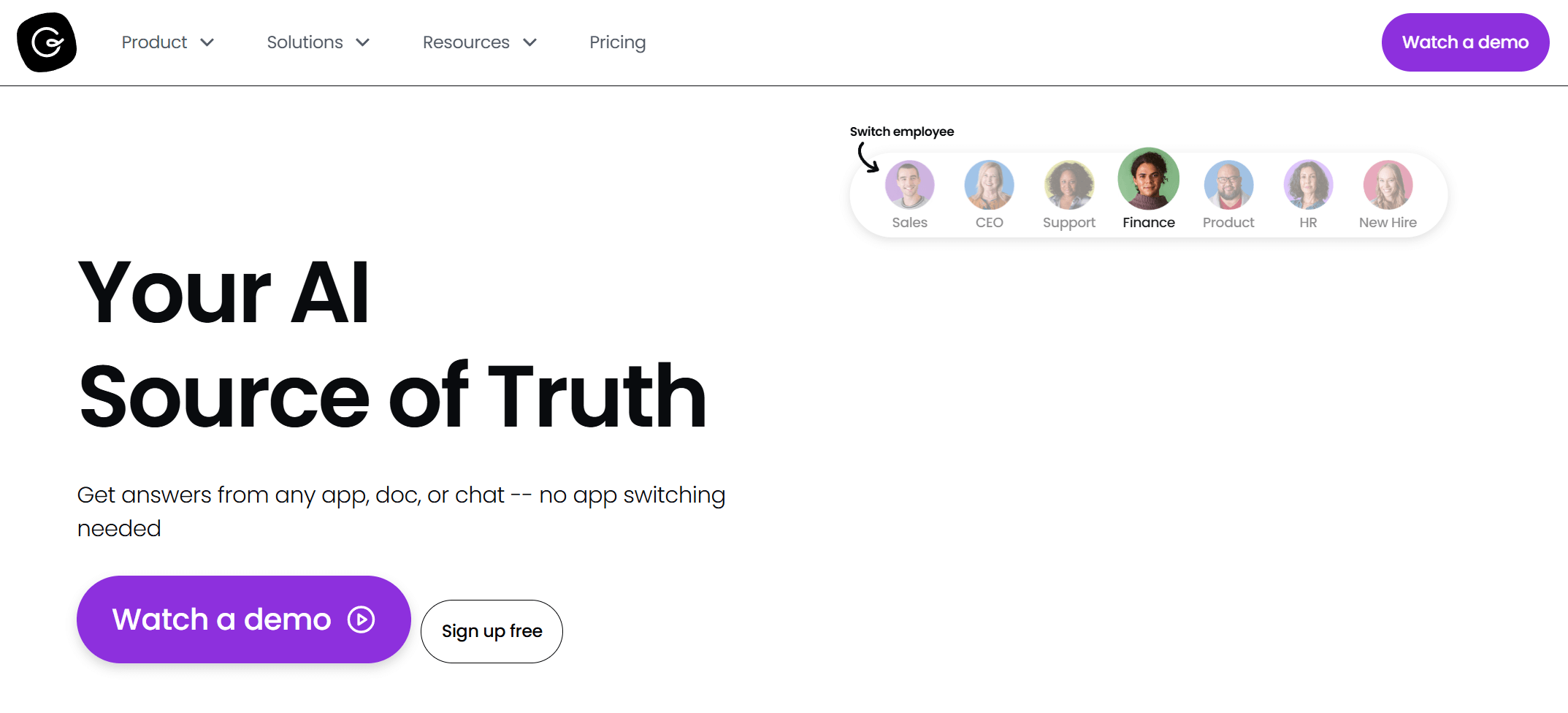
Guru is an enterprise search solution built for internal teams that need fast, accurate access to organizational information. It’s designed to work where employees already collaborate like Slack, Microsoft Teams, and web browsers, so they can get answers without breaking their workflow. Guru is especially useful for support, sales, and operations teams that rely on accurate, up-to-date knowledge to serve customers or complete tasks efficiently.
With its AI-powered suggestions, Guru surfaces the right content in context, reducing time spent searching or asking around. Teams can verify knowledge for accuracy, track usage, and ensure information stays current through smart alerts and knowledge lifecycles. Plus, Guru offers browser extensions and in-app cards, so knowledge is always just a click away.
Best Features
- AI-powered in-context suggestions
- Browser extension for instant answers
- Knowledge verification and expiration alerts
- Slack and Teams integration
- Search across docs, wikis, and apps without switching tabs
7. Elasticsearch
Pricing: Plans start at $95/month
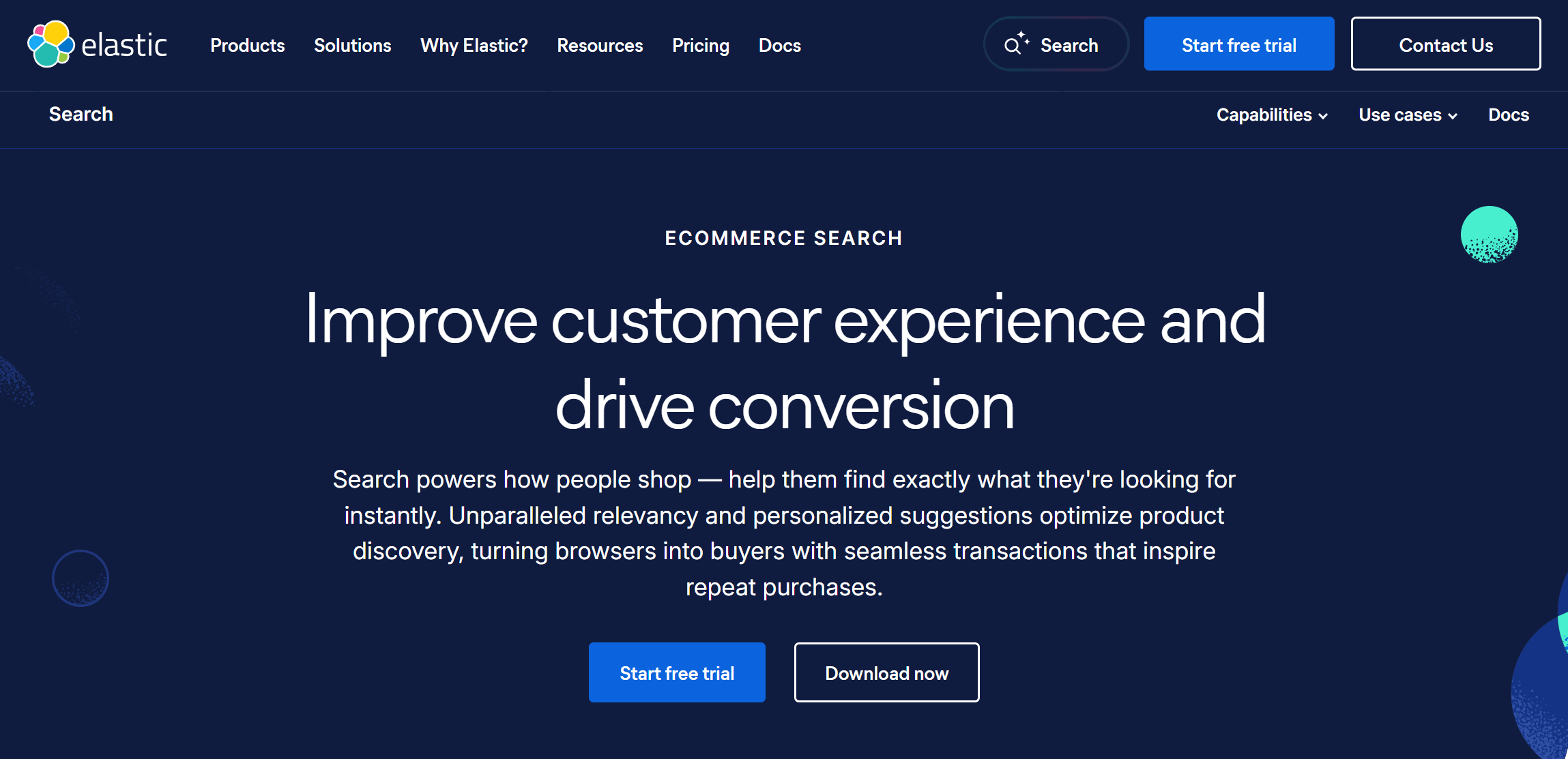
Elasticsearch is a flexible, hybrid enterprise search solution ideal for both internal enterprise search and customer-facing product discovery. This makes it a great choice for brands looking for full control and customization.
With its real-time indexing, Elasticsearch enables up-to-the-second search accuracy across massive product catalogs. It supports advanced filtering, faceting, and autocomplete, and its built-in machine learning capabilities help personalize results and detect anomalies. Whether you’re optimizing on-site search or connecting siloed internal data, Elasticsearch adapts to your needs through APIs, plugins, and integrations with popular eCommerce platforms.
Best Features
- Real-time indexing for large catalogs
- Custom relevance tuning and ranking
- Autocomplete, filtering, and faceting
- Hybrid use for internal and customer-facing search
- Machine learning integration for personalized results
8. Lucidworks
Pricing: N/A
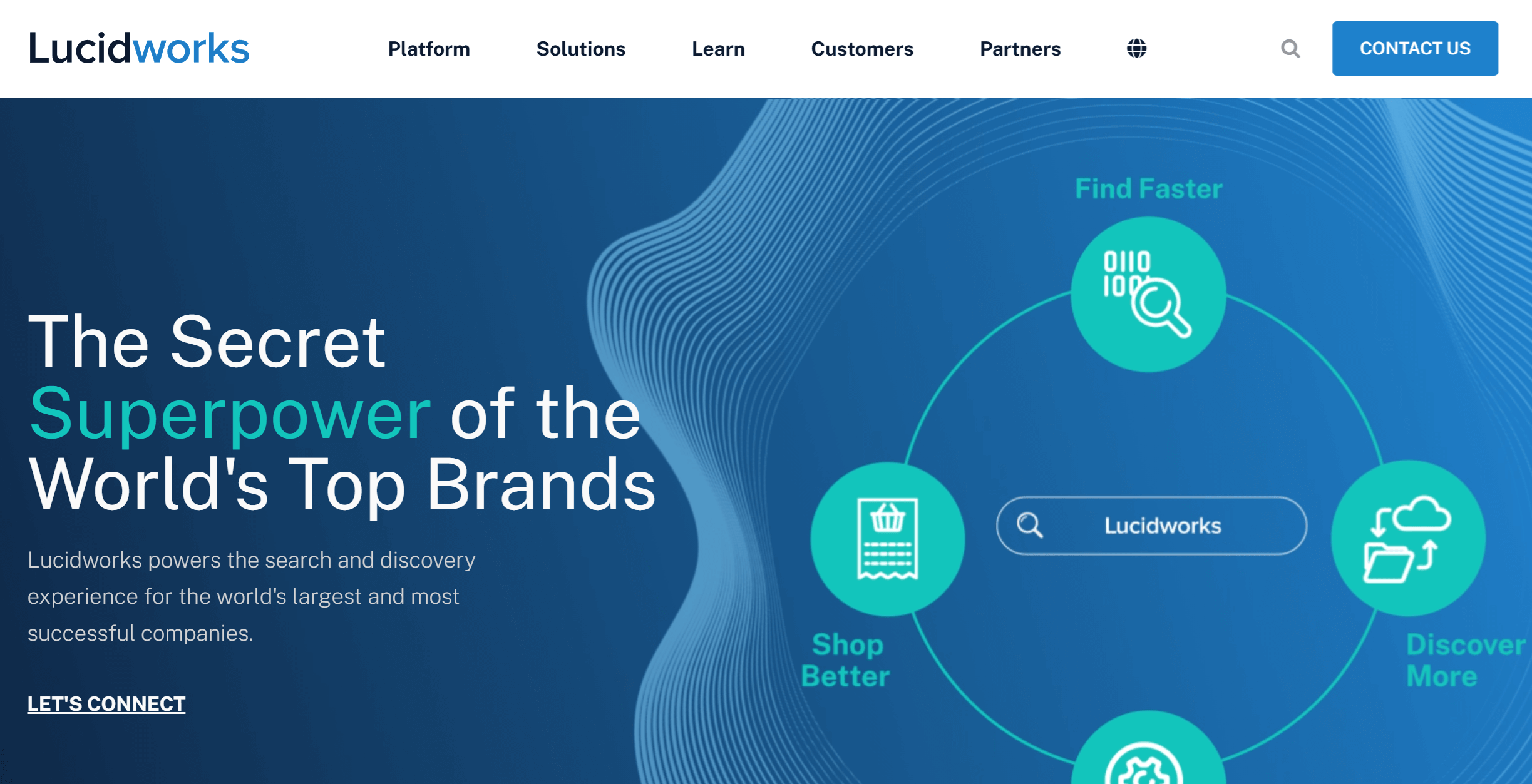
Lucidworks is an AI-powered enterprise search and product discovery solution. Through machine learning, it understands shopper intent and personalizes product pages and suggestions based on individual preferences. It can also interpret natural language and populate webpages with the right product assortment, eliminating zero-result searches.
With Lucidworks, you can also deliver smart answers via your chatbots and virtual assistants. Its AI continuously learns from user behavior to refine search results, increase conversions, and enhance digital experiences across eCommerce sites. Built for scale, Lucidworks is a strong fit for enterprise retailers seeking relevance, speed, and personalization in one unified platform.
Best Features
- Intent-based product recommendations
- Smart chat and virtual assistant
- Natural language understanding
- Automatic query refinement
Choosing The Right Enterprise Search Software
Whether you’re looking to improve your customers’ shopping experience or boost employee productivity, an enterprise search solution is the key to reaching your business’s full potential.
Consider the available options carefully, evaluate their features, and check whether their pricing plans fit your budget. The right tool can transform the way your team works, eliminating data silos, speeding up decision-making, and unlocking more value from the information you already have.
What’s the first thing that pops into your head when you need a quick boost in sales? If your answer is throwing a discount, you’re not alone. But there’s a catch. Do it often, and your customers will start to expect it. Worse, they’ll stop buying, until there’s a new discount.
Brands can boost engagement, create urgency, and increase sales without cutting prices. The “No-Sale Sell” strategy will help you enhance your campaigns with psychological cues and visual elements that make them feel fresh, exclusive, and irresistible.
Why Sending Too Many Discounts Can Hurt Your Business
Everyone loves a good deal, but discount-heavy emails often come with a price. Customers feel reluctant with brands constantly overloading them with discounts and consider their content spammy or non-credible.
Here are some of the negative effects a brand overplaying this tactic faces:
- Decreased product value: Consumers start questioning the true value of your products and services and may assume that prices are inflated.
- Email fatigue: Overflooding subscribers with emails can lead to high unsubscribe rates and spam complaints, putting sender reputation and email deliverability at stake.
- Reduced profit margins: Discounts boost short-term profits but can lead to long-term profit loss if customers purchase only during sales.
- Blurred brand reputation: Customers may start perceiving you as a bargain brand, instead of a premium and high-quality solution.
Thankfully, by delivering value through quality email content and personalized experiences, brands can maintain their credibility and build long-term customer loyalty without relying on discounts.
10 Email Strategies to Increase Engagement Without Discounts
The “No-Sale Sell” email marketing strategy can take many forms based on your goals. Here are 10 converting strategies to delight your audience without discounts for various customer desired actions:
1. Offer personalized product recommendations
Instead of sending discounts in bulk without considering customer information, prefer personalized email campaigns that meet your customers’ needs. Gather important data about your audience, using a CRM solution and email marketing software to target them with relevant messages.
Through dynamic content and custom fields, send relevant product images and descriptions to capture their attention. You can also segment your email lists based on demographics and location, among other factors. For instance, send personalized product recommendations based on purchase history or categories they’ve recently browsed through your website.
Your copywriting should address them directly–phrases such as “Top picks for you” or “You’ll also love” add a personal touch. Want to add a sense of urgency to maximize your email engagement rates? Label your products as seasonal exclusives or soon out-of-stock.
Misfits Market chose a different angle to bring in that effect. They shared the top picks of a head chef to motivate subscribers to go to checkout, capitalizing on the trust necessity:
Subject line: Bobby Flay’s Favorite Finds

Sale emails are usually simple to craft as their main message focuses on the discount. But to grab subscribers’ attention without similar incentives, you need more complex and interesting design.
Moosend offers premade email templates to save time without compromising quality. Plus, it comes with e-Commerce tools, such as automation, dynamic content and behavior tracking to nail personalization.
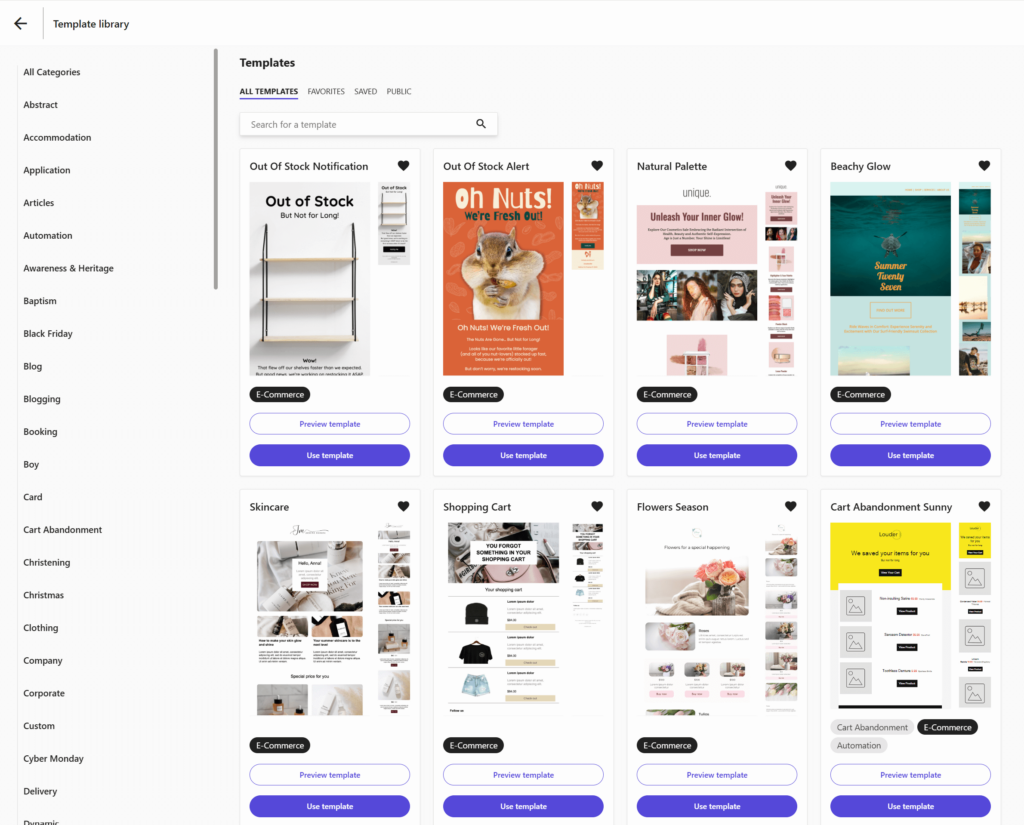
2. Promote best-selling items
Your bestsellers are your business’ biggest assets. Adding them to your email marketing campaigns will entice new subscribers or remind old ones what they might be missing, without exclusive offers needed.
Sharing bestselling products signals to your audience that you want them to have the best of what you offer. Step into their shoes and show them how these products will fit in their life, including the pain points they can tackle. Include reviews, success stories, or use cases and images of people using them to make them visualize the benefits.
To add more urgency, share seasonal bestsellers or gift-guides to boost sales with a copy cue to grab them before they’re gone. Plus, consider adding a best-selling section on welcome emails to increase conversion rates.
Check out this email campaign by Boundary Supply. The combination of best-sellers, reviews, and “Shop now” call-to-actions do the trick. Plus, the emoji on the email subject line can yield more open rates.
Subject line: 🏆 Top Features on Top Sellers

3. Reframe existing products
You don’t need a product launch to grab your subscriber’s attention for good. Instead, reinvent your existing products to give them a new meaning and tie them to a specific theme.
For example, create an email campaign with summer essentials or a Christmas gift guide to drive sales during a high peak season. Product bundles are also popular among consumers. Build a product kit to cater to customers’ needs and save them time from searching for products elsewhere.
When tied with limited time labeling these marketing efforts can yield more sales. To build anticipation, insert a mystery box to direct more people to your website to see the product bundle and get one step closer purchase.
Hawthorne created an amazing Father’s Day email campaign with personalized product bundle recommendations for distinct types of dads, engaging email subscribers to the max. Can you do something similar with your products?
Subject line: Meet our all new dad bundles

4. Send interactive email content
Interactive emails have gained solid ground in the digital marketing world. Through quizzes, polls, and puzzles, subscribers interact with the email content in real-time through hovering, tapping, or clicking. The result? Another great no-sale sell trick to boost email engagement without discounts.
When combined with product recommendations or customer feedback, these email campaigns can boost engagement metrics. For example, new customers can answer a short quiz to find the product that best suits them based on their preferences.
These email types require more coding expertise to set up and functionality that is not supported by all email service providers and ISPs. However, a similar effect can also be replicated with simpler tactics, such as adding a GIF or an infographic with a quick quiz.
Natalist chose a creative way to make the content more interactive by sharing a static quiz with product recommendations for different needs:
Subject line: Guess what? It’s quiz time!

5. Create urgency without dropping prices
Incentives such as flash sales or exclusive offers create a sense of urgency and boost click-through rates and conversions. You can also instill that FOMO effect and direct customers to checkout using other techniques, keeping discounts for sales periods, such as Black Friday or summer.
Early access to limited edition or new products can motivate subscribers to buy. These initiatives are great for loyal customers as they create a sense of exclusivity. Add a countdown timer to show when access their will be over to double that effect.
Send back-in-stock emails for best-sellers or customers’ favorite products to incentivize customers to claim them before they’re gone. Sending timely seasonal emails, such as on Mother’s or Valentine’s Day, with gift guides and recommendations can also yield sales. Create follow-ups for disengaged or last-minute customers, offering more options, such as gift cards to cater to different needs.
Here’s a fitting example from 1906 New Heights. Their back-in-stock email is enhanced with an urgent CTA followed by a “Don’t wait for them to sell out again” note.
Subject line: BACK IN STOCK: Pain Gummies

6. Announce upcoming product drops
Product announcement emails can build excitement around new entries, make subscribers root for them, and even add them to cart. Introduce your product drops through visually appealing emails with high-quality images.
To make it even more engaging, send a teaser email with a countdown timer to create mystery around upcoming products. You don’t need to show the products in this phase, just share some hints to make it more fun. Promote the teaser on other platforms, such as social media to gain more traction.
You can also build a waitlist to send follow-ups to specific subscribers excited about the new products and highly likely to purchase them. Or give early access to VIP customers to boost their loyalty.
Here’s a great teaser email example by Nissan:
Subject line: It’s a masterpiece you have to see
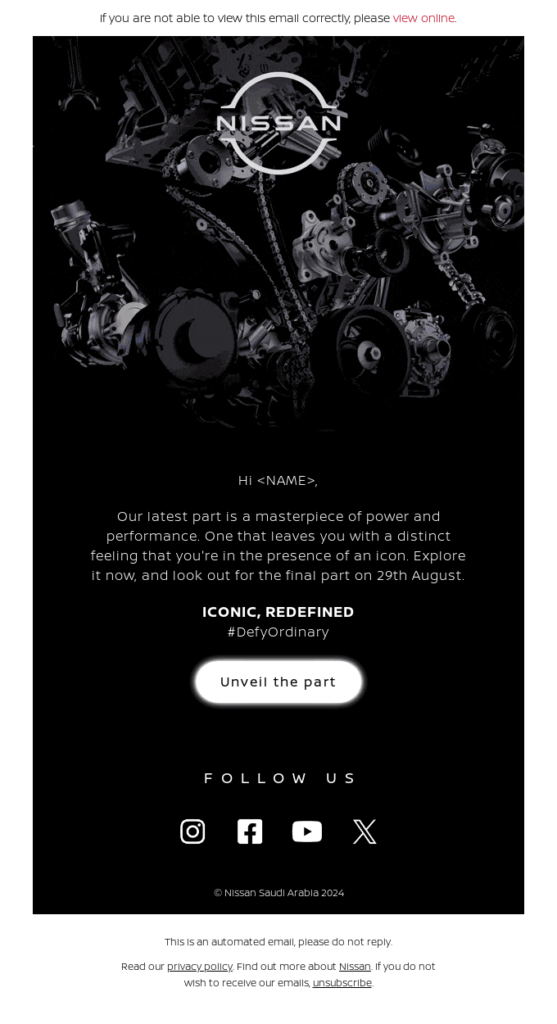
7. Refresh your email design
Using the same email design and elements is good for consistency. But when subscribers see the same email again and again their brains tune out. That’s why it’s important to make slight changes to revamp your email style without altering your core messaging.
For example, try new seasonal colors or enhance your email design with a GIF. You can also use dynamic content to share relevant images to readers based on certain factors, such as demographics or preferences, to build email engagement without discounts needed.
If you’re unsure about new visual elements, use A/B testing to see what works best for your audience. Plus, ensure that images or interactive elements are responsive for mobile devices to maintain a great user experience.
To diversify their email style, Starbucks dressed up in Christmas colors to join the festive spirit and delight the audience, sticking to their color palette:
Subject line: Get holiday faves + a 🎁 tomorrow!

8. Create educational content
Consumers get confused when receiving product recommendations and discounts from a brand regularly and become suspicious of the brand’s intents. Instead of overflooding them with promotion-heavy emails, show them how to make the most of your products through educational email campaigns.
Sync your email and content marketing tools to go in-depth with valuable tips or information about your product. You can also use marketing automation tactics to create a nurturing email series with tutorials. For example, a beauty brand can create a sequence with information about their skincare ingredients, benefits, and beauty tips to make the audience wait for more.
Moosend recently announced the website redesign with an email series, showing our customers how to use the platform features to revamp their emails:
Subject line: ✨ Makeover Alert: Ready to Wow?

9. Send customer testimonials
Social proof is an important conversion tool. It helps win the audience’s trust and yield sales faster, without needing coupons or discounts. Sharing reviews or testimonials on emails is a great way to build engagement.
Focus on customer reviews highlighting the benefits of your products or services. You can also partner with influencers with a similar target audience to earn more trust points. If you’re in B2B, share case studies or scores from review sites such as G2.
Apart from sending dedicated review email campaigns, add social proof on other promotional emails as well. For instance, place them next to product recommendations or re-engagement emails to win people back.
Expert input is always a great addition. Bubble shared reviews from dermatologists to show their product formulas are clinically proven:
Subject line: DERMS KNOW BEST…

10. Evoke emotion through storytelling
Good emails don’t have to be product oriented. Storytelling can enhance all types of emails despite their intent. Regarding engagement, story-based emails can move your readers and make them fond of your brand.
Start by sharing story-based campaigns during important celebrations, such as Thanksgiving or Christmas, or certain milestones, such as company anniversaries, to see how subscribers react. Plus, honor customer turning points, such as one year since the first purchase.
Finally, share personal stories as WeTransfer did to inspire your audience:
Subject line: A set of stories to kickstart your ideas

Begin Your No-Sale Sell Journey
Which tactic from the above would you implement first and how would you enhance it? Think of your target audience and what appeals to them to craft email campaigns that leave a lasting impression, without hurting your long-term profit.
Finally, schedule re-engagement campaigns to maximize conversions and practice different tactics to see what works best. When consistency meets variety, conversion is steady.
Looking for eye-catching and responsive email newsletter templates to kickstart your email marketing strategy? You’ve come to the right place!
But why do you need newsletters? Well, apart from the fact that email marketing is one of the most cost-efficient channels, it’s effective for organic content distribution, too. Nevertheless, designing everything from scratch often gets time-consuming.
And there’s always a chance you’ll run out of inspiration at some point. Having the right email newsletter templates in place saves the day, regardless of the occasion.
So, are you ready to create impactful email campaigns without a major investment in time and effort?
Here you will find 77 wonderful email templates for eCommerce, SaaS, publishers, product promotions, hotels, events, and real estate. Plus, seasonal and milestone newsletter templates to engage your audience all-year-round and throughout their journey.
How to Get Moosend’s Free Email Newsletter Templates
To gain instant access to the templates, follow these simple steps:
- Sign up for a free Moosend account.
- Click on the “Campaigns” tab and select the type of campaign you need to create. These are the options: Regular, RSS & Repeatable, and Transactional.
- Tap on the “New” button at the top right corner, and then pick the campaign type. Let’s say you go with the Regular one.
- Define the basic settings like the campaign name, subject line, and preview text.
- In the “Design” step, click the “Start designing” button. You’ll be directed to the template library of the editor where you can preview and use any of the professional email newsletter templates.
- Select the newsletter template you like and customize it using the drag-and-drop editor.
You can also use the email template builder to create your own newsletter templates from scratch, save them in your library, and reuse them whenever you like.
Now let’s meet the family, shall we?
1. eCommerce Newsletter Templates
Newsletters are the backbone of eCommerce email marketing. To help you out, we’ve collected a variety of designs to nurture and convert your target audience with beautiful layouts.
Now let’s see some responsive email newsletter templates for cart recovery, promotions, sales, offers, and more.
Minimal Cart Abandonment Email Template
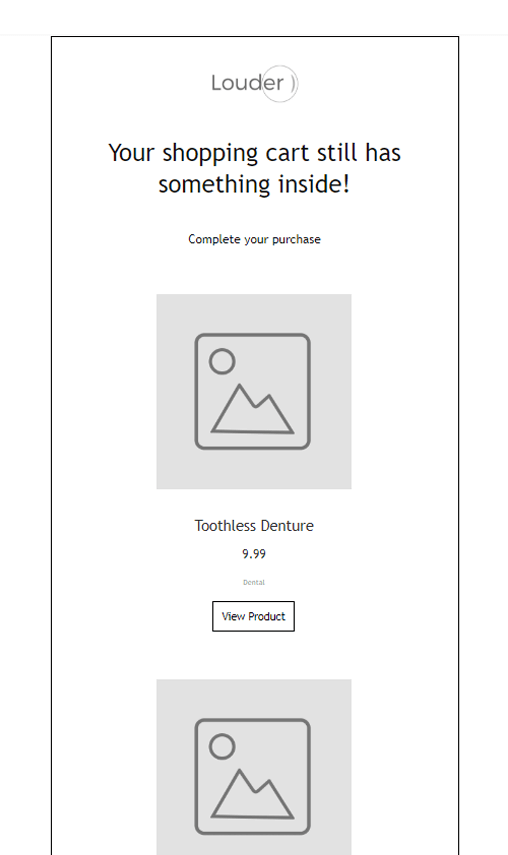
Starting with something simple, this cart abandonment template is perfect for restoring your lost revenue. Due to the lack of extravagant elements, this design will look great on multiple email clients like Outlook, Gmail, and Yahoo.
Design tip: Since this template favors white space, you can easily tailor it using your brand colors and product images. Also, make sure to use a bright color for your CTA to catch your recipients’ attention.
Why you need it: Super easy to customize (no coding skills required) and mobile-friendly layout. With a compelling subject line and actionable copy, you’ll bring users where you need them: back to their shopping cart.
Black & White Cart Abandonment Newsletter Template

If you want something more design-wise, then this template is just what you need. The above example is full of elegance, using the classic combination of black and white. The best part, though, is the red CTA that stands out no matter what.
Design tip: Add a beautiful visual on the top to make your campaign more appealing. While you can include different colors, keeping the black-and-white scheme will boost the visibility of your call-to-action. Just make sure to pick a contrasting color to make it pop.
Why you need it: Due to its simplicity, you can combine it with other email newsletter templates and add it to your abandoned cart series through Moosend’s marketing automation workflow builder.
Indigo Cart Abandonment Design Example
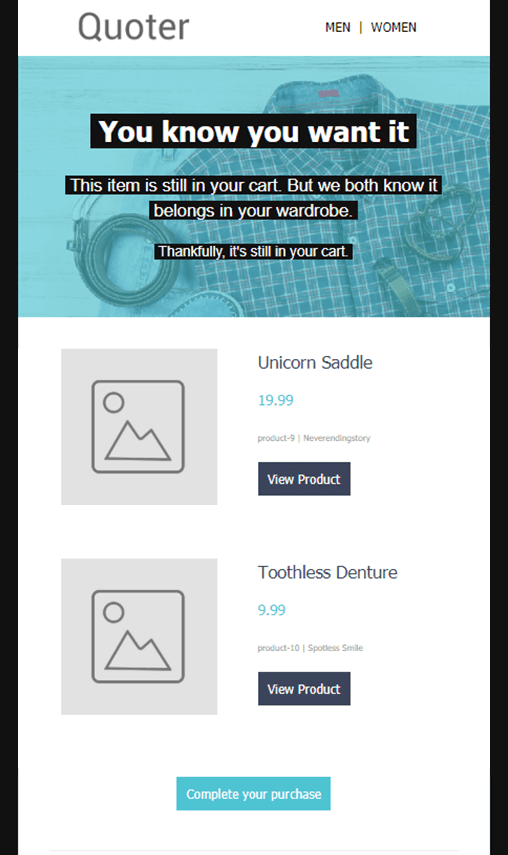
Love color? Us too! Here’s a cart abandonment template with a lovely color scheme. If you pick it, you can add your own visuals, play around with different palettes, and insert your product blocks. Besides that, this newsletter template already has a “Need some help?” section to allow your customers to reach you if they have questions.
Design tip: This template gives you all the freedom you need to incorporate extra elements. To increase urgency, consider equipping the design with a countdown timer, which is a key strategy to prompt immediate action.
Why you need it: The layout is great for large and small businesses that want to quickly set up an effective abandoned cart email for their customers.
Stylish Shopping Cart Recovery Email Template
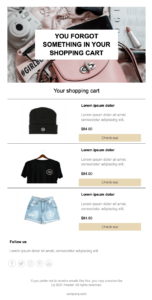
Nail your cart recovery efforts with this modern cart abandonment design. A template with clean layout but stylish is exactly what you need to highlight the abandoned products. No fluff, no distractions!
Design tip: Using a strong header works wonders, grabbing attention from the start. Combine it with a structured listing with high-quality product images to help subscribers focus on their items. You may use the “Follow us” section to increase visibility on key social media channels.
Why you need it: Far from being a plain cart abandonment template, it helps you create a digital storefront with a familiar look and feel. Plus, the well-structured layout leading from one element to another offers an intuitive reading experience-especially for mobile users.
Pop Abandoned Cart Newsletter Template
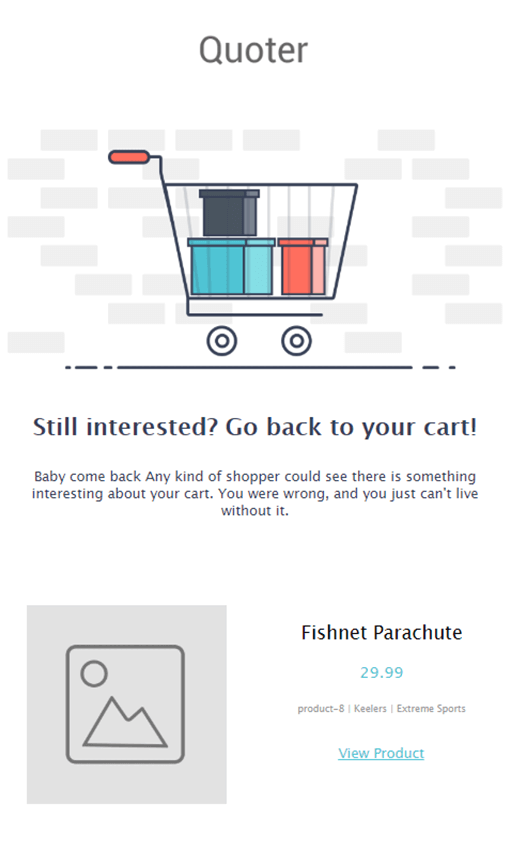
What makes this template pop is the shopping cart GIF on the top. Adding high-quality visuals is a must-have email marketing practice to entice your recipients. Here, you can insert a relevant image or an eye-catching GIF. Also, you have the option to ask customer reviews to increase the credibility of your online store.
Design tip: Use visuals and GIFs that match your newsletter design and overall branding. White space and clear calls-to-action will also keep your copy tidy and focused on the action your recipient needs to take.
Why you need it: The customer review section is, undoubtedly, the best part of this template. Also, using social media buttons will help you drive engagement on more touch points.
Ocean Blue Cart Recovery Email Template
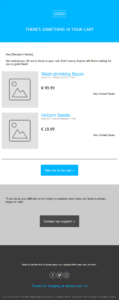
Throwing in a splash of color is key to grabbing attention. With this template, you place the abandoned products at the heart of your campaign so the reader knows what to do as soon as they open it.
Design tip: While blue is a soothing color, you can choose something more vibrant to get your customers to take action. For a more pleasing and coherent result, you can also match your header with your CTAs. The addition of an option to contact the support team is a clever way to build trust.
Why you need it: Whether you have some good email newsletter design skills or not, you can tweak colors and other elements with the super-friendly email builder. The result? An effective cart abandonment campaign that you can reuse as many times as you need.
Sunny Cart Recovery Email Newsletter Template
Our last cart abandonment template favors yellow and grey to catch the shopper’s attention. Here, the design allows you to place your main CTA above the fold. And you should since it ill give you greater chances of converting your audience.
Design tips: Yellow is a peculiar color that stands out by itself. If you want to change the color scheme, pick colors that complement it, such as grey, pale pink, or navy blue. All that’s left to turn the focus on your products is use compelling newsletter images that remind readers of the items they left.
Why you need it: This free email newsletter template is easy to customize, saving you time and letting you focus on other, more demanding tasks.
Out of Stock Alert Newsletter Template

Who says an out of stock email has to be plain? This fun and straightforward newsletter template uses bright colors and clear clear copy to guide the reader towards the focus point. This is a great example of how to communicate that a product is out of stock while reassuring your audience that it will be available soon.
Design tip: This template is easy to scan with separate sections, each serving a different purpose: the visual punch, the message, and the call-to-action. If it matches your brand personality, you could use playful color schemes, light-hearted visuals, and relatable copy to keep things fun.
Why you need it: The clean and straightforward design makes detecting key points easier. Moreover, adding your logo, unsubscribe option, and contact details prominently in the footer leads to a polished design that boosts trust.
eCommerce Weekly Offer Template Example
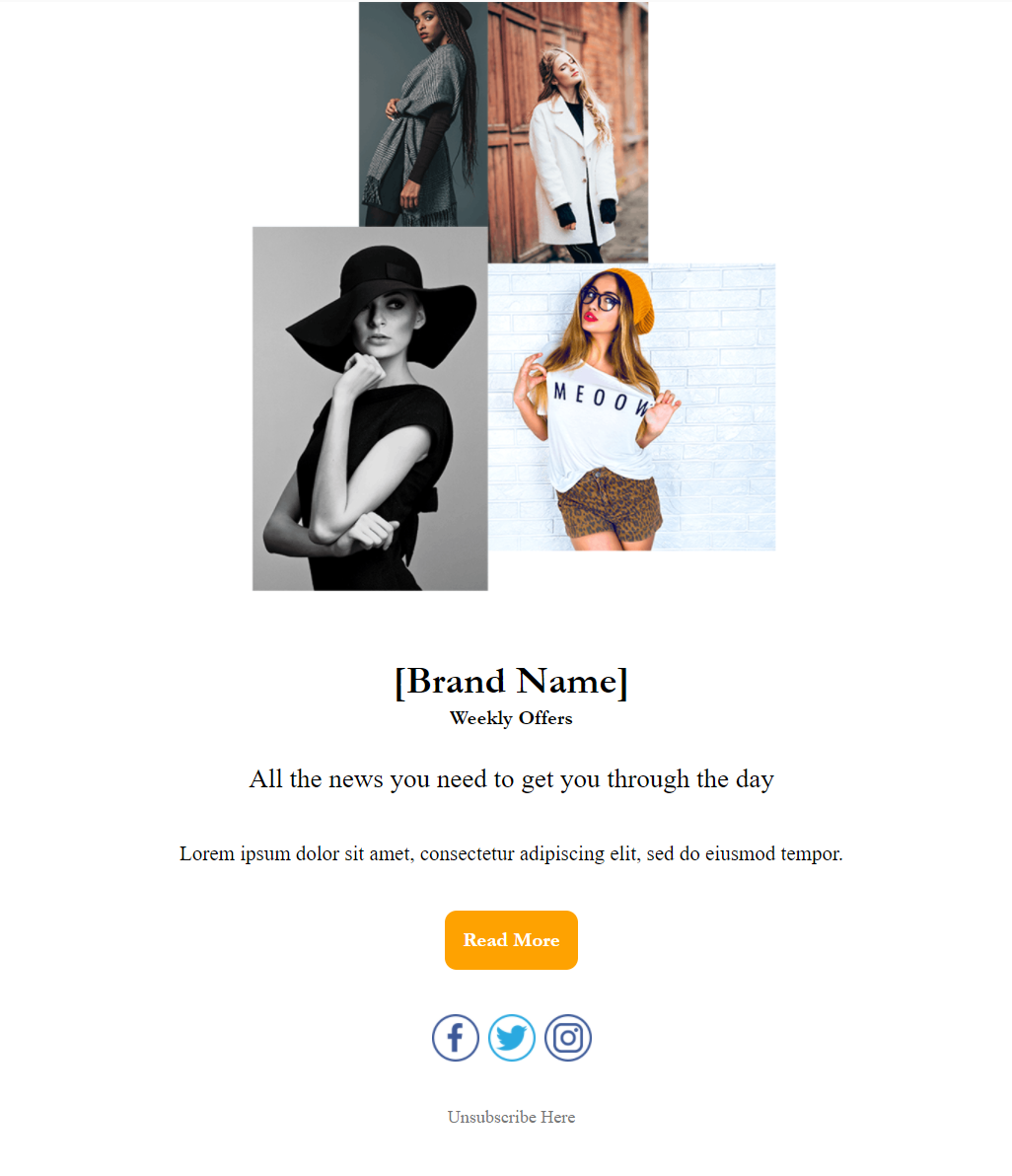
Simplicity is the ultimate sophistication. Embrace it! As people have a very short attention span, you need to create email campaigns that are easy to digest in a few seconds. The above template is perfect for that. You can use it to promote new products or give your audience updates and weekly offers.
Design tip: Use high-quality product images and matching graphic elements to intrigue your subscribers. If you are good with design marketing tools like Adobe Photoshop, create relevant PSDs, export them as PNG or JPEG files, and then upload them through the editor.
Why you need it: This newsletter template gives you all the creative freedom you need. You can use it as a starting point to design an eye-catching and mobile-friendly campaign in a few minutes.
Special Offers Email Newsletter Template
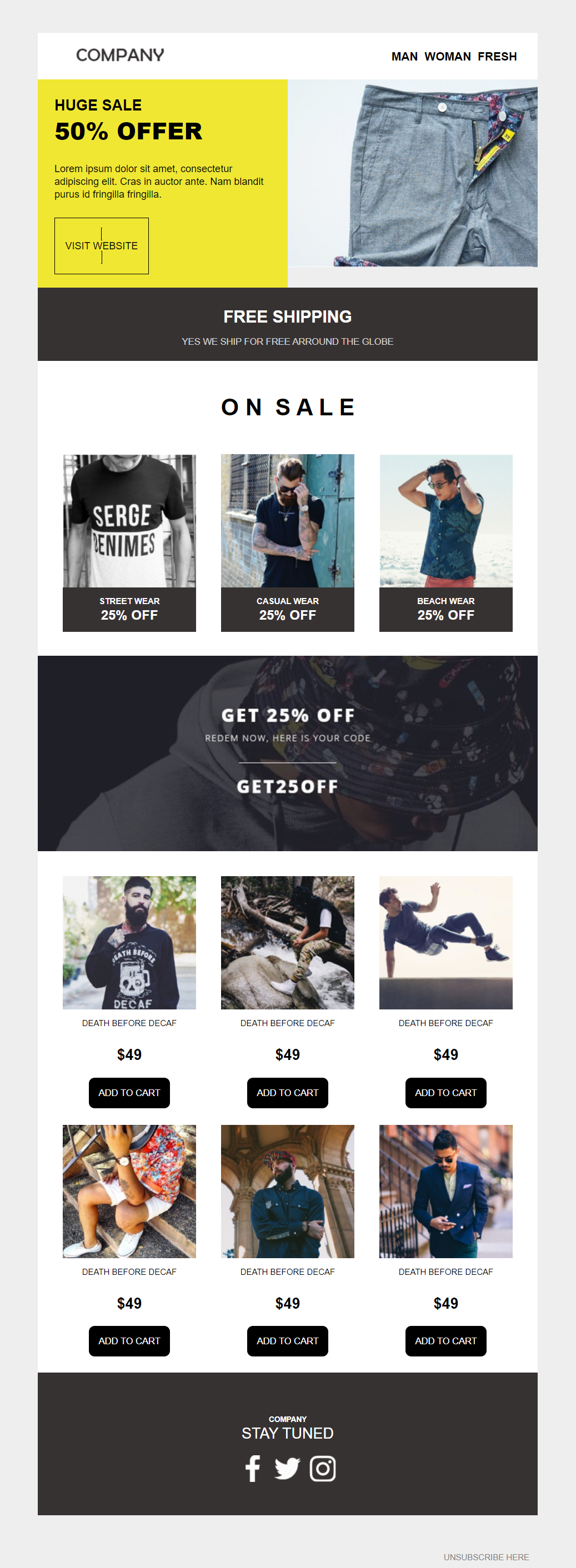
Planning a sale and need a quick email design to make it happen? This template has all the elements you need to create a sales campaign for your audience. You can customize it to your liking and add as many product blocks as you like.
Design tip: Sales are wonderful but don’t forget to make your campaign urgent to convert your deal-hunting customers! A countdown timer is perfect for making it happen. An effective way to boost conversions is to include a similar “Free shipping” section, removing a common pain point for consumers.
Why you need it: This newsletter example has a great layout that allows you to showcase special offers and products. You may choose to include a few key categories to ensure recipients don’t feel overwhelmed with too many options.
Monthly Offers Email Template Example

Targeting your audience with valuable messages is the best way to lead them a step further down your sales funnel. You can customize the above template for your eCommerce store to inspire your subscribers and increase your sales.
Design tip: Having too many elements in your email design could make or break your campaigns. In case you go for just a few elements, first of all nice move. The next step is to make everything perfect and clean. So, add high-quality product images and enough color contrast to make your most important elements stand out.
Why you need it: Overall, this is an exquisite template to promote multiple products without overwhelming subscribers.
Newspaper Style Email Newsletter Example

Sometimes it’s not about promoting products or announcing sales but sharing tips and tricks with your audience. When this time comes, make sure to use the above design. This template will allow you to create a unique newsletter to intrigue your subscribers.
Design tip: White space is your friend. Always! Here, you can add colorful visuals to promote your products, and the result will simply be stunning. Also, you can easily personalize your unsubscribe link using CSS (Cascading Style Sheets). Find out more about how to do it here.
Why you need it: The layout keeps things simple, which makes it perfect for informing your readers and leading them to action.
2. Product Email Templates
Product marketing emails lay at the heart of your email marketing strategy. The key is to create a clear message and showcasing the value of your promotion.
Instead of wondering what you should and shouldn’t include, start with product newsletter templates designed to convert. Whether it’s to announce new features or promoting new arrivals, here are some professional product newsletter examples to inspire you.
Modern eCommerce Product Placement Template

Modernity and minimalist design can really work wonders. So, use the above layout to send your subscribers a beautiful email campaign featuring your products in a simple and structured way.
Design tip: Use sharp images without backgrounds to amplify your campaign and give your subscribers something to remember. Also, including helpful blog content (if you have a blog) is a nice touch to further engage them.
Why you need it: This is a very modern and refreshing email newsletter template to step up your product marketing strategy.
Single Product Promotion Newsletter Design
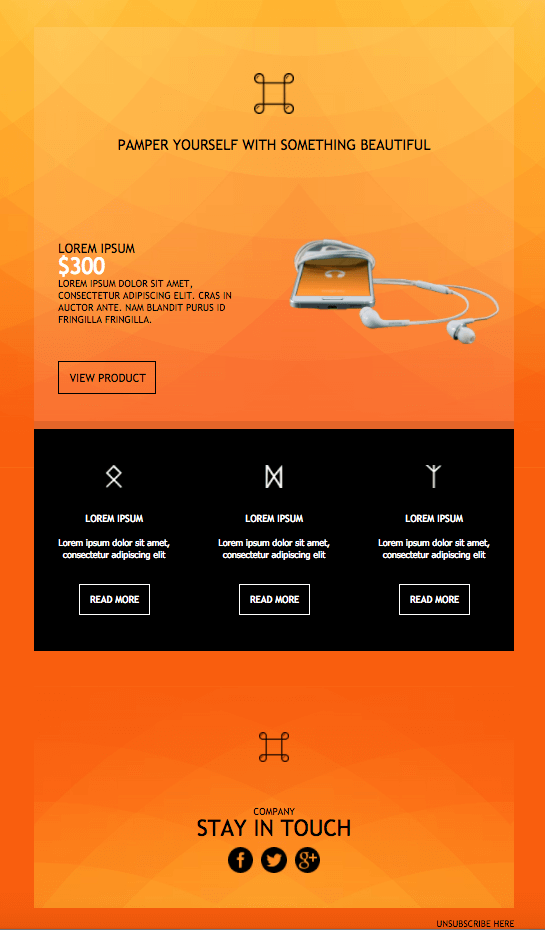
Now it’s time for the colorful newsletter examples. With the right combination of vibrant colors, you can charm your recipients and persuade them to act on your message more easily.
Design tip: Bold colors are great to catch the reader’s eye. However, make sure to use the right fonts and font colors to make your copy stand out, too. Also, consider adding advanced elements like countdown timers and social media buttons to enhance the effectiveness of the template.
Why you need it: This email example will give your new product the attention it needs to convert potential shoppers at first glance.
Image Gallery Email Newsletter Template
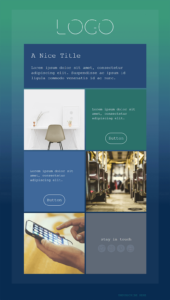
Another clever idea is to combine enticing product images or even videos with concise product descriptions to break up content. Here’s where such an image gallery template could serve you, allowing for a successful combination of the two. Plus, a “Stay in touch” section fosters engagement, giving readers contact options.
Design tip: Invest in clear hierarchy by using different colors or fonts to separate content blocks. Placing your logo prominently at the top ensures brand recognition. Solid email newsletter software lets you add your own logo to every campaign and customize the rest of the design to be aligned with your branding guidelines.
Why you need it: This product image gallery template uses a design that favors the Z-pattern, helping the reader digest the message. Simply put, it’s a great choice if you want to engage your audience during regular or seasonal promotions.
Product Promotion Template
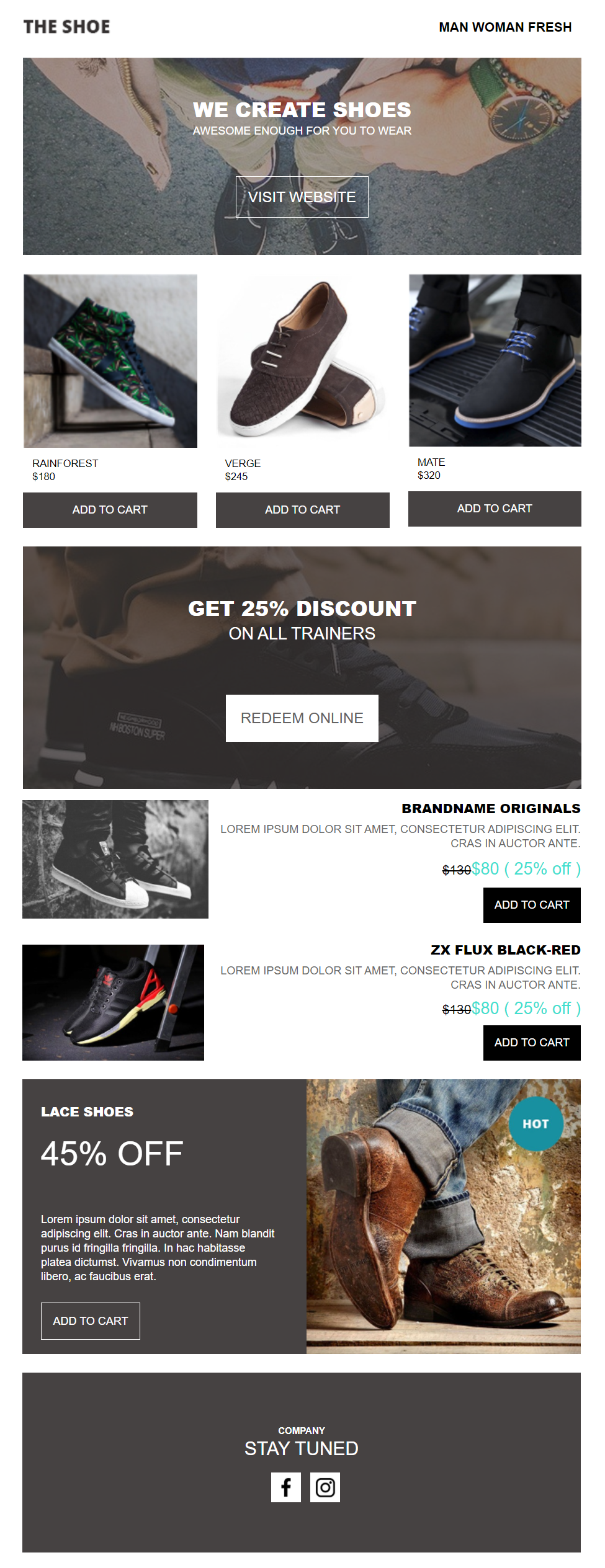
Looking for a great template to promote your products? Here’s the design you need. While this example is created with footwear in mind, you can easily customize it with the email builder to display your products in the most appealing way.
Design tip: You can use the drag-and-drop tools to move the different elements around, change the color scheme, and add branded components. If your CTAs are on top of your visuals, pick bright colors to make them stand out more.
Why you need it: This product-oriented template will help you create converting email marketing campaigns for your online business. Just add your products, powerful copy, and action-oriented CTAs, and wait for conversions.
Natural Palette Product Newsletter Template

This product promotion newsletter template soothes the reader’s eye with its soft pink tones. It’s designed to promote cosmetics, which makes it perfect for creating effective beauty brand emails. However, you can get inspired by its fresh design and use it to showcase your top-rated or brand new products-regardless of the industry.
Design tip: Use plenty of white space and beautiful product images to make the featured items the protagonist of your email. Add short, matching descriptions to help subscribers quickly grasp the benefits of the products. To maximize the chances of conversion, craft CTAs that contrast with the background.
Why you need it: With this product newsletter template, you can create email promotions that are both aesthetically-pleasing and effective. If you have discounts that go along, the dedicated section at the bottom will encourage readers to benefit from them.
Black & Yellow Product Promotion Template
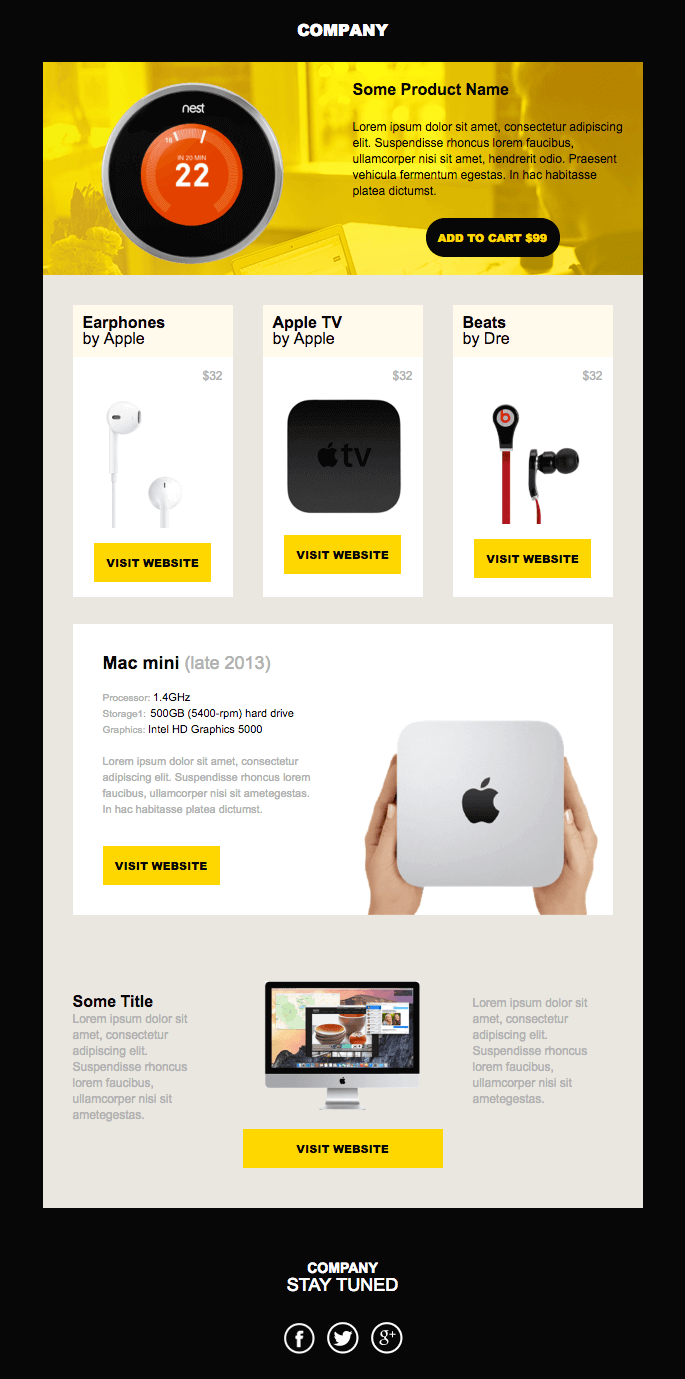
Now let’s take a look at this beautiful black and yellow product promo newsletter.You can use it to charm your recipients with beautiful images and provide relevant product information.
Design tip: This newsletter template has all you need to showcase your products. To make it more attractive, you can add a customer review section or star ratings. Plus, you have the option to feature an FAQ section to give your audience a seamless experience.
Why you need it: The beautiful colors, effective layout, and symmetry of this design will help you create a top-notch email marketing campaign.
3. SaaS Email Newsletter Examples
SaaS email marketing needs thorough planning and professionally designed campaigns. But does this mean that you have to create everything from scratch? Well, no!
Ready-made, carefully crafted SaaS newsletter template will save you valuable time. In this section, we’ll see various designs that you can customize and use on the spot.
Company Introduction Email Template
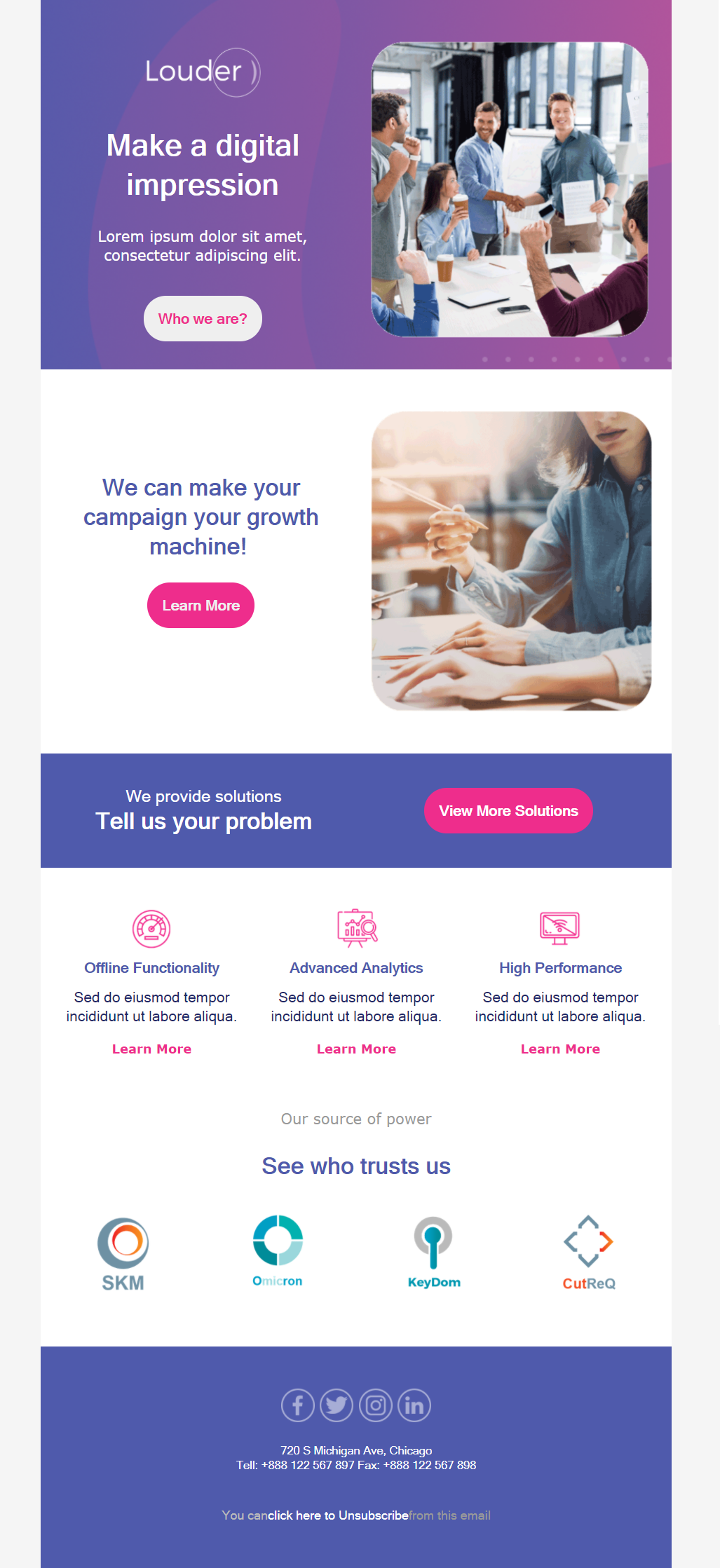
Every company needs a cool email to introduce itself to new clients. And this is exactly what you can do with the above template. From the color scheme and CTAs to the company badges at the end, you have everything you need to create an eye-catching SaaS email campaign.
Design tip: Use the layout to add all the necessary information your customers want to see. Don’t forget to insert high-quality images (or unique stock photos) to make your messages more appealing and relatable. Since it’s important to get off on the right foot, including badges from companies who already partner with your brand serves as a token of trust.
Why you need it: This template has everything you need to introduce your company and actively demonstrate that you are a credible business.
Upcoming Feature Newsletter Template

Got new features or an exciting update in the works? Then let your subscribers know with the above email newsletter template. You can create a teaser message to excite them and have them counting days.
Design tip: This is a simple template you can customize at the flick of a switch. Throw in some amazing visuals, add compelling email copy, and make your CTA stand out using bright colors. Also, use different email fonts to prioritize information.
Why you need it: A short and versatile template that you can use for numerous occasions. If you want to intrigue the audience further, the timer at the top is the perfect tool to let the countdown begin.
Feature Announcement Email Template

If you need something more austere, you can always grab the above template and customize it with Moosend’s drag-and-drop builder. The color scheme is ideal for an older audience that prefers more traditional elements.
Design tip: You can make small and big changes to the layout based on what you want to promote. Adding some graphic design elements will also work in your favor but don’t overdo it. On occasions like this one, all you need is to put the feature announcement front and center. And pair it with a clean-cut layout.
Why you need it: The single visual placed prominently at the center in this template lets you draw attention to your copy and call-to-action.
Abstract Newsletter Example
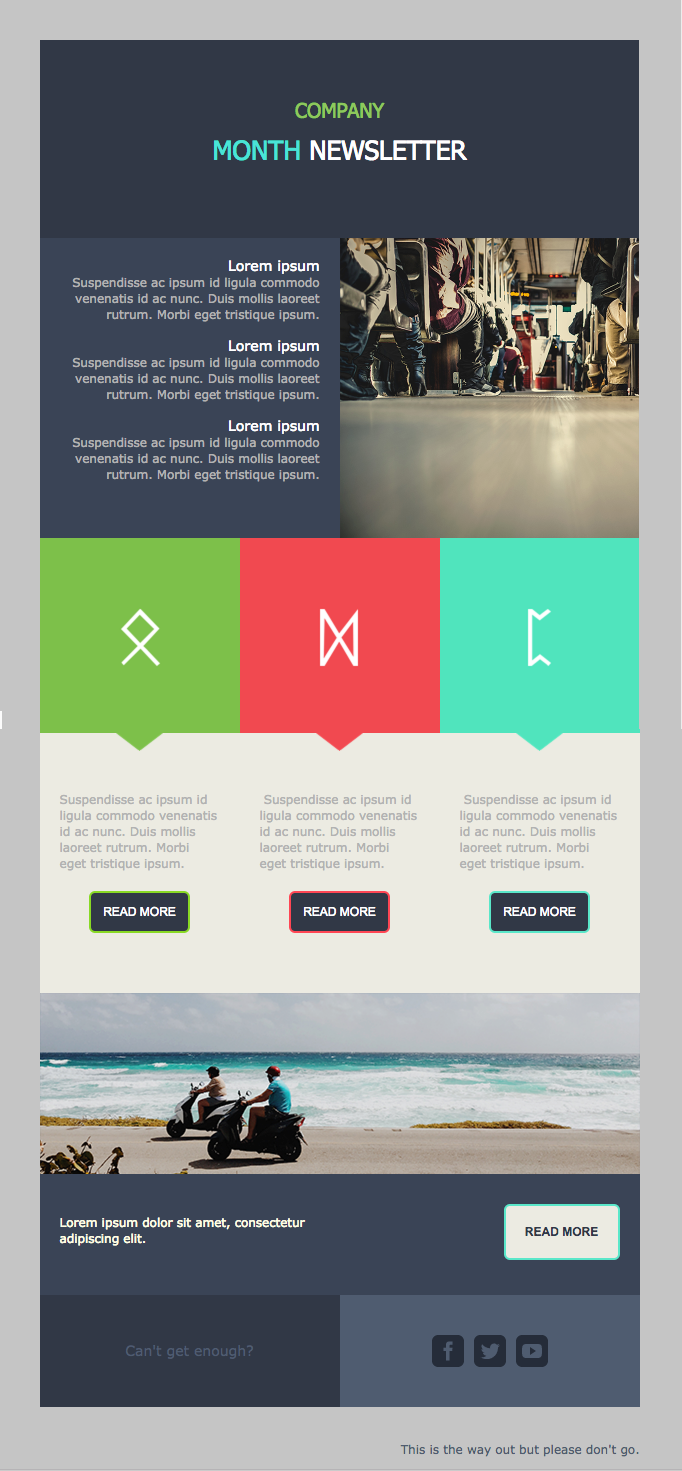
If you want something professional yet less traditional, the above template is what you need. The use of colored blocks adds a modern vibe to the entire template, making it ideal for younger audiences. You can use this example to share updates and lead your audience to dedicated landing pages.
Design tip: Keep the colored blocks if it fits your objective. You can add images, too, to make this newsletter even more stunning. Also, try to keep your copy short to avoid tiring your recipients.
Why you need it: The use of color in CTAs and visuals is a nice touch to create a memorable email campaign.
Lights-Out Company Newsletter

Are you a fan of colors but want something less vibrant? Well, let me introduce you to the lights-out template. You can select and customize it for different goals, ranging from sharing updates to showcasing new features.
Design tip: Consider playing around with different color combinations if it fits your overall branding. Using darker versions of your brand colors will also be interesting for your audience.
Why you need it: This properly structured design is great for informing your audience without frustrating them.
Website Launch Newsletter Template

A website launch or relaunch is a big deal for a business. The above example is what you need to present your new website design in a beautiful and informative way.
Design tip: The layout of this newsletter template is perfect for showing your subscribers what’s new. You might use it to showcase top features and direct readers to latest or best posts. Complement the copy with beautiful images to excite them and insert relevant CTAs to increase engagement. For the same reason, don’t forget to add icons so they can follow you on important social media channels.
Why you need it: While this template focuses on a website launch, you can easily customize it to fit other purposes such as a new feature release or any critical announcement.
Heart of Glass Promotional Campaign Design
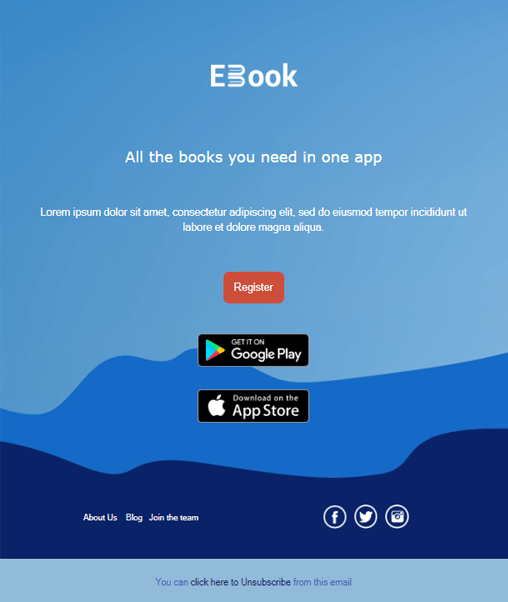
The Heart of Glass template favors a straightforward layout to help you create focused messages. You can use this design if you want to lead your subscribers to a single action.
Design tips: Take advantage of the blue color scheme to amplify your CTA buttons. Also, don’t forget that brighter font colors work better on darker backgrounds. Using simple and concise language will help to keep the focus on the unique action you need subscribers to take.
Why you need it: This template keeps things beautiful and straightforward, giving your CTAs the attention they deserve.
New Service Promotion Template
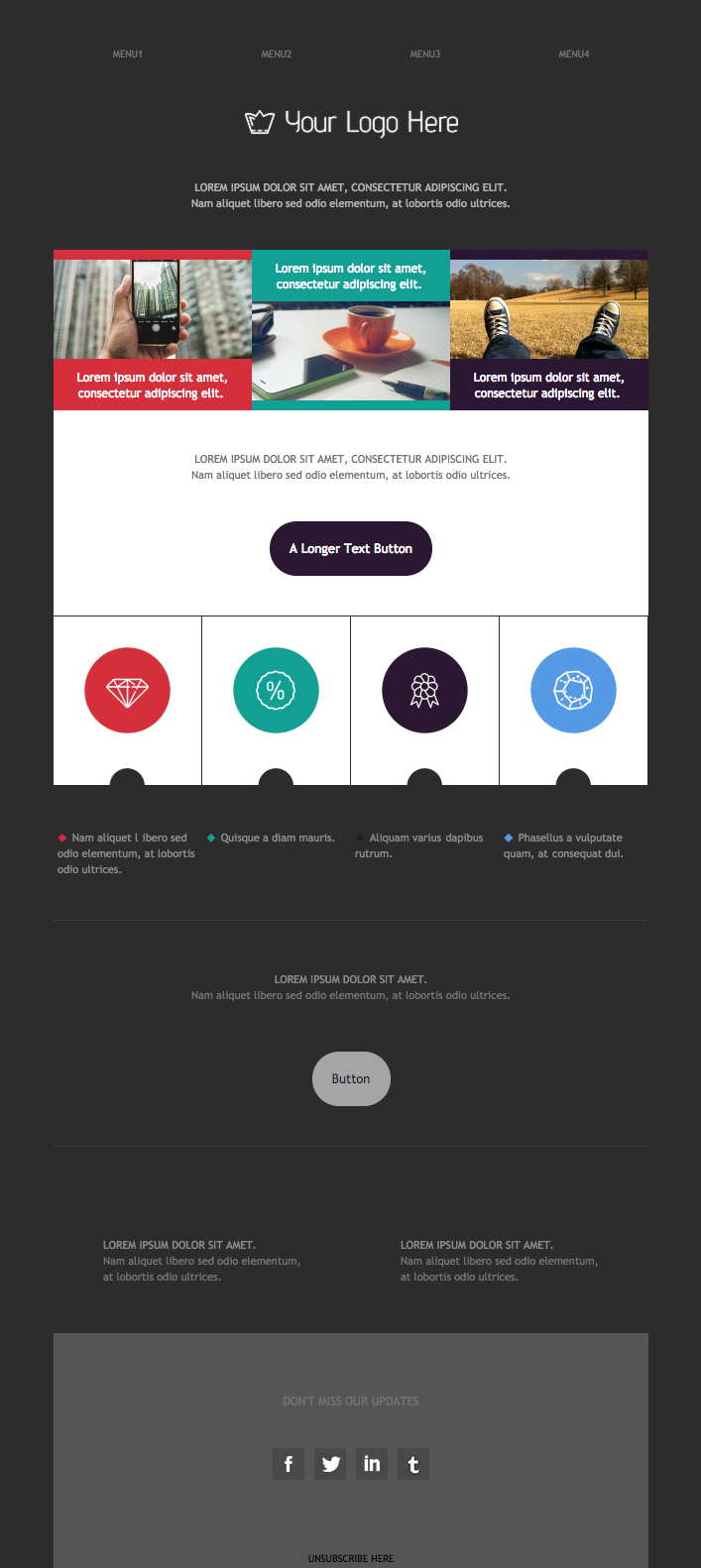
The above design will allow you to promote your new service or features in a jiffy. Structure-wise, the template sports a simple layout with enough white space and clear sections to make your message easy to read.
Design tip: Try not to clutter your campaign with too much copy and visuals. You’ll want to use only the necessary elements to give your audience exactly what they need to know about your new service, feature, etc.
Why you need it: You can customize this template as much as you like by dragging and dropping elements like images, videos, timers, or social media buttons from the “Items” tab in the editor.
New Feature/Product Promo Email Template

Now, this template has a simple design logic to give your audience all the information they need the minute they open your campaign. You can add your email copy at the top to instantly get your message across while the CTA is perfect for getting subscribers to take immediate action.
Design tip: Use your brand colors so your contacts immediately recognize your emails. And don’t forget to enrich the design with some high-quality graphic design elements to grab their attention. If you want to promote a new feature, a good idea is to include a demo video to show users how to start working with it.
Why you need it: This template works well if you want to put new features or products at the center of your campaign.
Mobile Application Launch Email Newsletter

A new product launch is a big deal for any business, allowing you to reach a large part of your audience. To make it memorable, you can use our dedicated mobile app launch template to inform your audience while creating a lasting impression.
Design tips: If you like the complementary color scheme, you can easily adapt it to your brand for a seamless and consistent result. Remember to include your new app features in a structured way to inform your audience and achieve mobile app growth.
Why you need it: Using complementary colors, a logical hierarch, and prominent CTAs is a great way to power up your app launch campaign.
Mobile App Promo Newsletter Template
This simple mobile app newsletter will help you create an effective promotional campaign for your email subscribers. The design is simpler compared to the previous template, investing in white space. Nevertheless, what it loses in fanciness, it earns in sophisticated look.
Design tip: The spacing in this template will let you make your mobile app features pop. Also, you might want to use bright colors in your CTAs so they contrast with the background to increase clicks.
Why you need it: The header and the above-the-fold CTA are ideal to engage recipients immediately and power up your click-throughs.
Mobile App Features Template Example

If you are a fan of dark themes with a splash of color, you can choose this template to give your audience a unique presentation of your new mobile app features.
Design tip: Use bright fonts to increase the readability of your copy. Also, vibrant colors and images are a great way to catch the reader’s eye and break up blocks of text.
Why you need it: The layout and color scheme helps brands promote their app in a memorable way.
Ring of Fire Mobile Newsletter Design

Last but not least, we got the Ring of Fire mobile newsletter template. The design is a mix and match of blue and white, giving you the impression that you’re browsing a webpage.
Design tip: This template is built with simplicity in mind to help you present your new features. You could incorporate high-quality images of your app and other graphic design elements to give your audience enough reasons to download it.
Why you need it: Ring of Fire is an impressive template that combines a clean layout, graphic elements, and strategic CTAs to boost conversions.
4. Seasonal Email Newsletter Templates
While holidays and special occasions are a busy time for most people, they’re also an amazing opportunity for engagement. For email marketers, targeting audiences with relevant seasonal campaigns serves various objectives, from building brand awareness to driving sales.
Below, you’ll find a fine selection of Christmas, Valentine’s Day, Halloween, and Black Friday templates to power up your holiday email marketing. And let’s not forget about summer and spring, so we got them covered, too.
Promotional Christmas Card Newsletter Template

Our first Christmas email template will remind your subscribers of a digital Christmas card. Since the design is pretty minimalist, you can use it as a blueprint to create unique campaigns for your Christmas email marketing strategy. The single and prominently placed CTA is also great to drive conversions.
Design tips: Use your brand colors so your Christmas campaigns represent your identity and give your audience a consistent experience. To take it one step further, upload a cheerful Xmas image and give your audience a holiday offer or discount to incentivize them to act. When it comes to visuals, you can leverage Moosend’s Image Picker to draw images and GIFs from Facebook, Unsplash, or GIPHY.
Why you need it: This Christmas newsletter template gives room to unleash your creativity, adding and customizing components to your branding and goal. Everything’s possible!
Christmas Gifts Newsletter Example

Are you looking for a minimalist layout with less flair and more elegance? The above Christmas email template is exactly what you need to keep things simple yet classy. It offers you the opportunity to display great Christmas gifts, share holiday preparation tips, or announce limited-time sales.
Design tip: You may benefit from the template’s white space and structured layout to make key messages stand out. Do you have a compelling holiday discount coming up? Then, consider introducing it on the top of the email so it’s the first element that catches attention. You could steal the idea from this template and create a custom image highlighting the discount.
Why you need it: Such a clear and straightforward template offers you a range of opportunities to engage your audience. To make them relevant to your audience’s needs and likes, Moosend’s personalization tools will turn the process into a child’s game.
Christmas Sales Promotion Design Example
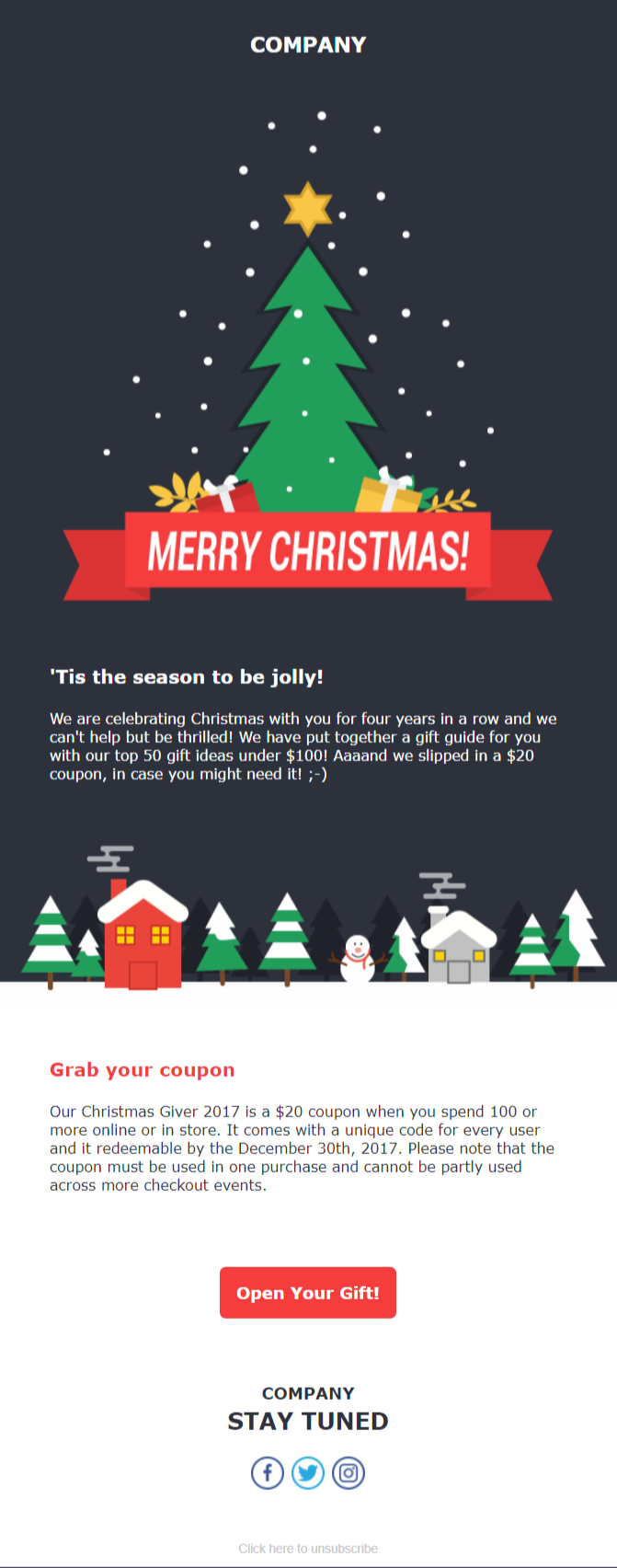
Another beautiful Christmas email newsletter example to excite your customers during the holiday season. This design has a few more visuals to promote the holiday spirit and let you wow your subscribers with a jingle-all-the-way email campaign.
Design tip: Again, you can insert beautiful, holiday-themed images to create an impressive Christmas email. Using the above CTA color is also perfect since red is associated with Xmas. What’s more, you can use a countdown timer to add urgency to your message in case of time-sensitive offers.
Why you need it: This template will give you an eye-catching Christmas campaign to target your audience. Also, you can easily customize it and use it as a New Year campaign. You could even use it for post-holiday email marketing, for example if you want to extend your sales period.
New Year Cheer Email Design Example

Not every holiday email has to be about sales and promotions. Sometimes, a thoughtful holiday campaign that just says “thank you” is an excellent method to put a smile on your recipient’s face and stay top of mind. And what better occasion to do this than New Year’s?
Design tip: Here’s where you can get creative, as long as you keep your message clear and concise. What you want is to thank recipients and make them feel appreciated. It could be through a festive image, short and full of gratitude copy, or perhaps an exclusive discount as a reward. No need for cluttered layouts and fancy graphics here. Just an on-brand, jolly campaign with the right elements to satisfy your audience.
Why you need it: You can use this campaign to thank your customers for their year-round support. Another idea is to share a round-up of your accomplishments or remind recipients of what they achieved using your products or services.
Valentine’s Daydreaming Email Template
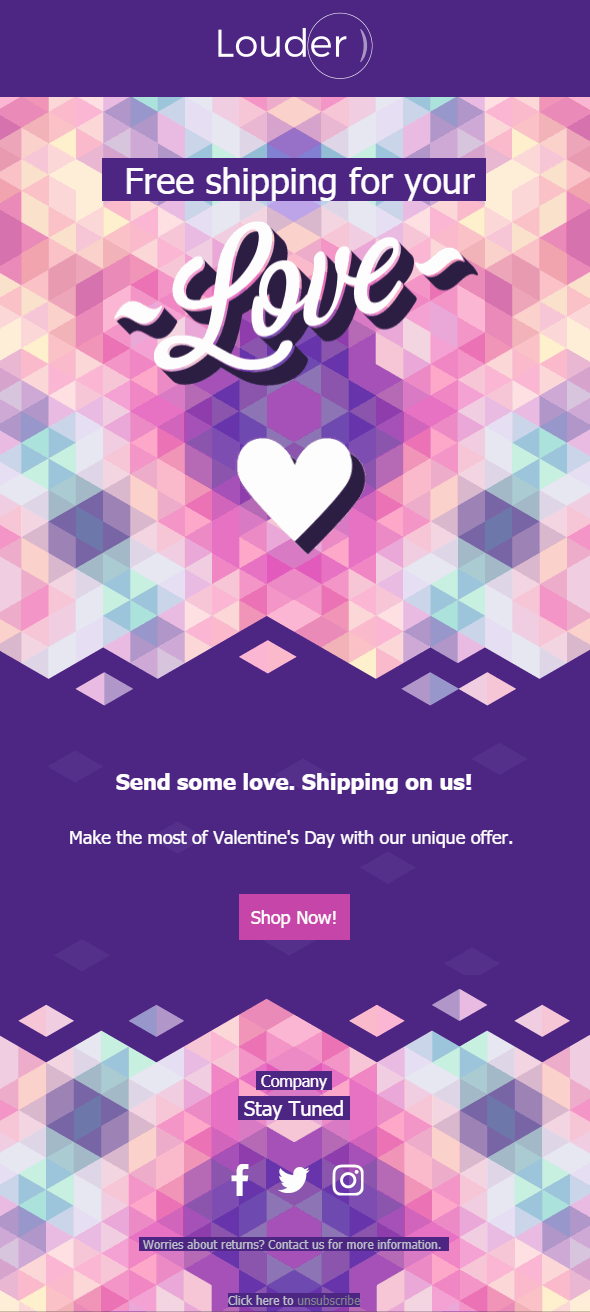
Of course, you shouldn’t forget about Valentine’s Day. The above template will be a beautiful addition to your seasonal email marketing campaigns. From the vivid color palette to the animated elements, you can use the above template to entice your target audience and boost sales.
Design tips: This email newsletter template has everything you need to charm your little lovebirds. I recommend keeping the animated heart to make your campaign more lively and holiday-related. Apart from that, don’t hesitate to insert a good old countdown timer to express urgency. Also, a heart emoji in the email subject line is a nice touch to get more opens.
Why you need it: The Daydreaming template is equally stylish and unique to help you bewitch your readers with your offers.
Eternal Flame Email Newsletter Design Example

If you want something more traditional and Valentine-y, Eternal Flame is just what you need. This example is both elegant and effective, giving you the chance to create an eye-pleasing V-day email campaign without spending too much time on it.
Design tip: Add your brand logo to the header and choose a heart or any other Valentine-specific visual element to get your subscriber in the mood for love the moment they open your email. Don’t forget to create attractive and bold CTAs to match your visuals. Red should be high on your list since it’s both vibrant and represents action.
Why you need it: The existing white space is perfect for making your brightly colored CTAs pop out. Plus, it gives you enough room to improvise and highlight your core message.
Be My Valentine Newsletter Template
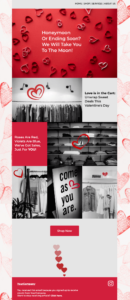
Entering the “love is all around” template world, this occasion allows you to get a bit more extravagant. You can make it all about love, hearts, and roses and create a spot-on Valentine’s Day email design to offer suggestions for your audience, such as what gifts to make or where to go.
Design tip: While this is a heart-packed design, you don’t have to promote anything Valentine-specific to use it. Remove or tweak any elements that don’t fit your branding or goal. However, we strongly suggest you keep the red color scheme, and perhaps use a romantic font to match the occasion.
Why you need it: Taking the romantic road usually works on Valentine’s Day, even if your products aren’t relevant to the holiday. Excite your users with this heart-warming layout, and why not add a few creative poems to make them go “awww”.
Halloween Jack-O-Lantern HTML Email Template

Trick or Treat? Halloween is the best time to give your audience a spooky experience and promote your seasonal products. Or leverage the holiday spirit while staying on brand. The above template is perfect for giving readers a holiday discount or a coupon to celebrate.
Design tip: This design relies heavily on the pumpkin image, sporting a single CTA button right in the middle. Also, it uses black and orange, a color combination that is popular in Halloween email marketing. So, you can keep the layout as it is and use your copy to intrigue your audience.
Why you need it: Using the Jack-o-Lantern template allows you to minimize distractions and lead your audience directly to your call-to-action button.
Ghost Themed Email Newsletter Template
Another way to charm your audience is with this spooktacular newsletter template. While simple, you can add any element you like to fit your branding and target your audience better.
Design tips: Add boo-tiful images to share the Halloween spirit with your recipients. Think of ghosts, pumpkins, spiders, and so on. Also, since the template is mainly black, use brightly-colored CTAs to drive more conversions.
Why you need it: Easy-to-customize and straightforward, this template is ideal for every Halloween campaign across industries. Also, don’t forget to come up with a scary subject line to increase your open rate and get readers into the spirit right away.
Wicked Witch Themed Template Example

Of course, we couldn’t forget about witches. If you want to provide your audience with extra info, you can pick and customize the above newsletter template for better engagement.
Design tip: Since Halloween is associated with orange, yellow, and black hues, you can keep the color scheme and insert your own wicked visuals and inspiring copy. Again, the template gives you space to add extra elements like GIFs, countdown timers, or product blocks. Also, make sure to link back to your social media profiles to cross-promote between channels.
Why you need it: You can use this template to create a beautiful campaign to stun your audience, from promotions and special offers to Halloween makeup tutorials. No matter the goal, the center-aligned CTA that contrasts with the background prompts users to take action.
Haunted Mansion Newsletter Example

Do you wish to take this all the way? Then, don’t limit yourself to black and orange color schemes and images of Jack-O-Lantern. This template is ideal to give readers a nice scare, from top to bottom.
Design tip: With this unique design, it’s almost certain that recipients will stop and wonder what this is about. Now that you have their attention, all that’s left is to add high-quality product images and prominent CTAs with action-oriented copy to prompt action. Fonts could work as a scary-good tool, too, matching the look and feel while keeping the focus on certain sections in the email.
Why you need it: This email exudes a haunting feeling, which makes it truly authentic. As a result, using this Halloween template as foundation will contribute to your brand staying top of mind even when your Halloween promotion is over.
Black Friday Email Newsletter Template
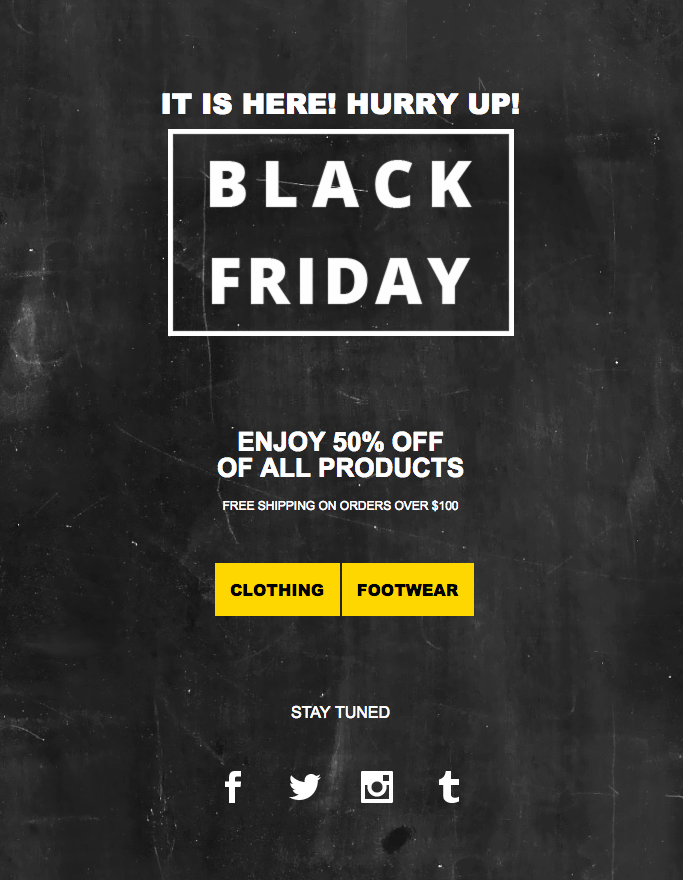
To benefit from customers’ tendency to shop more, you need a brilliant Black Friday email to show them your limited-time offers. With the above template, you can create a simple yet effective email campaign for your retail business or eCommerce store to amp those conversions like a pro.
Design tips: Take advantage of the color scheme to power up the visibility of your CTAs. Black Friday deals are time-sensitive by definition. So, this is the perfect time of the year to instill urgency through countdown timers and actionable copy.
Why you need it: A simple design you can instantly customize to suit your needs. With the perfect Black Friday subject line and the right urgency elements, you’ll increase critical email marketing metrics like opens and clicks.
Black Friday Sale Design Example

You’ll see most Black Friday campaigns using dark colors, particularly black or purple. But there’s always room for a brighter approach, like in this Black Friday email newsletter template. It’s colorful and fun yet simple and professional.
Design tip: With this powerful design, you can draw attention to your holiday promotion just by incorporating compelling product images. Make sure to include the initial and discounted price. Another thing to keep is having a main CTA above the fold and secondary ones under each product or product category.
Why you need it: A clean and straightforward layout is perfect for mobile-users. Or practically any user that scrolls through. And that’s rather common during promotion-saturated periods like Black Friday. In addition to that, the colorful blocks help you separate important sections and elements like your CTAs.
Spring Sales Newsletter Example
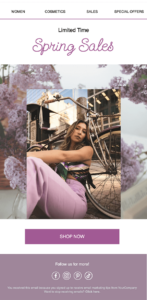
Spring is associated with fresh starts and joy. As people get inspired by the blossoming nature, it’s time for brands to bring these characteristics into their spring emails. This colorful email template screams spring, using pastel colors and flower decorations.
Design tip: This template is as fresh as it gets. Still, it remains clean-cut and beautiful. If it matches your brand tone and the occasion, write light-hearted copy to complement the high-quality product images. And since spring sales don’t last forever, consider incorporating a countdown timer at the top to create a sense of urgency. To that end, use phrases like “Time is running out” or “Hurry up”.
Why you need it: With this warm spring newsletter template, you can create an effective email, whether it’s to promote new arrivals or destock inventory using time-sensitive discounts.
Let The Sunshine In Summer Template

We could never leave out summer. No better way to increase seasonal sales during this time of the year than an impressive campaign like the above summer email. With its retro and relaxed feeling, it fits perfectly to the careless spirit of the season.
Design tip: By using summer-themed visuals, you set a perfect summer tone. Make sure to create equally powerful copy and CTAs to convince readers. The sales banner is an excellent way to draw attention to a limited-time discount or any other piece of content that represents your campaign goal.
Why you need it: Its visually engaging and clear design helps marketers display summer deals or even promote post-summer sales. However, you can always use it to direct readers to relevant posts and other resources at your disposal.
5. Publisher Email Newsletters
Are you a blogger or publisher who wants to deliver your content to your readers’ inbox the moment you hit the publish button? Our email service has got you covered with ready-made email newsletter templates for several objectives.
Below, you’ll find some eye-catching blog, eBook release, and RSS templates to enhance your content marketing strategy.
Typical Blog Newsletter Template

As the name suggests, this is your typical newsletter template for promoting your personal or company blog. You can easily add your own content, pick your favorite colors, and optimize the CTAs to improve your click-through rate.
Design tip: Take advantage of white space to make each section stand out. Also, since white is pretty dominant here, don’t hesitate to add bright colored calls-to-action to make them pop. You can leverage every email section, especially the header, to showcase your best blog content.
Why you need it: A beautiful template to increase engagement through your blogger email marketing and cross-promote between channels using social media icons.
Food Blog Newsletter Template

The above email newsletter template is great for food bloggers who want to give their audience a memorable experience. The color scheme and background remind recipients of a tablecloth, which could help to make their appetite grow.
Design tip: You can make this template more awesome by adding some high-quality and mouthwatering pictures from your blog post. Also, play around with various elements and add new content blocks to offer food lovers the best cooking tips or promote helpful gadgets.
Why you need it: While this template is made with food blogging in mind, you can customize it as you like to suit your niche.
Personal Blog Newsletter Template Example

If you have a personal blog, then I’d recommend using a more friendly design that reflects the tone of your site. To do that, you can use the Personal Blog template to create a stunning and scannable email for your readers.
Design tip: To match your style, use the drag-n-drop editor to change the color scheme. Moreover, you could upload images from your Drive or social media to show recipients what’s new. The “Stay in touch” section at the footer pointing at the social media buttons is a clever addition to lead readers to other channels.
Why you need it: You can take advantage of the versatility of this template to mold it into whatever you want and promote different content categories in a straightforward way.
Blue Corporate Newsletter Template
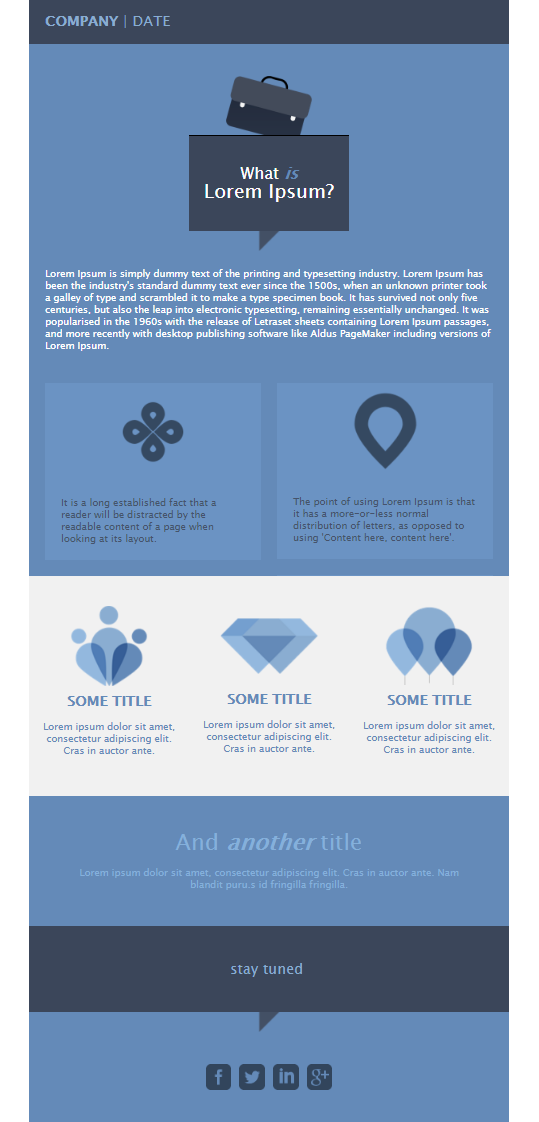
Keeping the more austere and traditional vibe, here’s another professionally-looking design you can use to target your audience. As you can see, this template also favors copy, using simple email design elements to stay elegant and informative.
Design tips: Not a fan of blue? You can change the color scheme to whatever you like. Using your brand palette is a great way to connect the email with your company and provide a consistent experience. Don’t forget to add your company logo at the header to achieve it.
Why you need it: Utilize this template to strike the right balance between copy, visual elements, and structure. Your subscribers will appreciate the beauty of simplicity in this effective email template.
Informational Email Newsletter Example
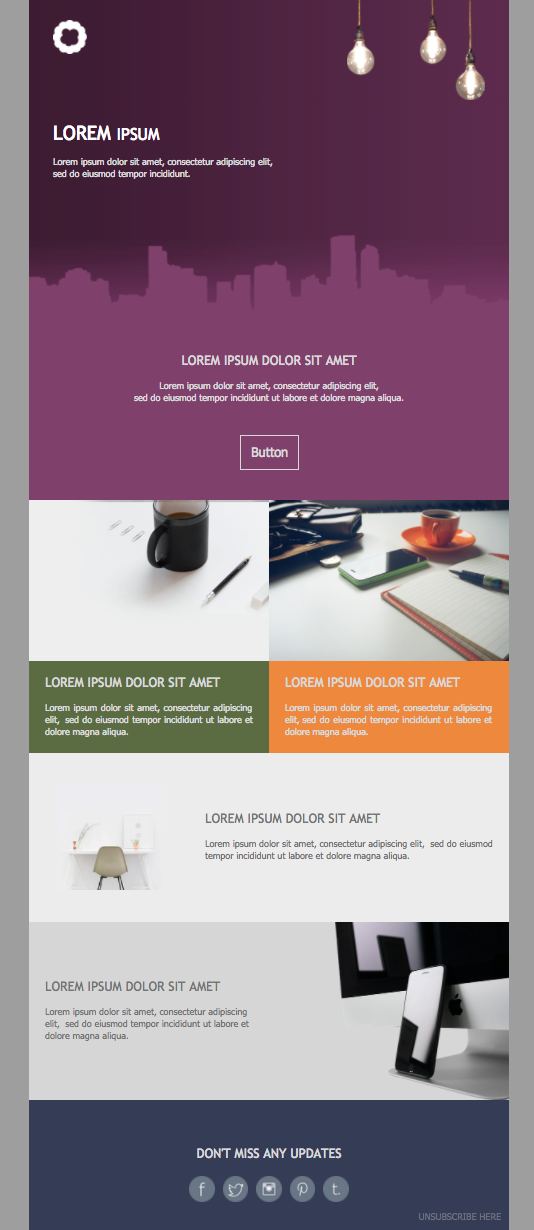
Keeping your audience educated is crucial to increasing engagement rates, building brand awareness, and fostering solid relationships. So, use the above newsletter template to share valuable details in a structured way.
Design tip: To complement your email copy, make sure to add some beautiful images, your company logo, and social media buttons. Also, use the header along with a strong CTA to display your core message.
Why you need it: This is an easy-to-customize template that allows you to place the most important information above the fold while sharing additional resources in the following content blocks.
RSS Blush Free Email Newsletter Template

RSS emails are an integral part of a successful blogger marketing strategy. By setting up RSS campaigns, you can connect your email marketing and content marketing efforts. To help you out, we have a straightforward and minimalist email template to make it possible.
Design tip: Since they draw content directly from your blog, RSS emails need to be simple and easy to read to fulfill their purpose. Avoid adding any distractions or too many resources and focus on your CTAs.
Why you need it: A simple yet aesthitically-pleasing template to set up your RSS campaign in a couple of minutes.
RSS Cotton Newsletter Design Template

If you aren’t a fan of the RSS Blush, you can use the RSS Cotton to create an equally attractive email. This newsletter template is great for email designers who use beautiful visuals in their content and want to excite their audiences by taking advantage of the “one picture is worth a thousand words” tactic.
Design tip: Make sure to add high-quality images so they stand out in this minimalist layout. Don’t forget to create action-oriented and prominent CTAs to promote your CTR.
Why you need it: This RSS template is simple and powerful, which makes it ideal to quickly inform your readers about new posts.
RSS Powder Newsletter Example
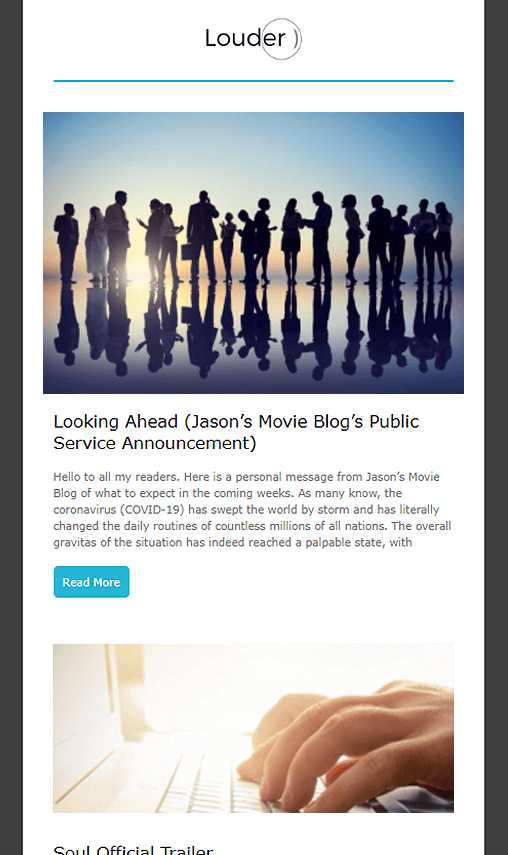
If your audience likes to see a lot of content on your newsletter, you can use RSS Powder to make it happen. Without overwhelming them, though, since this email design invests in a user-friendly structure.
Design tip: Again, add some visuals to enrich your newsletter design and pick the right colors to make it more pleasing to your audience’s eyes. Use high contrast between your CTAs and the email background to draw attention to them.
Why you need it: A great template to showcase your content and intrigue your readers to click on your CTAs for more.
RSS Navy Email Newsletter Template Example
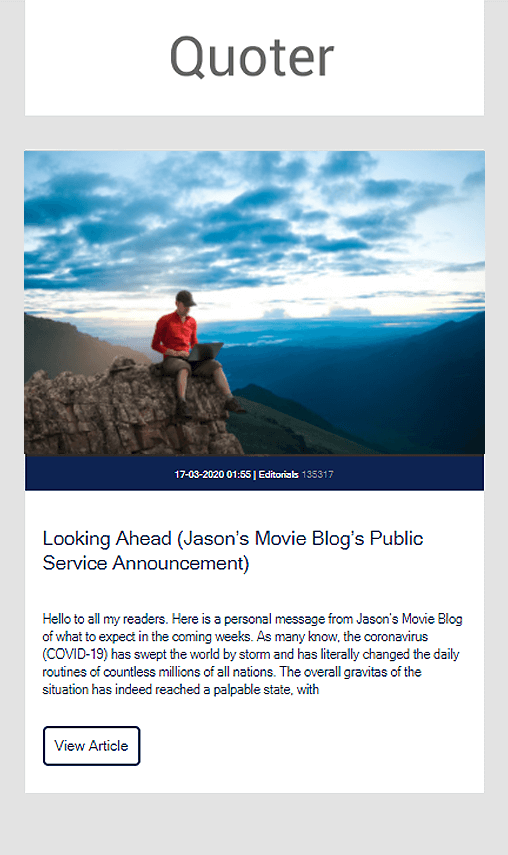
RSS Navy is great for single RSS updates. Like the previous designs, you can instantly pick it and customize it to provide your email subscribers with all the necessary information.
Design tip: Don’t forget to add your company logo and an eye-catching image to capture the reader’s attention.
Why you need it: While similar to the rest, you can keep RSS Navy in your quiver for important updates and announcements due to its focused layout.
RSS Essential Newsletter Email Template
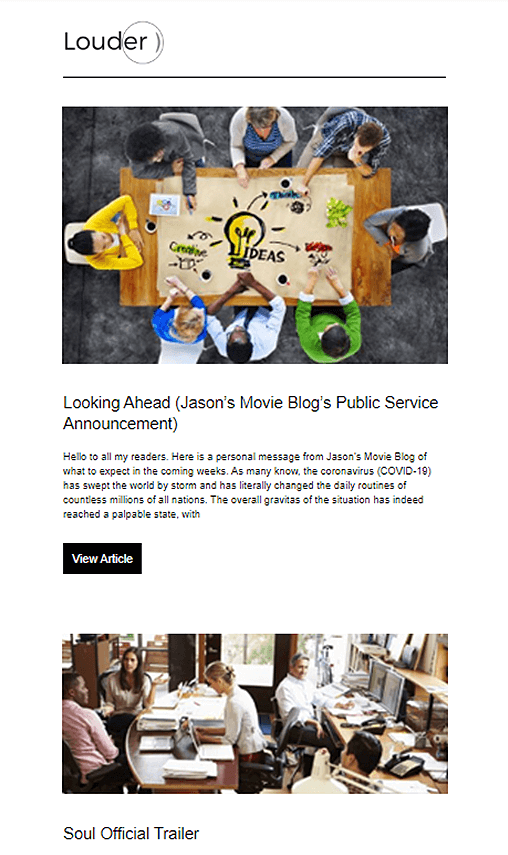
If you are more of a traditional type, this simple, black-and-white RSS Essential newsletter design is the ideal choice to deliver multiple updates at once.
Design tip: This example works great if you want to combine images with brightly colored CTAs. Due to spacing, your visuals won’t clash with your color scheme and will give you a balanced result.
Why you need it: The Essential RSS template is your everyday hero, ready to use in a couple of minutes.
Billie Jean Ebook Promotion HTML Template
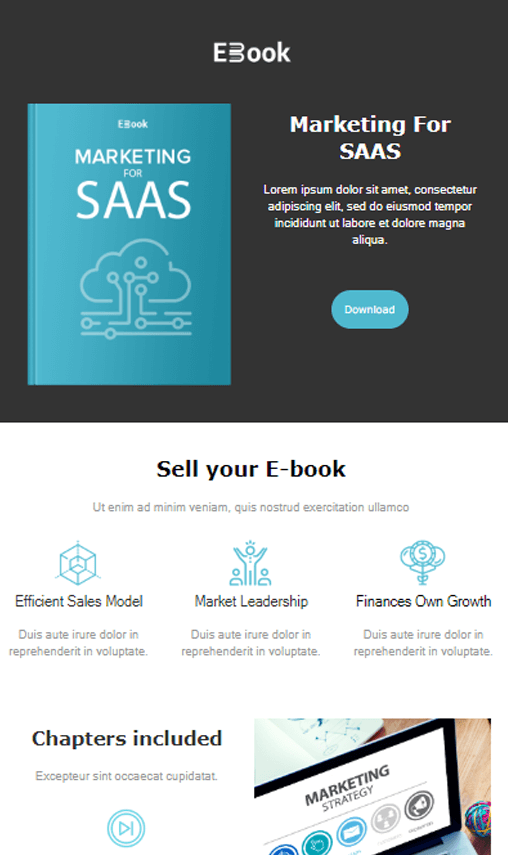
The Billie Jean template isn’t here to cause a scene (rest assured, MJ) but to help you promote your eBook. Ebooks are an important tool to nurture your leads and move them a step down your marketing funnel. The structure is great for guiding you through email creation to design a brilliant lead nurturing campaign.
Design tips: Take advantage of the defined sections to give your audience as much information as possible. Don’t hesitate to introduce yourself and share customer testimonials to increase your credibility.
Why you need it: This template is perfect for creating an eBook promo that will charm and persuade your subscribers.
Just Like Heaven eBook Newsletter Design

Versatility is key when it comes to picking a template. With the above design, you can either create an eBook campaign for your audience or even promote your online courses and tutorials to nurture them effectively.
Design tips: The template will allow you to add your email copy on the top. Take advantage of this opportunity to show readers why they need your resources and then offer a compelling CTA button to convert them.
Why you need it: The layout gives you the chance to promote additional resources/pages and even add any relevant information to show your expertise.
6. Transactional Email Templates
Transactional email campaigns serve as an important communication tool, delivering valuable and timely updates each time consumers take a specific action.
With these campaigns, you keep your audience informed and up to date, letting them know that everything worked out fine during their transaction. Which, in turn, is a key ingredient of customer trust and satisfaction.
Now let’s see how you can offer your audience a great experience through our selection of transactional email newsletter templates.
Colorful Account Creation Design Template
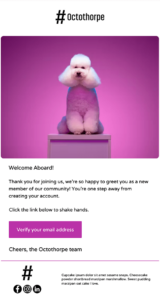
You might think that account doesn’t leave much room for creativity. But who is to say you can’t make the corresponding confirmation email more cheerful? Here’s where you can use this cute and colorful transactional email template to grab your new subscribers’ attention.
Design tip: In such an email, a clean and focused design is gold. So, keep things simple, leveraging white space and a bold-colored CTA to ask recipients to verify their email. Also, don’t forget to add your logo and an attention-grabbing visual that will stick with them.
Why you need it: Use this unique template to welcome new contacts and give them peace of mind.
Minimal Order Confirmation Newsletter Design

Again in this case, minimalism takes over. With this uncluttered and well-structured layout, you can confirm the subscriber’s order and provide all relevant details to keep them informed and engaged.
Design tip: Featuring compelling images of the items ordered is an excellent method to create that “oh-I-can’t-wait” feeling. Pair the images with the necessary and easy to understand information-let’s not forget that it’s the main objective of this email. Also, saying thank you in the copy adds a human touch that your subscribers will appreciate.
Why you need it: Subscribers expect order confirmation emails to rest assured. Use this easy on the eye template to give them all the info they need without tiring them.
7. Hospitality & Travel Newsletter Template Examples
Newsletters aren’t only effective for eCommerce, SaaS, and publishers but also for hotel owners, travel agencies, restaurants, and so on.
Below, we’ve picked some amazing hospitality and travel email newsletter templates to capture your guests’ and travelers’ attention. Let’s check them out.
Hotel/Resort Promotion Email Template
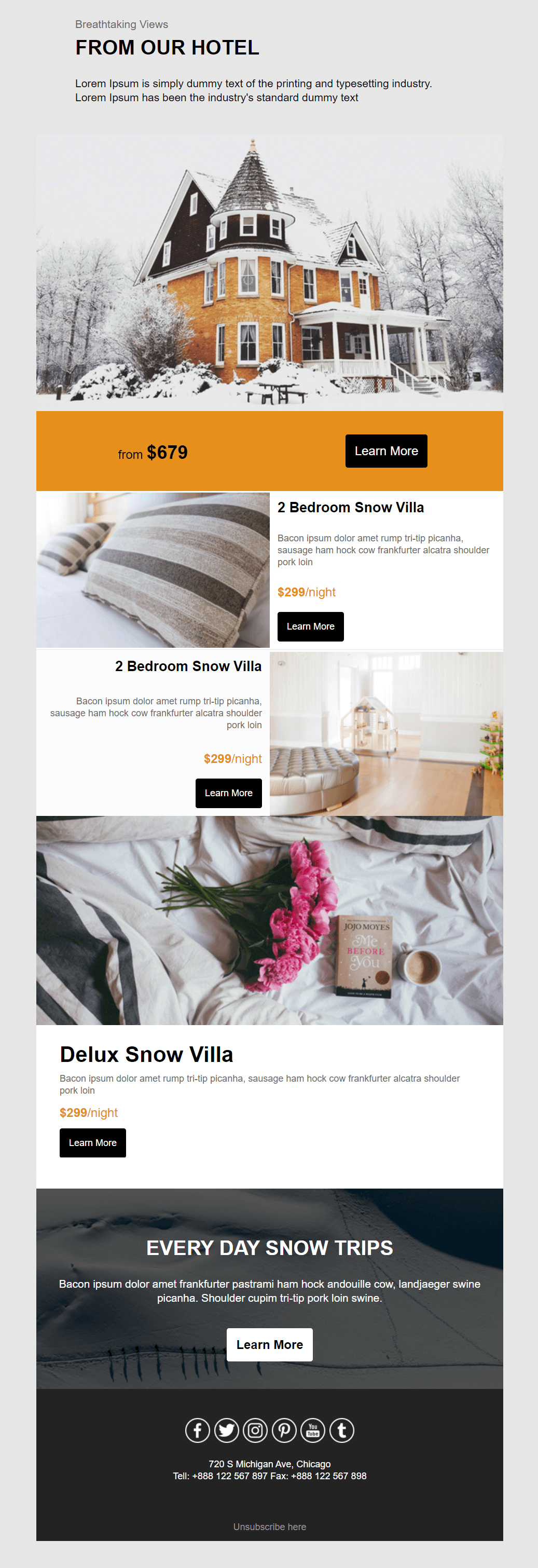
Hotel owners, this is your time to shine! Grab this template and use it to promote your hotel/resort with visuals and compelling copy.
Design tip: Add beautiful images of your business to intrigue potential guests and see your bookings rise. Also, you can customize the color scheme of this template to match the colors of your brand to create a familiar look and feel.
Why you need it: This template has been designed for hotel owners who want to kickstart their hotel email marketing efforts. With it, you get all the sections you need to promote your business, share special deals, and excite your guests.
Hotel Reservation Newsletter Design Example
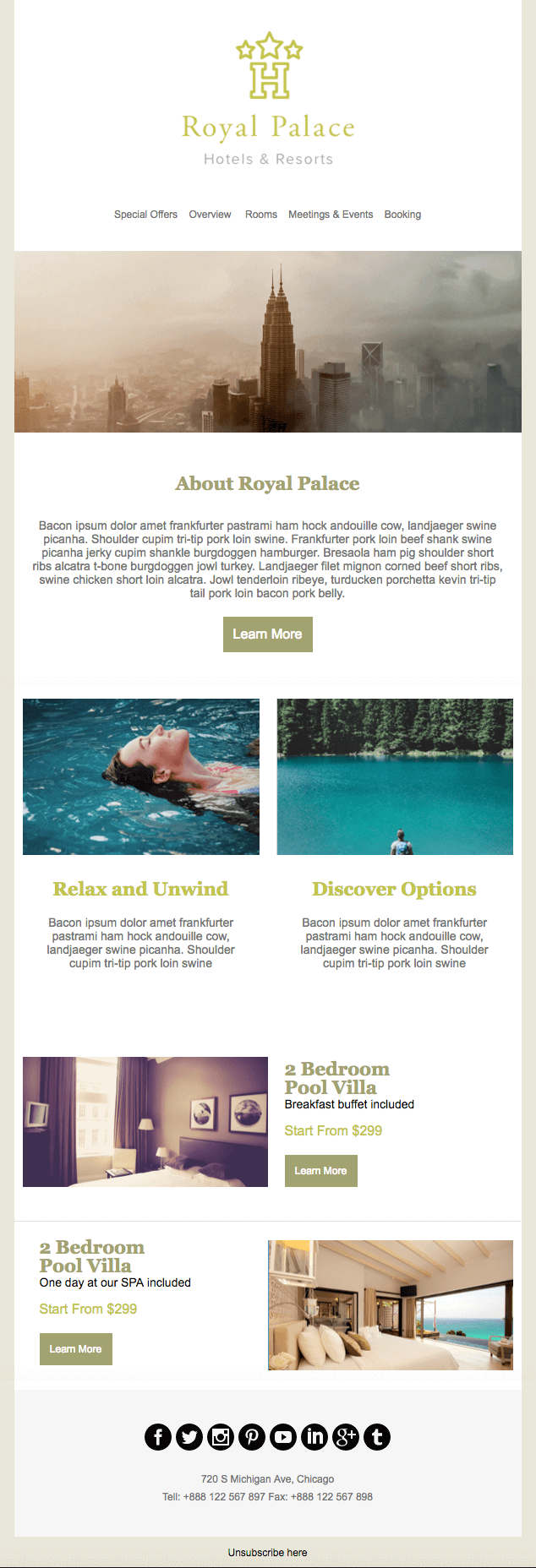
If your motto is “Elegance and Luxury,” you can instantly grab the above newsletter design. With this polished template, you start preparing visitors for a memorable service right from the email communication. And have them long for more.
Design tip: Leverage white space to make your copy more readable and your graphic design elements pop. Also, you can play around with colored fonts to give your email a sense of glamor.
Why you need it: A very chic template to engage potential guests and send them to your booking landing pages without much effort.
Travel Booking Newsletter Template Example
Give your audience more reasons to make a booking at your hotel with an eye-catching marketing campaign. Just pick the Travel Booking newsletter template, add the magic ingredients, and let your guests know you are open for business.
Design tip: Don’t forget to insert your brand colors and logo to create a familiar email for your audience. What’s more, make sure to include compelling CTAs in contrasting colors to increase your booking rate. Why not throw in star ratings next to each option, too? Word-of-mouth marketing never goes out of fashion, especially for service providers.
Why you need it: The Travel Booking template is easy to customize for any accommodation type to power up booking efforts.
Live Your Myth Email Template Example
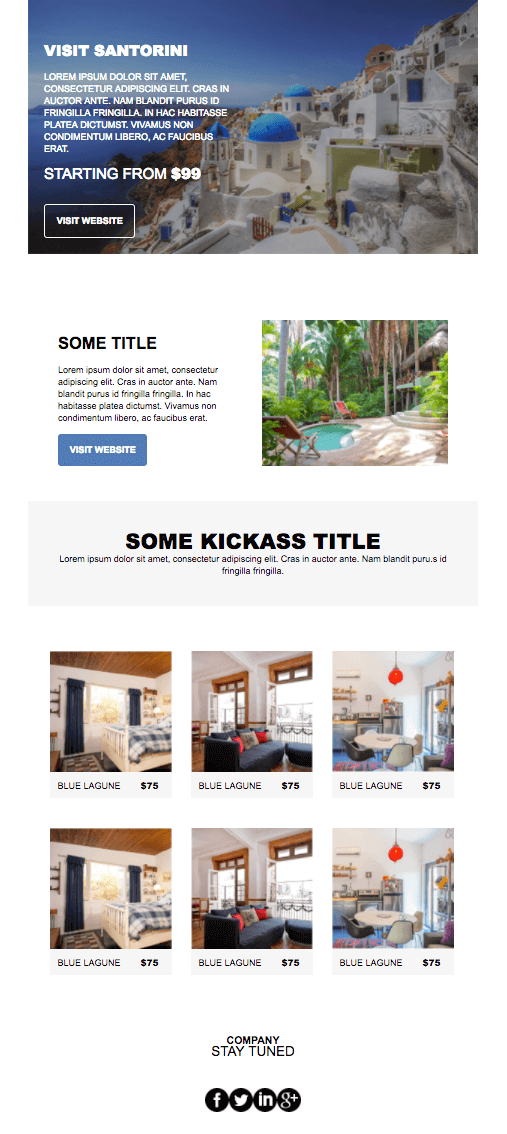
Let your audience live the myth of an exciting destination with the above template. Use this professional design to promote different accommodation options, inspire subscribers, and offer them amazing solutions to satisfy their wanderlust.
Design tip: Give your audience a sneak peek of what they’ll experience and don’t forget to insert additional product blocks to promote multiple rooms/services. Incorporating high-quality visuals of what you offer is also key to incentivize bookings.
Why you need it: Excite your indecisive travelers with this well-crafted layout featuring stunning visuals that will make their hearts flutter.
Food Delivery Newsletter Email Template

Attract your subscribers with an email newsletter that will build up their appetite. Give them amazing deals and even share posts from your blog to inspire their next order.
Design tip: Start with an image of your business or specialty to set the mood. Also, take advantage of the Z-pattern to easily guide your subscriber’s eye towards conversion.
Why you need it: Show your potential customers your special offers and new menu items to increase orders. Alternatively, share fresh posts with tips to help them become better home chefs.
Food Wars Newsletter Template
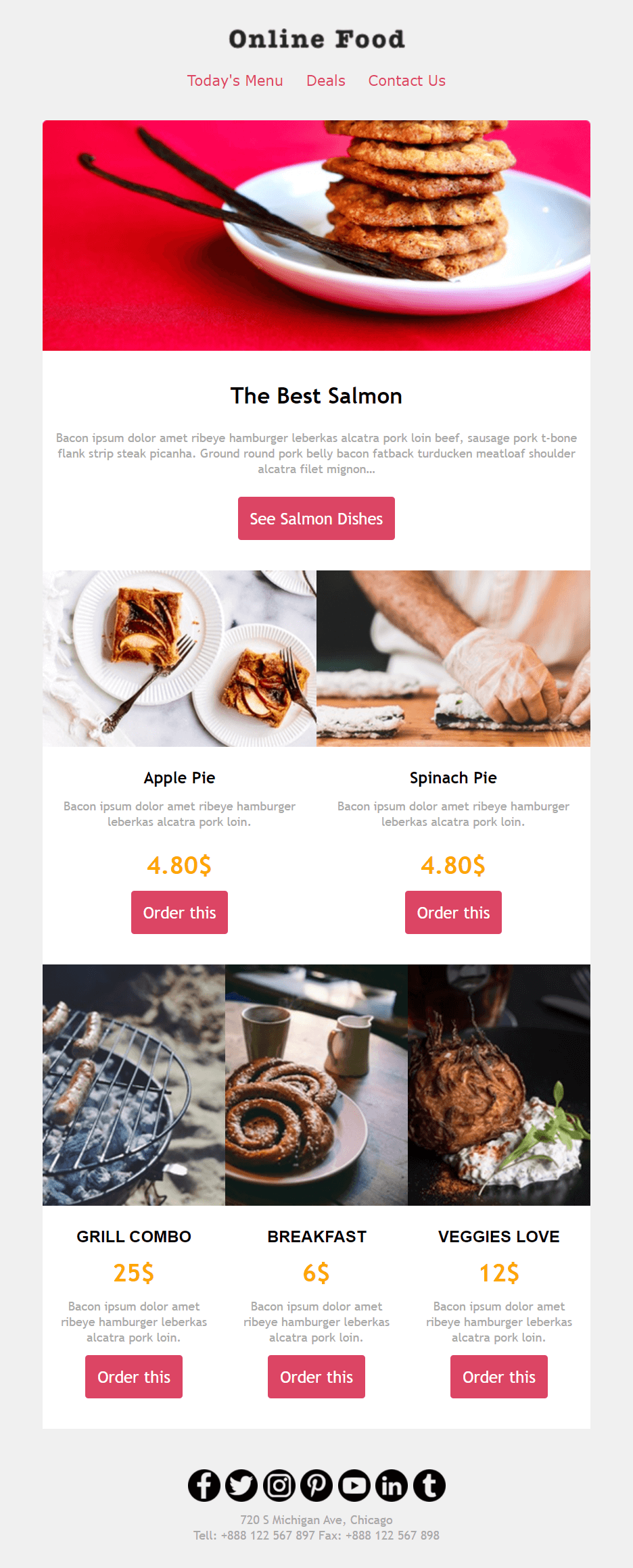
Need something classier? We got your back. Save and customize the above template to show the value of your food service and content like no other.
Design tip: The white space here is just “chef’s kiss!” Take advantage of the layout to present your products beautifully and craft brightly colored CTA buttons to convert your customers. And consider adding links to key web pages in the footer to drive more engagement.
Why you need it: Although this template is designed for restaurant email marketing, any hospitality business could use it for promotions and value-packed content.
New Year’s Treats Newsletter Example
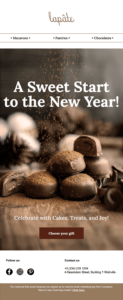
This New Year’s template examples leverages seasonality to create a timely and sweet promotion for pastry items. However, it might serve every business that wants to share timely offers, sell gift bundles, or display season-related products.
Design tip: Grab attention instantly with an irresistible hero image and a straightforward headline that reveals the email’s focus point. You can keep the warm color combination or tweak them to create an on-brand, bold newsletter.
Why you need it: Brands should benefit from this elegant design focusing on the products to urge recipients to make holiday purchases.
8. Event Newsletter Templates
Planning an exciting event? Tell your audience all about it with an eye-pleasing event newsletter. With the right email template, you can both boost registrations and excite your audience until the day comes.
In this section, we’ll see some webinar newsletter templates that every business needs to nurture and educate their customers. Also, we’ll take a look at some more personal templates for those precious moments in life.
Webinar Registration Email Newsletter Template
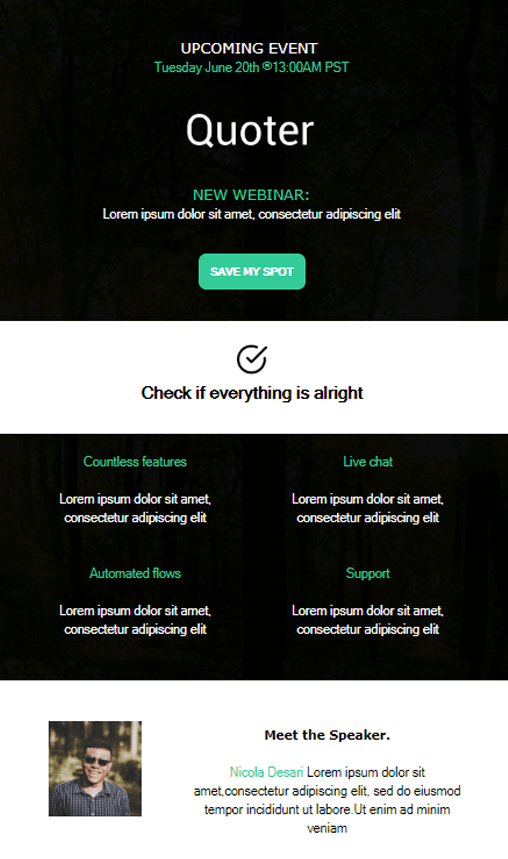
Kickstart your webinar marketing with the right newsletter template. The above design is great for informing your audience about your upcoming event and providing them with all the necessary attendance information.
Design tip: Add your event details at the top of the email to make sure that your subscribers won’t miss it. Right below, you can place a strong and action-driven CTA to convert them instantly. Take advantage of the bottom section to insert some information about the speakers and perhaps use another CTA to increase registrations.
Why you need it: Make sure that your subscribers are aware of your event and let them save a spot easily through your email campaign.
Online Training Design Example
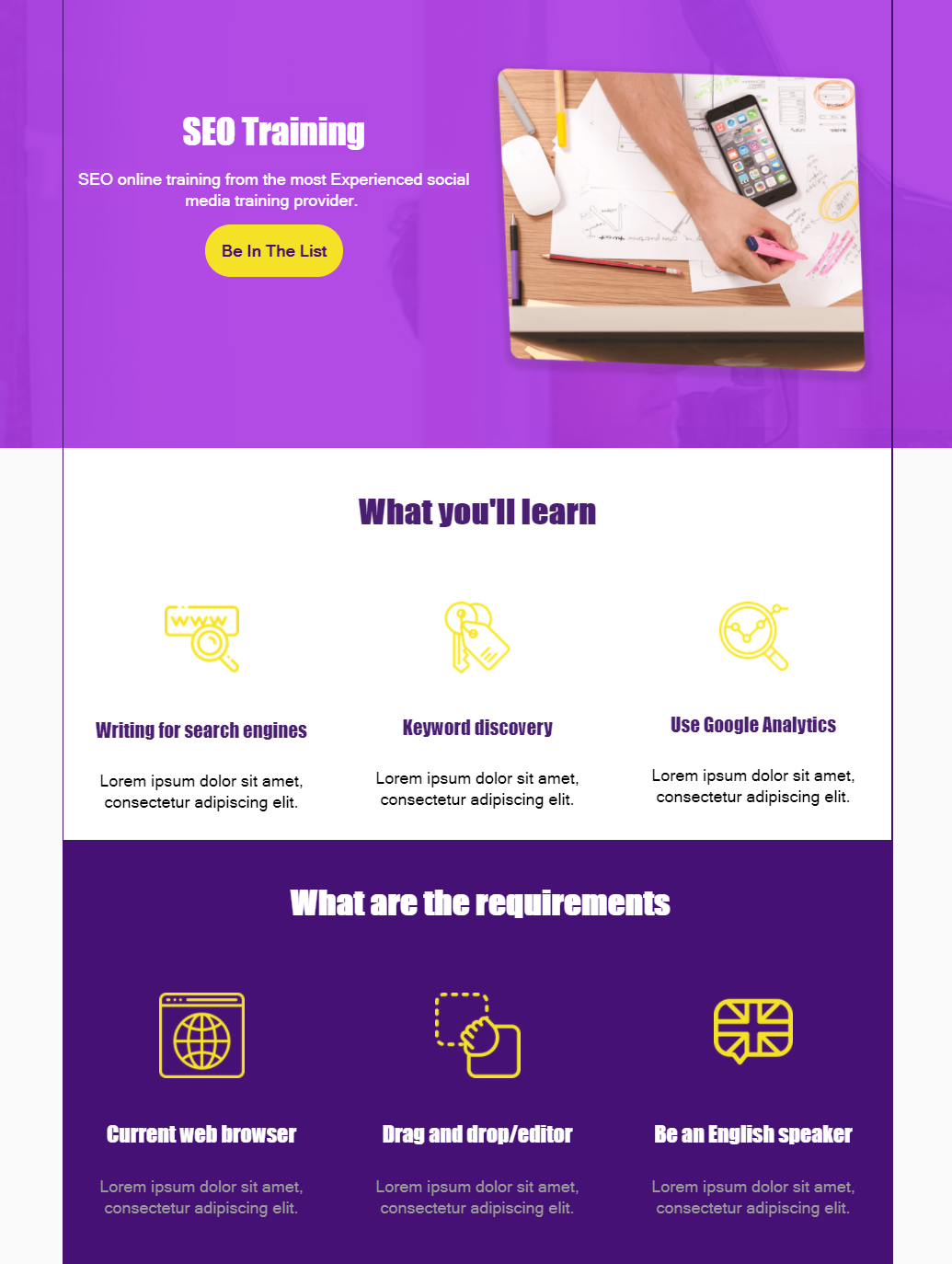
Get your participants interested in your online event with a short and to-the-point email campaign. Use the above template to provide them with event details and convert them with a unique CTA that’s above the fold.
Design tip: Event email marketing should be all about sharing informative and relevant content. Stress the benefits of attending your event with short and crisp copy. To go the extra mile, use the “Requirements” section to guide registrants through the attendance process.
Why you need it: With this event template, you can easily excite your audience with your color choices and show the value they’ll gain with persuasive language.
Event Invitation Newsletter Design Example
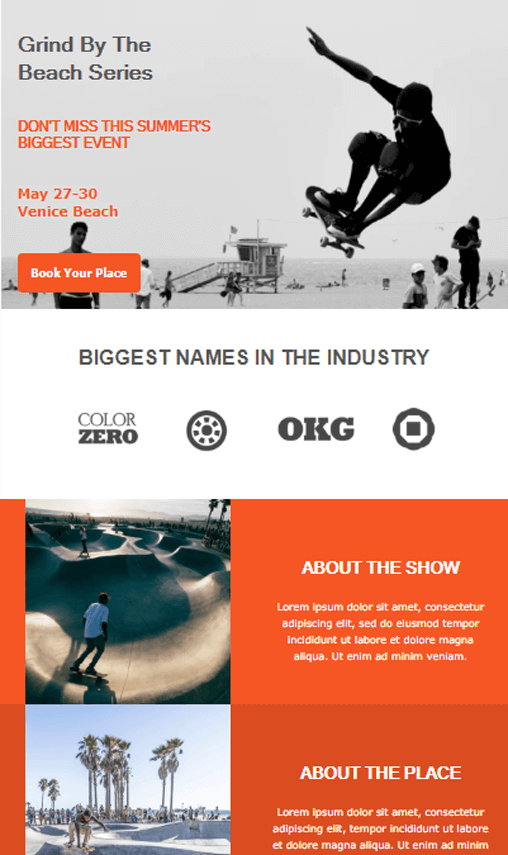
The above template allows you to promote your event (online or not) in a cool fashion. Take advantage of the layout to make your email invitation look like the real thing and power up your registrations.
Design tip: Customize your template using colors that represent your event and brand identity. Don’t forget to include all key details. Plus, a great idea is to insert extra blocks to inform your participants about the location, activities, and more.
Why you need it: To spread the word about your event with a cool and modern invitation, of course!
Wedding Invitation Newsletter Templates

Traditional wedding invitations are great, but what about “e-nvitations?” They are what you need to show your wedding guests your creativity and have them looking forward to it. So, grab this template and customize it to your liking.
Design tip: Wedding invitations can be elegant or extravagant. Add your personal touch, insert images of you and your significant other, or play around with original graphic elements.
Why you need it: No need to worry about mailing those invitations one by one. Also, turning your CTA into an RSVP will save you tons of time and facilitate arrangements.
Informative Wedding Newsletter Email Design

Here’s a more minimalist wedding invitation template to make sure your guests know about your special day. Responsive and customizable, use it to create a beautiful invitation that people will remember.
Design tip: The design looks like an actual invitation so you don’t lose the real-life effect. Make it more special by adding bright colors and, of course, add your RSVP to learn who will attend.
Why you need it: Again, saving time, money, and effort on mailing hundreds of invitations. No more waiting at the post office is a god-sent gift.
Boy Christening Email Newsletter Templates

Like with your wedding invitations, you can create stunning e-nvitations for your little bean’s christening.
Design tip: Keep them simple, play around with color, and don’t forget to add your child’s name. Or, if you want to get your guests wondering, make sure to highlight that they’ll learn all about it on the special day.
Why you need it: Organizing events, whether business or personal, involves a lot of hard work. So why not simplify the process to spend more time with your precious little one?
Girl Christening Newsletter Templates
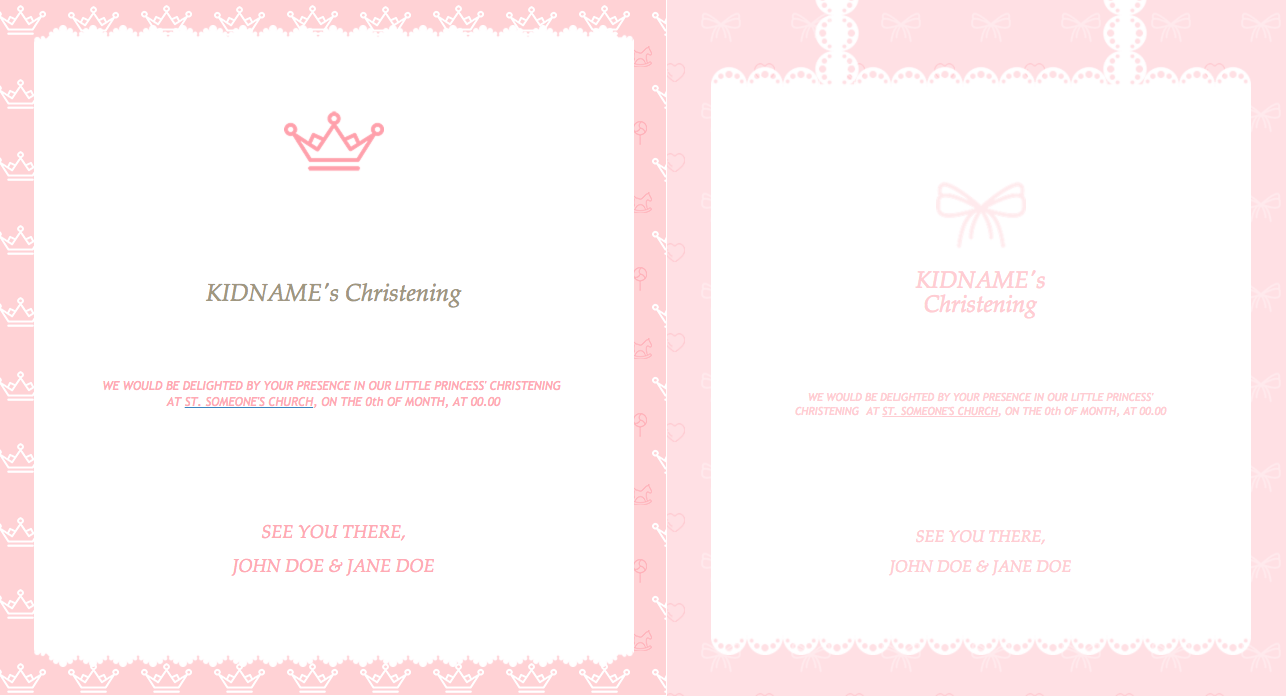
Last but not least, we also have these sweet christening email newsletter templates for girls to invite your loved ones to this unique celebration.
Design tip: Pink is always a great choice. However, don’t hesitate to experiment with various creative color combinations in the invitation for your little girl’s special day. If you feel like it, you could create a loving rhyme or poem to stand out.
Why you need it: Simplify the tedious invitation sending task once and for all with this effective newsletter template.
9. Milestone Email Templates
Speaking of precious moments, celebrating milestones with your audience comes with lots of benefits, including setting the foundations for lasting customer relationships.
Milestone emails aren’t about boosting sales-although sometimes they can do that, too. They’re about gratitude and personal connections. So, here are some great milestone templates for continuous engagement and loyalty.
Birthday Email Newsletter Example
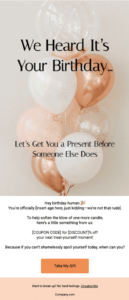
No better way to feel recipients feel special than wishing them happy birthday with this beautiful newsletter template. If your budget allows you to, incentivize them to purchase through a generous birthday discount or gift.
Design tip: Hit your subscriber’s heart with stunning and festive visuals. To add to the experience, write inspiring birthday wishes to warm up their heart. Do you have a birthday gift just for them? Make sure to make it your email’s protagonist using bold and/or large fonts and prominent CTAs to urge them to claim it.
Why you need it: Cherishing your audience’s special day goes a long way, so customize this birthday template to reinforce bonds.
Customer Anniversary Newsletter Example
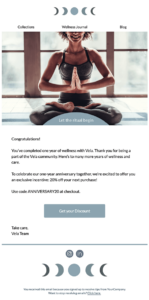
Anniversaries are key moments in every relationship. Customer anniversaries in particular remind your audience of how far they’ve come in their journey with your brand. So, give them a memorable experience with the above simple yet meaningful anniversary newsletter.
Design tip: Anniversary emails should feel heartfelt. So, again focus on personalizing your message by using the recipient’s name and including a sincere thank-you note. Even better if you add an exclusive discount to the mix and center the email design around it so it immediately catches the reader’s eye.
Why you need it: Use this straightforward template to share key customer achievements and reward customer loyalty.
10. Real Estate Email Newsletter Example
For realtors, creating effective real estate campaigns help you increase your listing visibility. To help you out, let’s share a great email template you can grab and customize in a jiffy.
Real Estate Listing Promotion Template

Promote your house listings using a clean email design that will intrigue future homeowners and make them click on your CTA buttons.
Design tip: Take advantage of the layout to display your best properties. Make sure to add relevant information and beautiful images to get your audience interested and lead them to your real estate landing pages.
Why you need it: Reach future homeowners and tenants with targeted home-listing recommendations and see your properties sell out like hotcakes. With the right email marketing software for real estate, you can effortlessly connect with potential clients and drive sales.
Set Your Email Newsletters In Motion
A fruitful email marketing strategy is made possible. You just need to take it one great email newsletter template at a time.
Now that you’ve seen them all, it’s time to hop into the editor and start customizing them as you please. Our advice is to choose templates that you like and add your own touch to make them more familiar with your target audience.
And before you leave, don’t forget to sign up for a free Moosend account. That’s all you need to become the email designer or your dreams.
You created your offer, sent your first promotional email campaign, and checked your results. It worked!
Your open rates looked solid, orders rolled in and your bottom line blossomed. And despite your list being small, your customers seemed as engaged as ever. The results made you think that you had the recipe for success. But as days went by, things leveled out.
You’re still sending campaigns. Still writing subject lines with care. Still watching the numbers. But the impact just isn’t the same. Your customers are quieter, and revenue just feels flat.
Sounds familiar? Here’s the truth: A stagnant email list will deliver stagnant results. In eCommerce terms, this translates to missing revenue, unhappy customers, and lost relationships.
At the same time, disengaged customers will grow tired of your brand, not open your emails, and, eventually, lose interest.
The key is to keep existing customers happy and grow your list with people who are truly interested in your brand.
So, how do you keep the spark alive? By creating value-driven entry points with intention:
- Targeted landing pages
- Subscription forms with lucrative messaging
- Personalized emails
However, your options don’t stop there. A segmented email list goes a long way, and product recommendation tools and customers’ own preferences can boost engagement and bring in more leads.
Engaging with intention is, of course, easier said than done. So, let’s break down the core strategies.
Growing your audience
There are plenty of methods that highlight the value of email marketing strategies that “fuel your growth.” But what are the ones worth implementing when you’re trying to grow your audience—both in terms of new leads and in terms of re-engaging old customers?
Promotional landing pages
Imagine you’ve decided to run a limited-time offer—perhaps a seasonal sale, or early access to a new product drop. Your announcement plan will definitely include a dedicated email campaign. But is that all there is?
Your promotion needs a “home.” A place that customers—existing or potential—can stumble upon and explore your offer.
Creating a standalone page that exists for the sole purpose of converting users makes the offer more legitimate and more accessible. A landing page is easy to find and contains essential information, if designed correctly.
To make your landing page effective, keep it focused and friction-free. Try to minimize distractions. Like this:
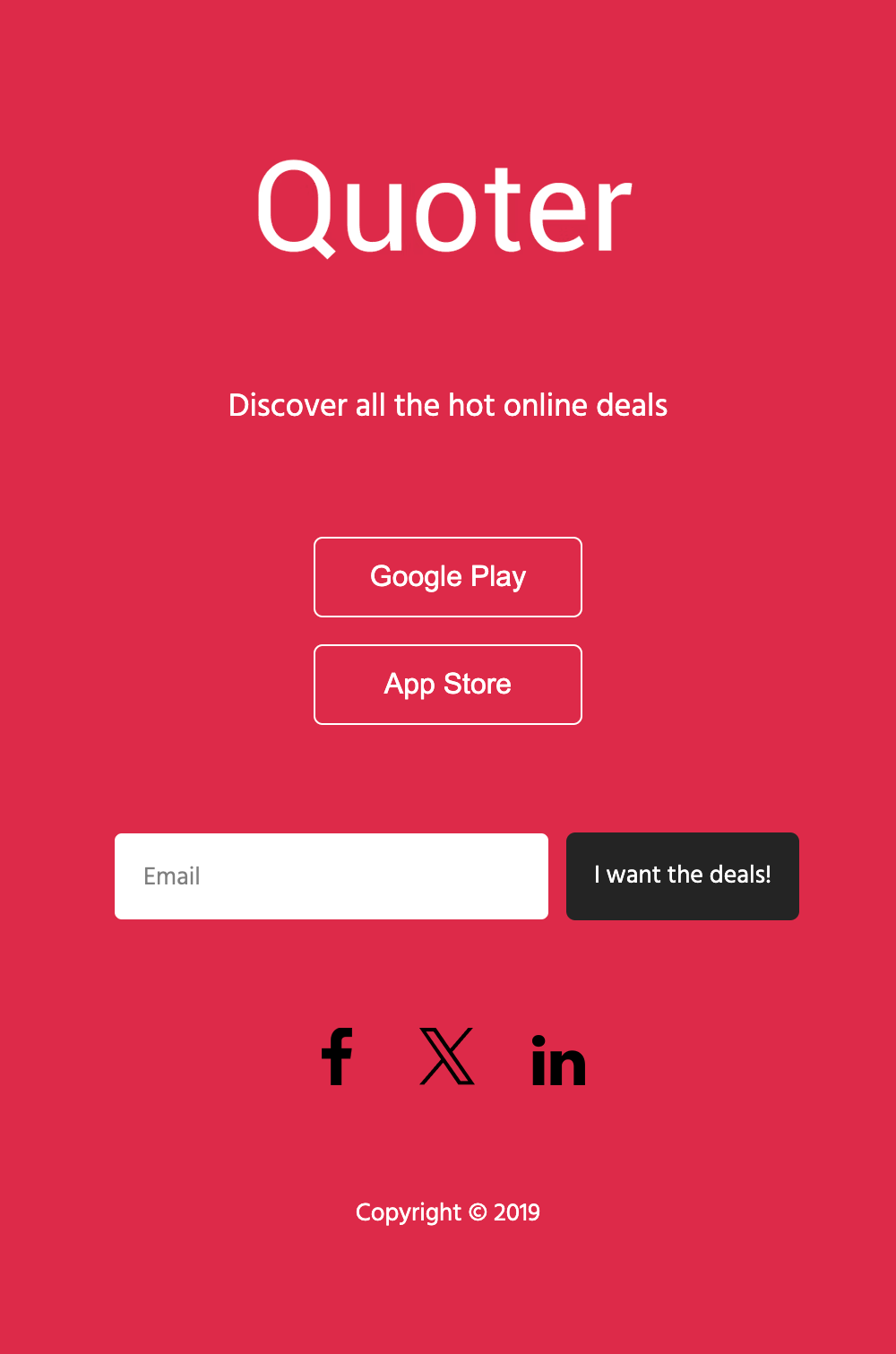
This landing page template is distraction-free, showing only one action. To tighten the focus:
- Highlight one offer or promo.
- Don’t use secondary offers.
- Remove unnecessary buttons like social icons and navigation menus leading people away.
Your objective is for customers who stumble upon your page to stay there and interact with your offer.
One of the core landing page best practices is a clear and concise headline. What is your offer? Why does it matter? Include a subtext that adds more context.
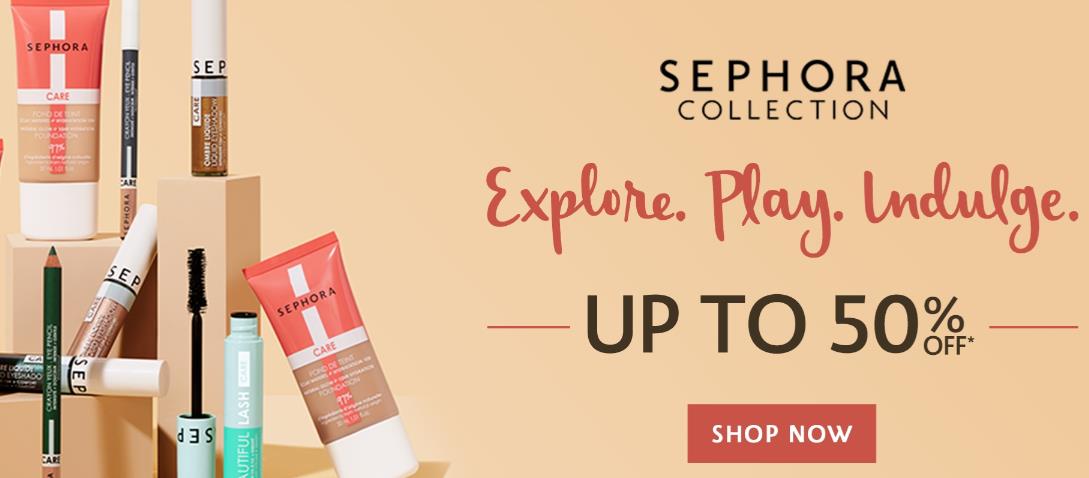
(Source)
In Sephora’s example above, the cosmetics brand plays with actionable verbs. “Explore. Play. Indulge.” The “Up to 50% off” line is the subtext that adds context to the action and tells the customer what they’re going to get if they act on the headline’s message.
Sephora also uses one CTA. “Shop Now.” There are no doubts on what comes next, just a high-converting action.
Lastly, the visuals support, not distract: There is a product photo that reinforces the offer and adds clarity, showing what the offer entails—only Sephora products from the branded collection.
Taking away from that example, here’s what to do:
- Avoid creating a generic landing page. Your promo deserves a purpose-built environment.
- Use visuals that show customers what is included in your offer and avoid unnecessary product pictures.
- Don’t use too many words. Make sure your copy is actionable, and your verbs naturally lead users from one step to the next.
Finally, make sure the landing page is mobile-first. A lot of customers see landing pages on their phones. If your form is buried or buttons are too small to tap, you’re leaving signups on the table.
Tip: If your offer is gated—a discount for subscribers, for example—make your landing page’s form your focal point. Once they subscribe to your email list to get the offer, launch an email sequence that aims to nurture. Deliver the discount code with the first email of the sequence.
Capture attention. Turn it to action.
Create landing pages with templates that look good on every device.
Start FreeAttractive subscription forms
A subscription form that’s stuck in your website’s footer might not be enough, if you want to grow your list. Instead, treat your forms like mini campaigns that come along with their own purpose and goals.
Let’s start by identifying what will draw your customers’ and prospects’ attention:
- Gated content. Create an eBook with the latest trends in your eCommerce niche like “Spring Decoration Trends,” a lookbook, or a curated product quiz, like “What’s the best shampoo for your hair type” that leads to personalized recommendations.
- Exclusive perks. Don’t urge prospective customers to “sign up for 10% off.” Instead, you can get more creative and offer VIP-only access to limited edition releases or loyalty points on signup.
- Exit-intent popups. Show a clean form with a small incentive just when the user is about to leave your website.
Your subscription form can have various placements, depending on your intention:
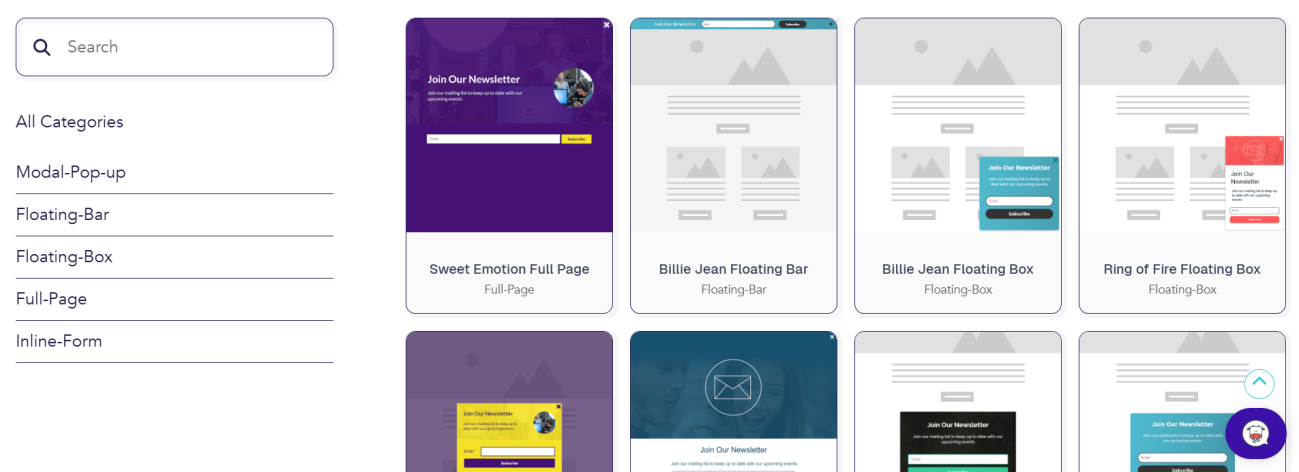
If you want your form to stop users in their tracks, you can use a full-page form, an inline form, or a modal pop-up that you can set to appear at a specific time interval, preferably when the user is already engaged.
If you prefer to be less intrusive, then a floating bar or a floating box will suit you better, as it will follow your customer discreetly as they scroll.
Of course, form placement matters too. You can use subscription forms on your “Contact Us” page, inside blog posts—especially evergreen with high organic traffic—, or your post-purchase flow, provided the users have purchased but haven’t signed up for your email list.
Tip: You can use Moosend’s tags to segment users according to signup form. If a prospect signed up through an “early access” form, tag them accordingly. When the drop happens, send an email with “Here’s your private link.” That small touch drives both trust and urgency.
Segmentation that creates loyal customers
Landing pages and subscription forms are two great ways to get the sign-ups in and grow your audience. But what about tailoring content to their liking and boosting loyalty?
This is where segmentation comes into play. You could think of segmentation as the bridge that connects new leads and brand loyalty.
Start by using Moosend’s segmentation templates that offer a wide variety of actions:
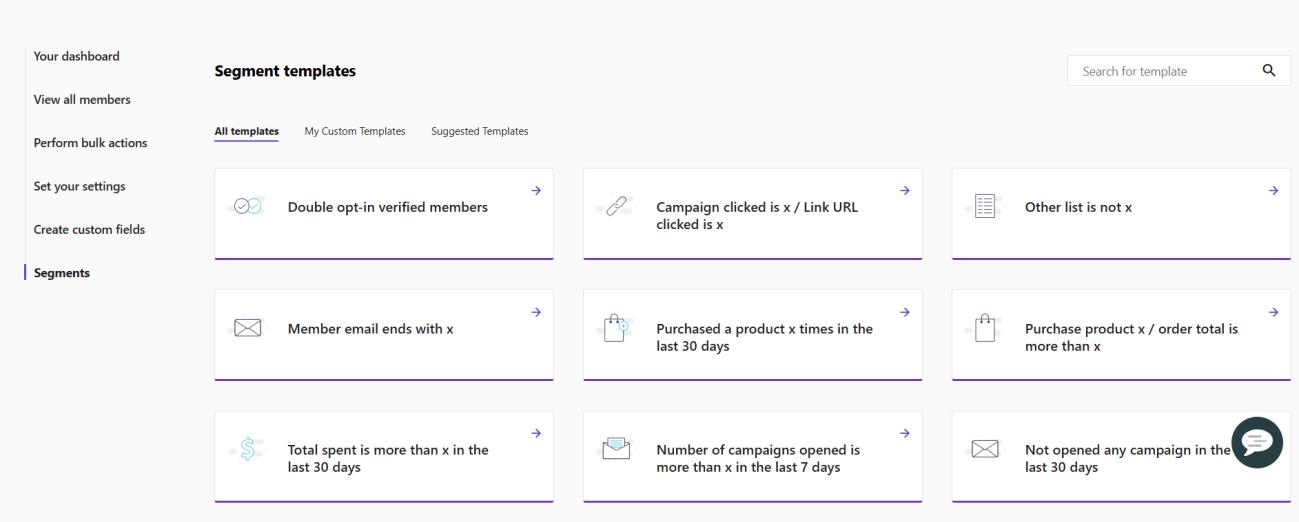
You can segment eCommerce customers based on various actions. For example, based on the campaign or link that led them to your website, products they purchased, or even amount they spent in the last 30 days.
Let’s say that you run a special promotion. John and Jane both purchased items through that promotion. John was a first timer who came to the promotion through a social media link, while Jane is a repeater who has purchased items again in the past month.
John will need to be educated about your brand and products and nurtured further down the funnel. Jane, on the other hand, will need to see more value. This means you’ll need to serve different emails to each of them.
If you want your segmentation to be more granular, here’s an advanced tip: Create a custom segment. For example, if a user has purchased twice in the last month and referred at least one friend via a referral form, move them to an ambassador segment.
From there, trigger emails offering early access to collections in exchange for social shares or feedback.
With segments in place, your messaging can actually mean something to each person receiving it. No batch-and-blast, just targeted emails that are hard to ignore and feel natural to open.
Engaging your audience
We went through the ways that can grow your audience. Now, it’s time to keep them interested and turn that interest into consistent revenue.
Once someone’s on your list, every email you send either builds the relationship or weakens it. That means engagement can’t be treated like an afterthought. It needs structure.
Here’s how to make your emails feel timely, relevant, and worth opening.
Personalized emails that convert
Personalization is more than just a “Hi [First Name].” Email platforms, like Moosend, allow you to get more specific than that. True personalization is about relevance. The more tailor-made campaigns you send, the less likely they are to get ignored.
You can start off with custom fields. Custom fields are fields that carry more intimate information—like a birthday or an anniversary date. To create them in Moosend, just access your email list, click on the “Create custom fields” to your left, and then the “Add New” button. From that point on, you can gather any type of information you want, to craft a campaign that matters:

If there are pieces of information that you think are important to have, toggle the “Custom field is required” to “On.” That way, prospects will be able to subscribe only if they share that information.
Let’s see an example of that.
You’re creating a campaign for a specific product category interest—in our example, it’s skincare. Your custom fields indicate that some users are interested in skincare bundles, whereas others are after single products like moisturizers or cleansing balms.
Your next campaign should center around this. Customers interested in bundles can receive an email with tips on usage of a full skincare routine, whereas those interested in single products can receive useful combos.
Conditional visibility is where things get sharper. Let’s add to the example above.
Instead of using a custom field for each email, you can use the conditional visibility block. This block is an element of your email newsletter that you can show to or hide from specific audiences. Like this:

By adding a visibility condition, you can show exclusive discounts on the skincare bundles by including the corresponding custom field and hide it from audience members that are interested in other products.
To kick things up a notch, connect your personalization to customer behaviors that stem from real data. If someone added moisturizer to their cart 30 days ago, they are sure to run out. Send them a replenishment email to remind them of the fact.
Use a subject line that highlights their need, like “Down to your last drop?” or “Restock on moisturizer before you run out.” This is a high-intent nudge that works because it’s grounded in data, and not a generic hypothesis.
Product recommendations that drive revenue
Promoting your products is what eCommerce email marketing is about. But that doesn’t mean that you should go for generic promotions.
Product recommendations shouldn’t feel like fillers. They should feel like the natural next step in the buying process. Which is what they are, when done right.
Moosend makes this easy by letting you add dynamic content blocks that serve a real purpose. You can recommend items based on what customers are already buying or have already purchased, items they spent time browsing on your website, or your best sellers.
Connect the right item to the right customer with dynamic content blocks. Here’s how you can use them with intention:
- Create a product recommendations block for customers who browse specific items often, or those who purchase perishable items on specific time intervals.
- Cross-sell with relevance: Promote heat-protectant spray or a diffuser attachment to customers who bought a hairdryer.
- Send a curated email showing related items to customers who bought a specific product more than three times.
Let’s say that you want to send an email with product recommendations. You can use your favorite Moosend eCommerce template and choose “Product Recommendation” from the layout options:
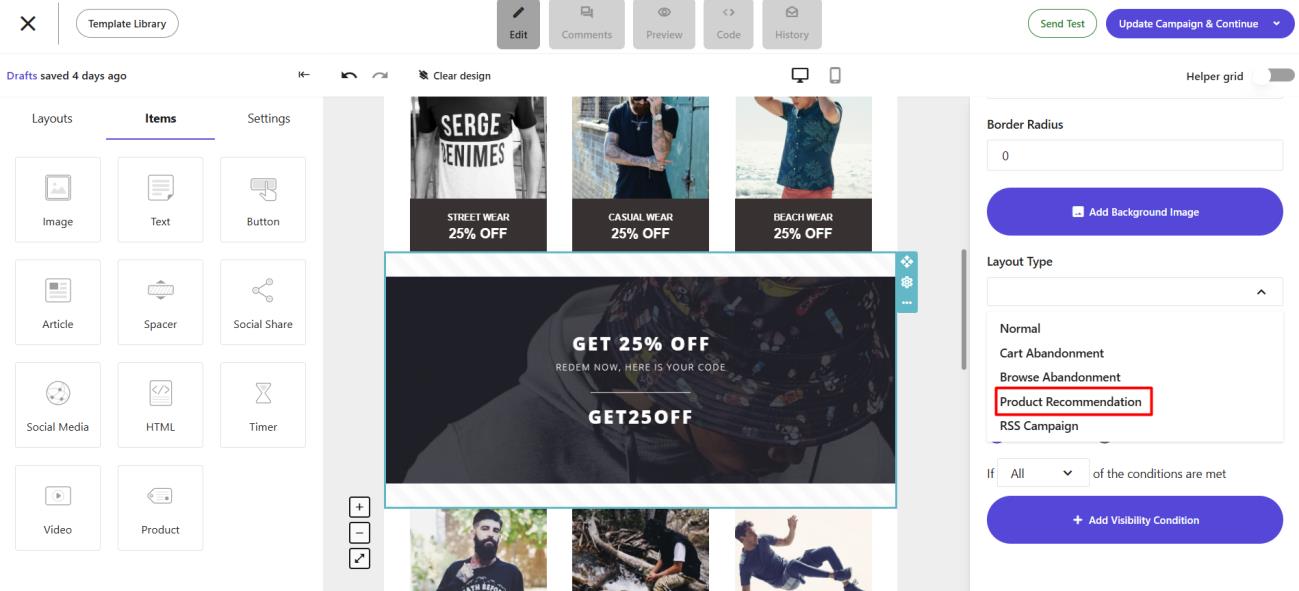
After that, the process is easy and intuitive. Just select the website you have connected to Moosend and the number of products to be displayed. Your recipient will automatically see recommended items based on your selection and their behavior on your website.
Kick it up a notch by promoting products that are frequently bought together. This works especially well for your cart abandonment or post-purchase emails.
Ready to kick it up a notch? Connect your inventory to the platform and send a “Selling fast!” email to users whose behavior indicates that they’re interested in something but not interested enough to buy.
For example, if a customer has viewed a leather jacket multiple times—or even has added the item to their cart and then abandoned it—, send an email with the number of items left in your inventory. This is an informed nudge that sparks urgency and leads the recipient to completing the purchase.
Let users set their preferences
Asking about user preferences isn’t just courtesy. It’s a strategic move that can reduce unsubscribes and increase engagement. Using a preference center can help you understand what users want to see—and when—eliminating all the guesswork.
Moosend, as well as various other email tools, let you hand that control over to your subscribers without complicating your workflow. Here’s how:
- Decide what data matters. Do you want to give subscribers a say in how often they hear from you and the type of content they should be expecting?
- Use the insights you’ll gather to create fields. For example, you can ask “Which of our emails do you want to receive?” or “How often would you like to hear from us?”
- Build your landing page using your favorite Moosend template. Make sure the user flow is clear—update preferences, hit save, done.
- Link to your preference center in every campaign footer. Or go further and send a dedicated campaign asking subscribers to update their info. You can even embed the link on your website or post-purchase pages for more exposure.
Using the preference center isn’t just about collecting data for the sake of it. Data only matters when you put it to work. It builds trust and reduces unsubscribes. Your audience gets more control. At the same time, you get actionable insights that improve your segmentation and eCommerce email strategy going forward.
Take this for example: A customer signs up for your newsletter. They select skincare—as per our example above—as their primary interest. This can help you tailor your next campaign accordingly by highlighting your latest moisturizer line and sharing tips for the perfect skincare routine.
The customer opens the email, sees the moisturizer and skincare tips, clicks through, and adds the product to their cart.
Their simple preference turned into a personalized experience. Which can turn to measurable engagement and a boost to your bottom line.
Tip: Add your preference center link in your welcome flow, but don’t ask for too much upfront. Let the first email build some value, then follow up with:
“Tell us what you’d like to receive. We’ll only send you emails that are relevant.”
This helps you collect high-quality data without tanking conversions at signup and keeps engagement going beyond the initial nurture sequences.
Countdown timers and a “Wheel of Fortune” for extra engagement
When used strategically, interactive elements like countdown timers and “Wheel of Fortune” popups can push engaged users to act faster. But they must be relevant and well-timed.
Let’s say that you’re running a Valentine’s or Easter promotion like a flash sale or an early access offer. What’s the best way to capture a prospective customer’s attention than a countdown timer?
Including it into your email’s design is easy and intuitive. Just pick your favorite template and choose the “Timer” from the “Items” menu, drag it, drop it, and you’re good to go.
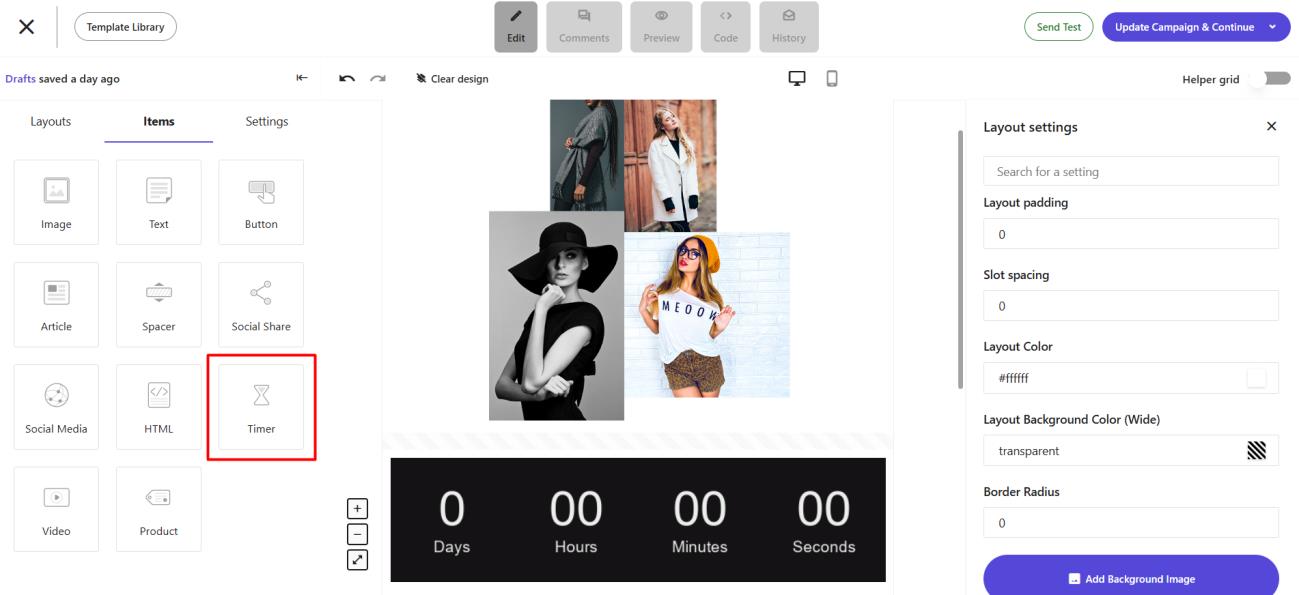
A countdown timer gives customers a visual cue on how long a deal will last. It’s fun and straightforward, but it doesn’t come without rules:
- Use timers only when the offer really has a deadline. Don’t fake urgency.
- Keep the offer simple and visible above the fold. No one should have to scroll to understand what’s expiring.
- Match the timer’s expiration logic to your actual campaign end time.
Besides countdown timers, you can boost engagement with interactive elements like Moosend’s “Wheel of Fortune.” This element can work well during promotional periods when your goal is lead generation or reactivation.
Used sparingly, they offer a low-friction way to exchange fun for function. Customers interact with the element, and you get a signup or a conversion.
Here’s where you can use it:
- High-traffic landing pages
- Re-engagement flows for inactive users
- Seasonal campaigns like “Spin the wheel for a Valentine’s Day discount”
To keep your “Wheel of Fortune” aligned with your brand, make sure to follow some best practices:
- Customize the messaging. Avoid default language like “Try your luck!” unless it fits your tone.
- Limit the rewards to one or two real incentives like “10% off” or “Free shipping” so it doesn’t feel gimmicky.
- Use it selectively. This works best as a moment of surprise, not a default experience.
Tip: If someone spun the wheel but didn’t redeem their code, trigger a follow-up email with that exact offer and a subtle reminder. If they redeemed their offer, on the other hand, exclude them from future spins to avoid fatigue. This gives you control over the experience and keeps users on their toes.
Growth and engagement are methodical, not magic
Growing and engaging your email list doesn’t require guesswork. It requires intention.
Create value by making your offers visible, your messages relevant, and your customer experience frictionless. That means well-placed landing pages that feel like natural entry points. Subscription forms that speak directly to what your customers want. Segmentation that makes every email feel personal. And engagement tools that feel like a seamless extension of your brand, not a marketing trick.
When done right, email becomes more than a channel. It becomes your most valuable growth asset.
